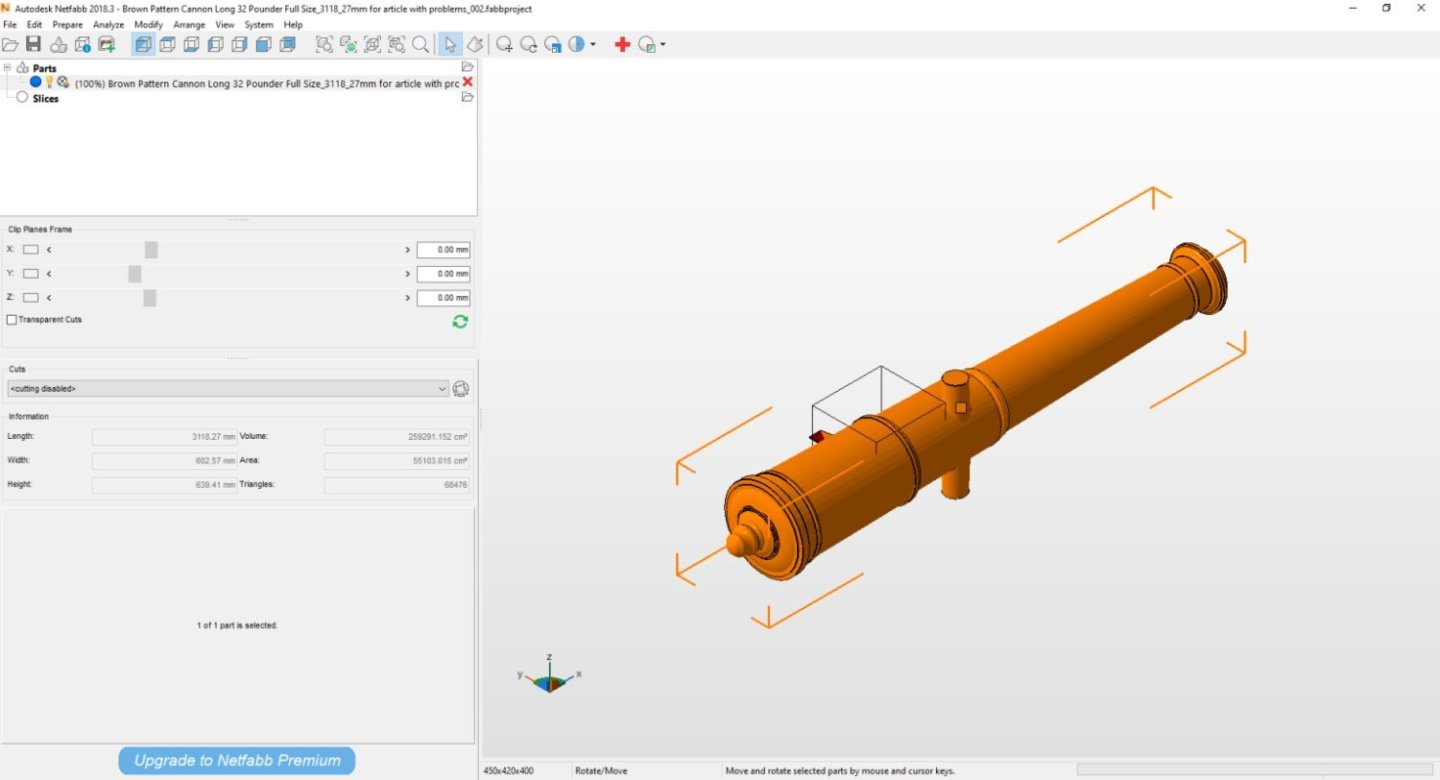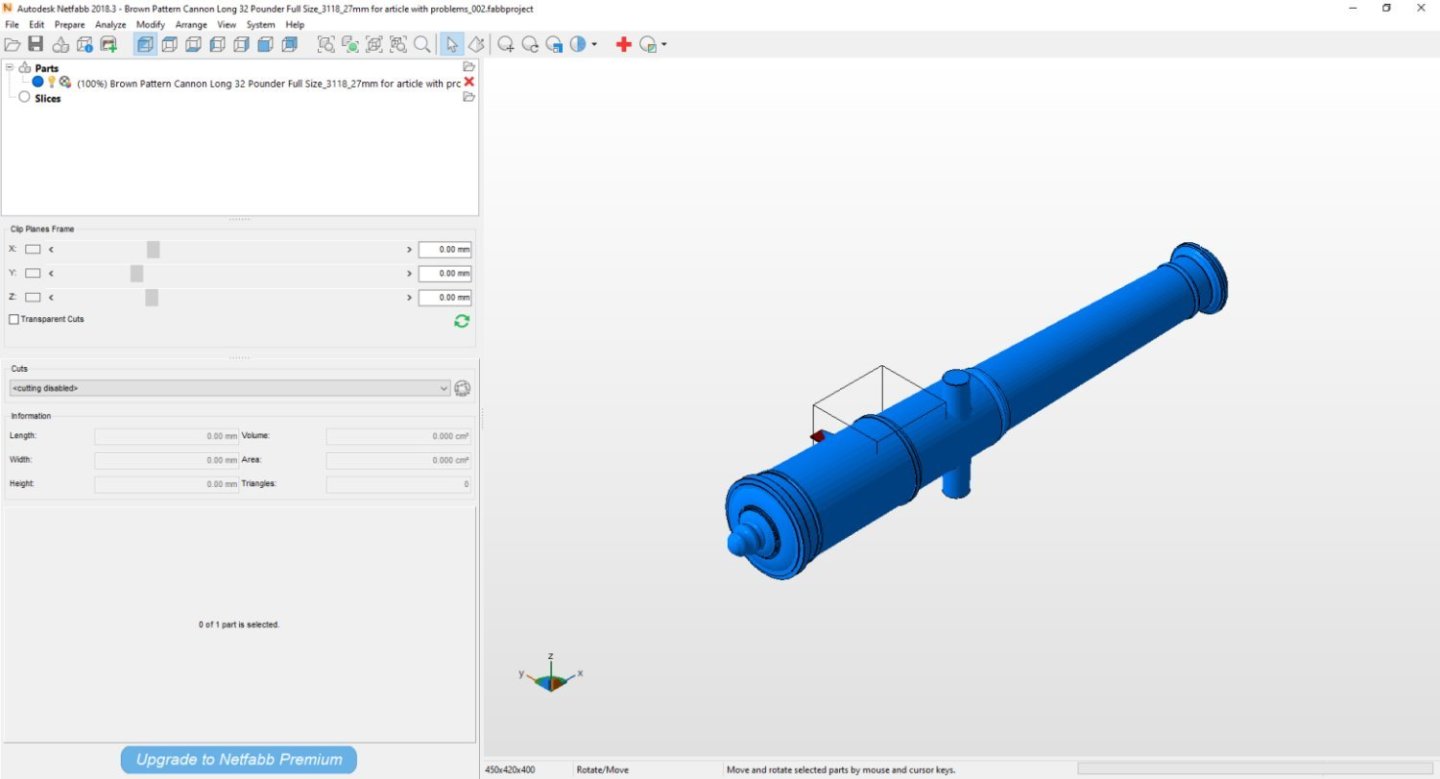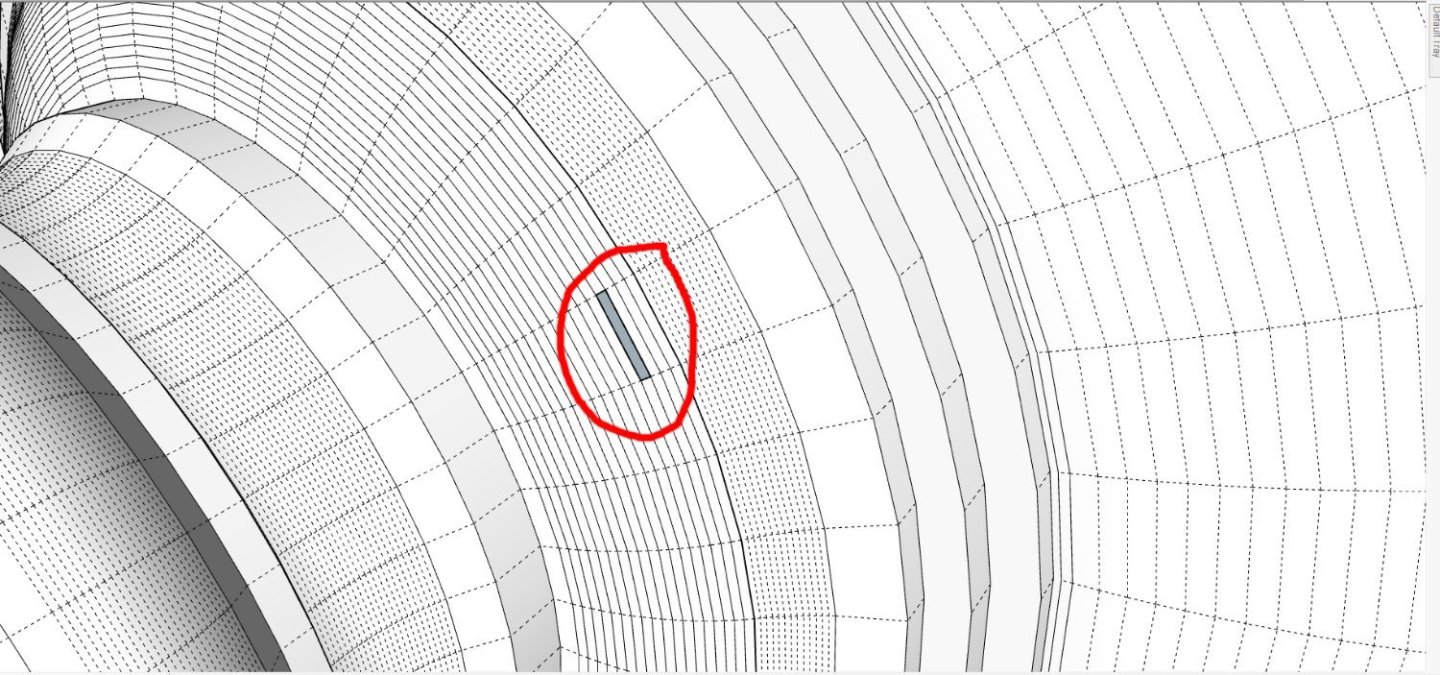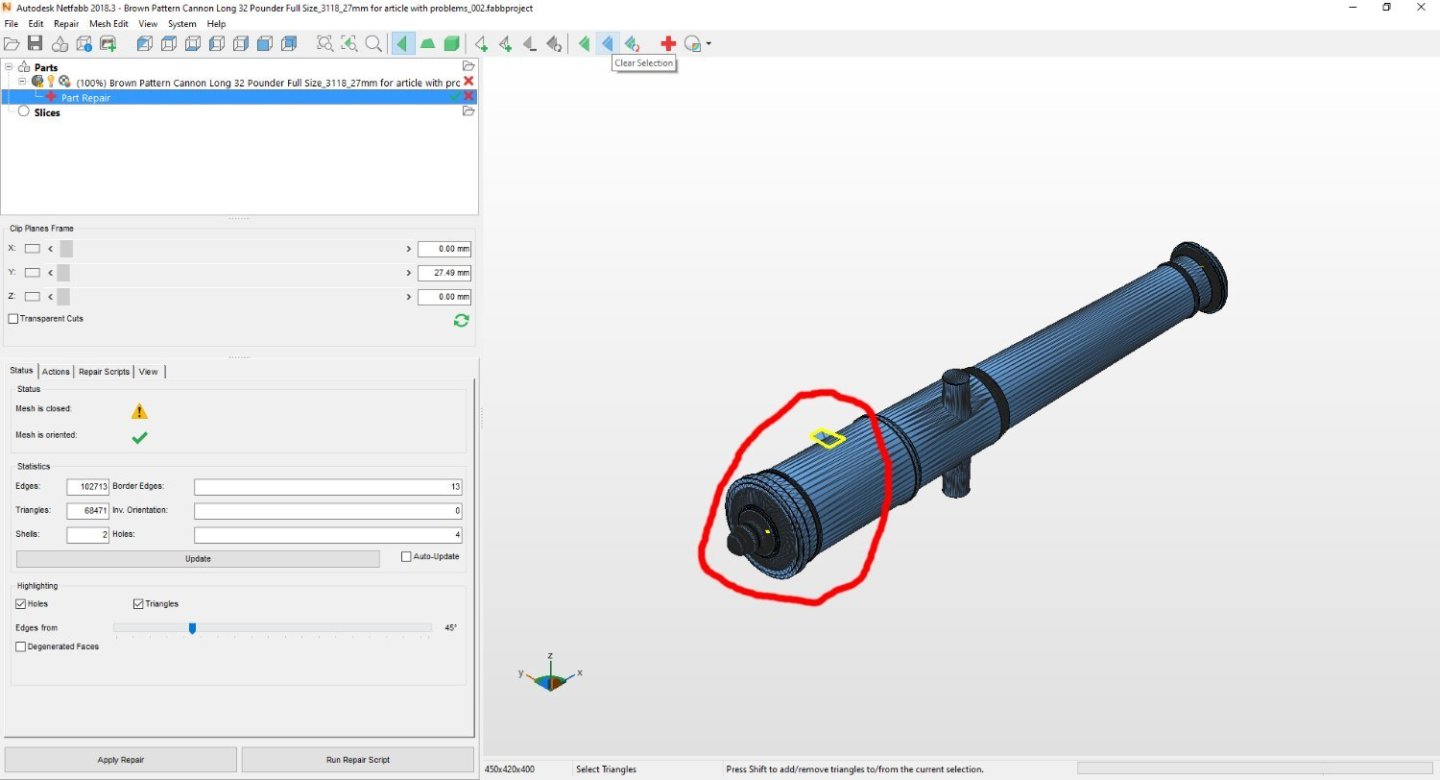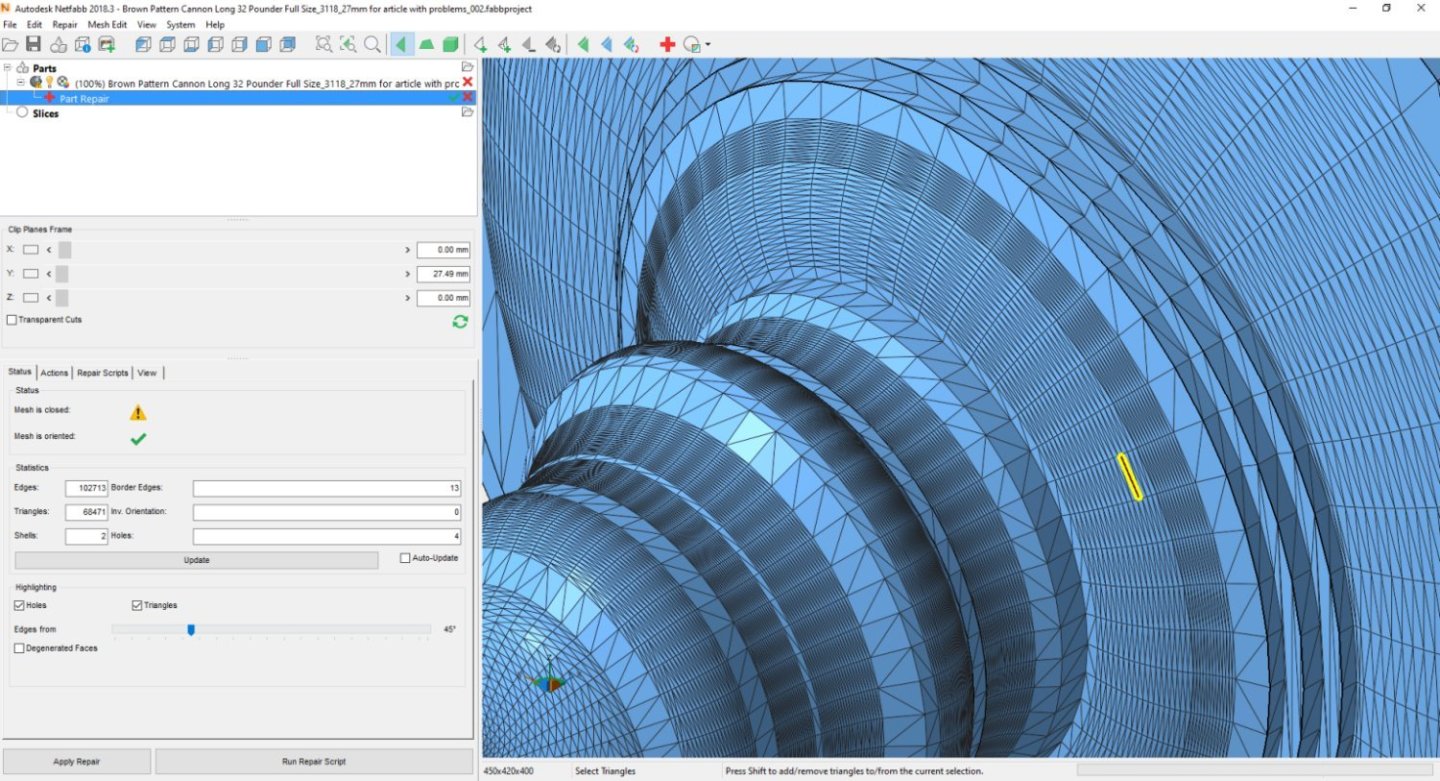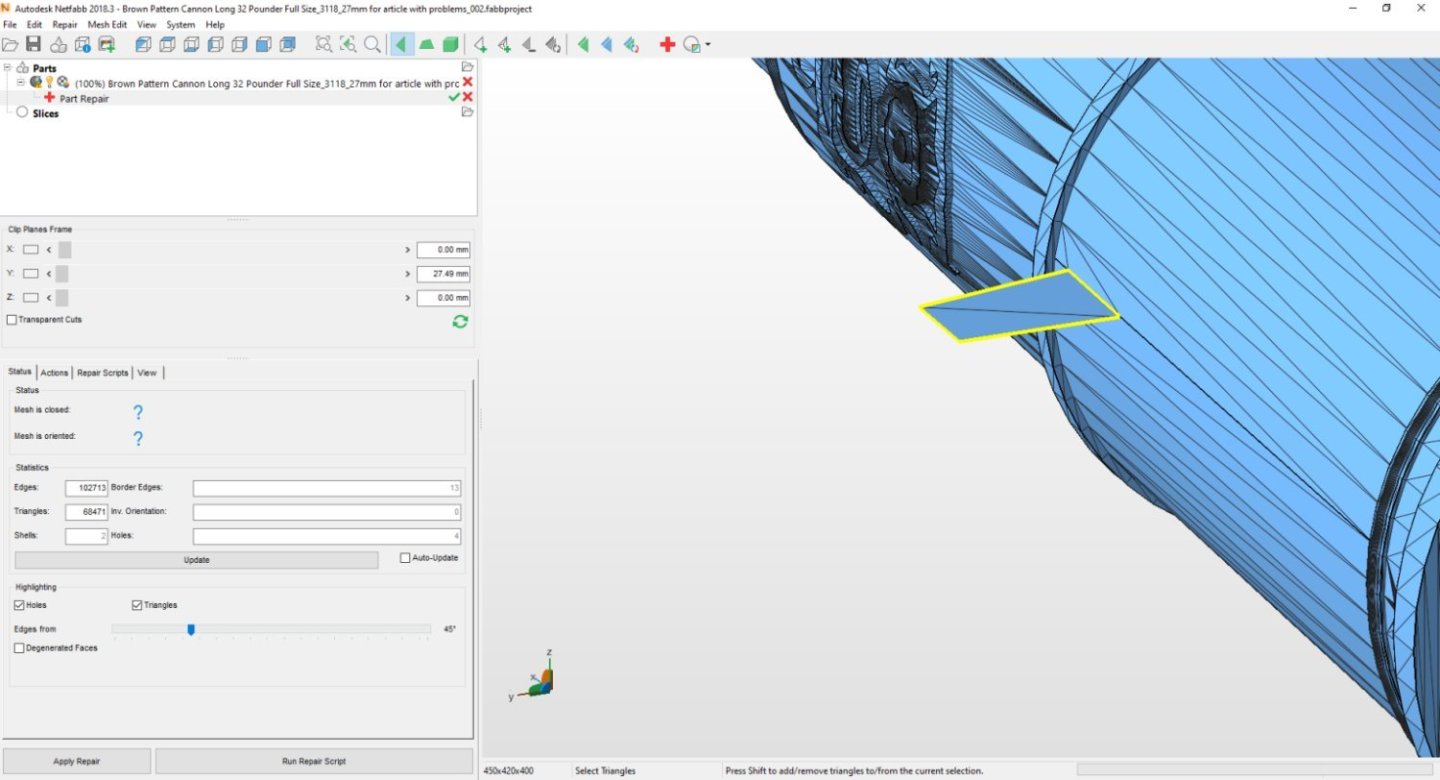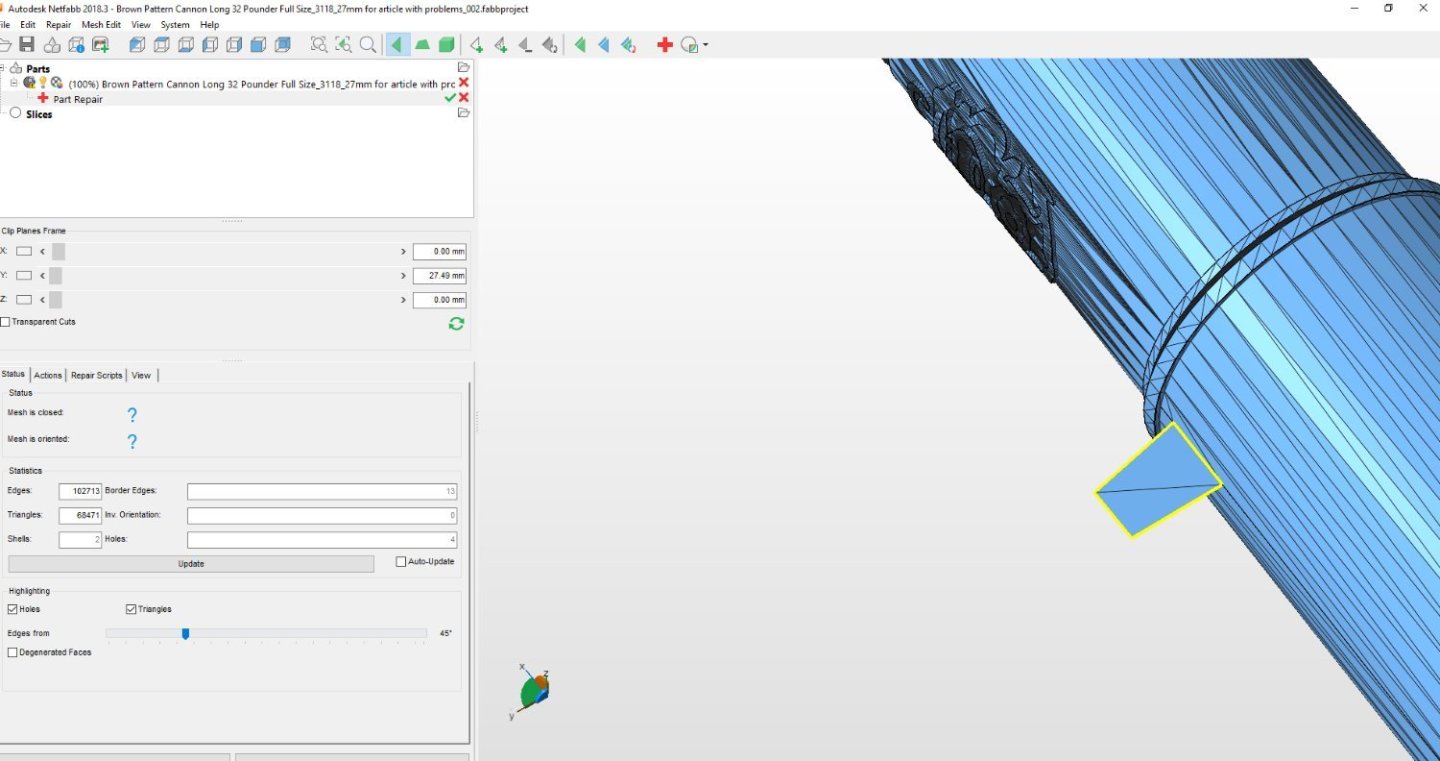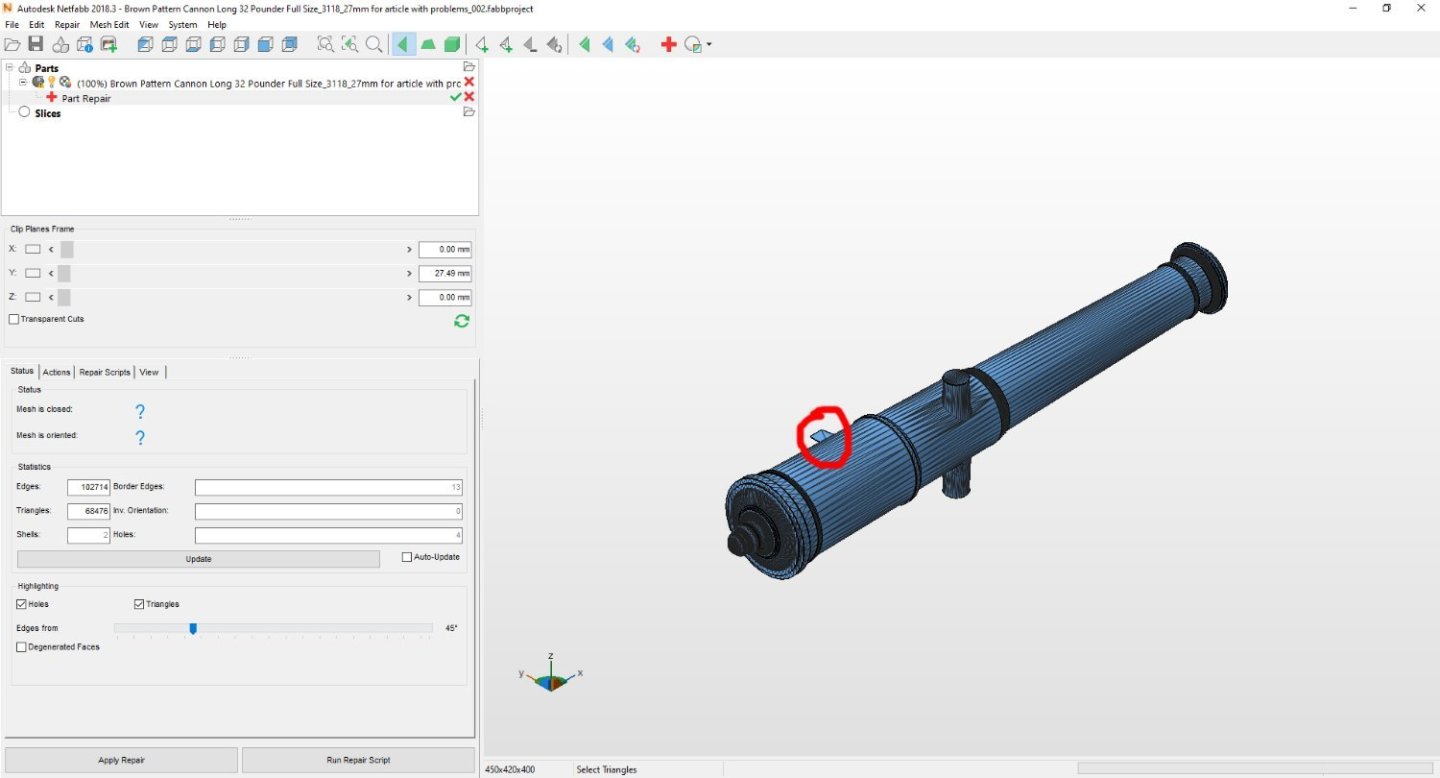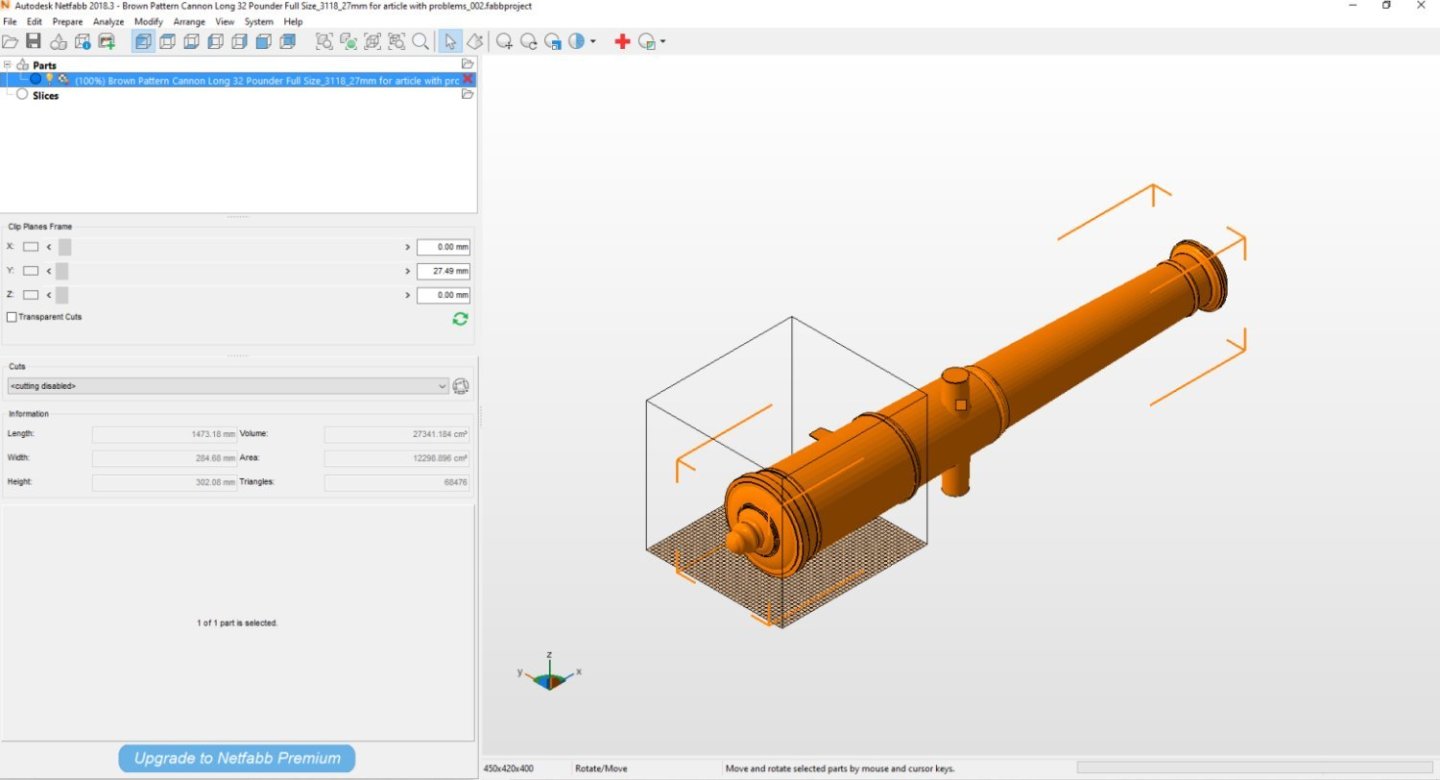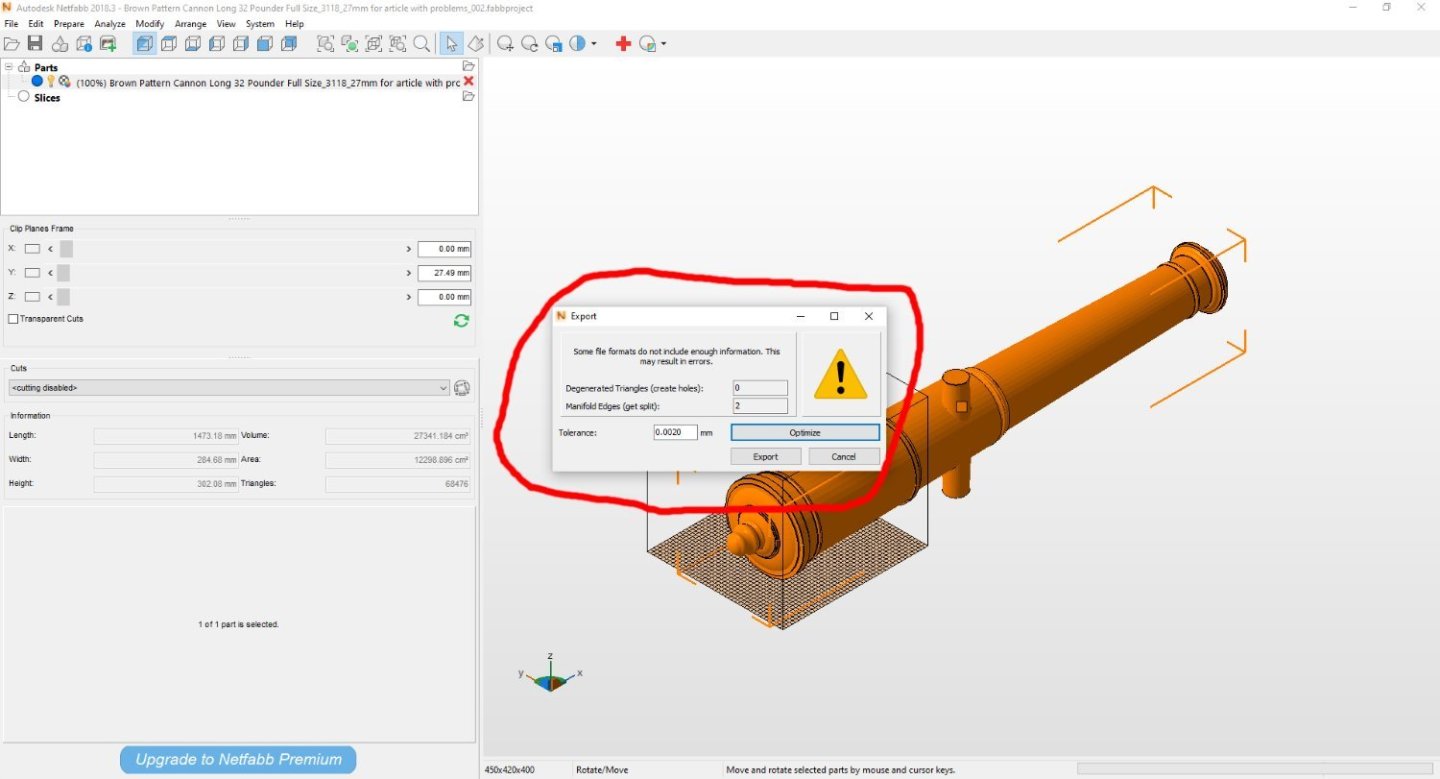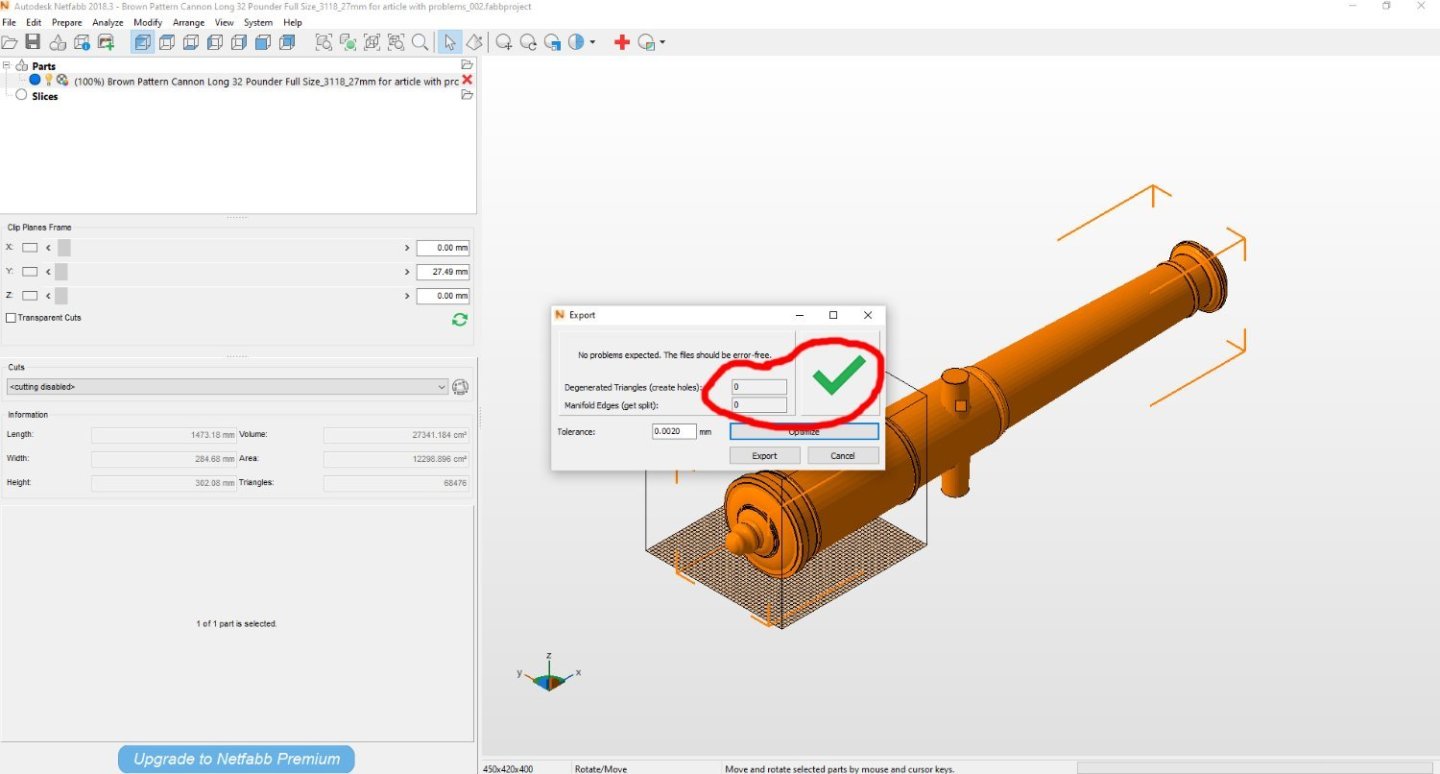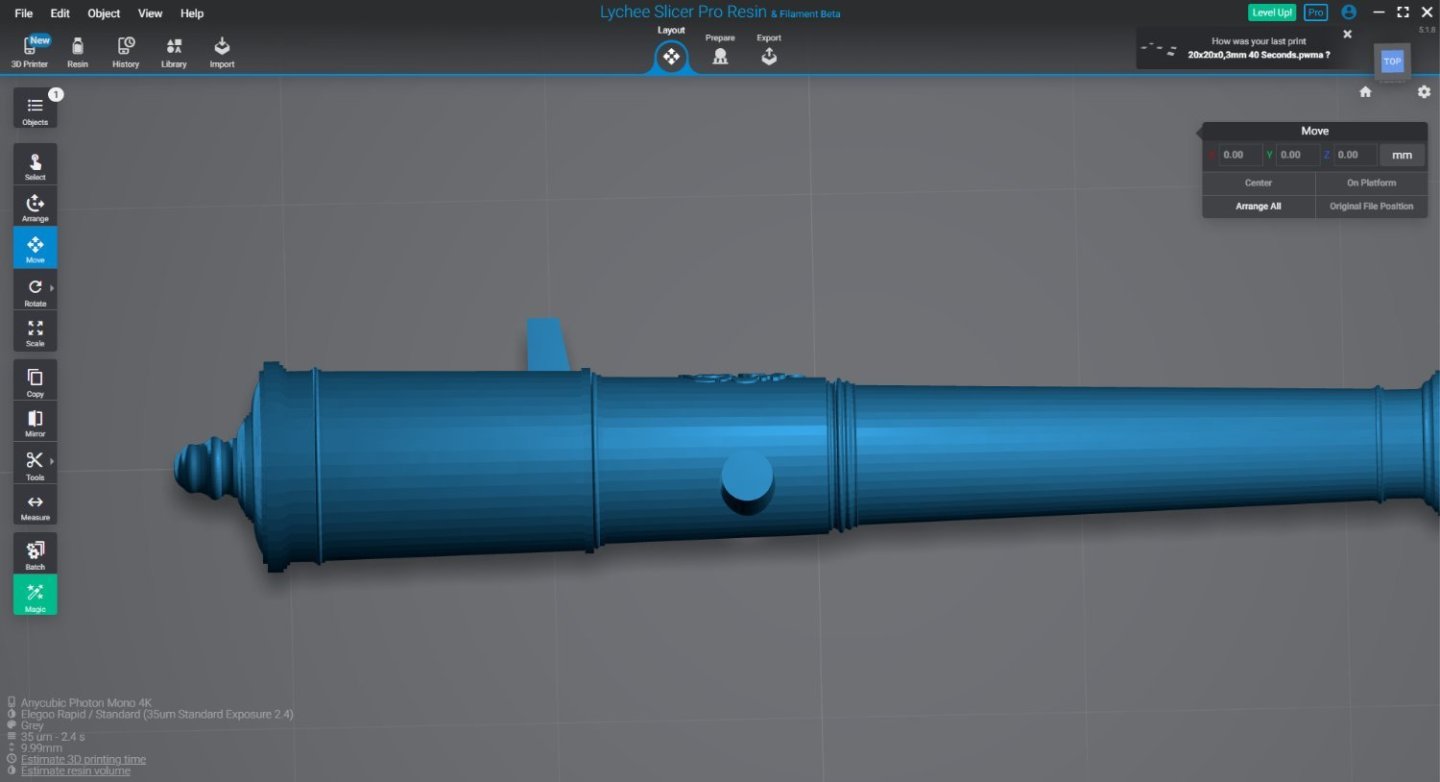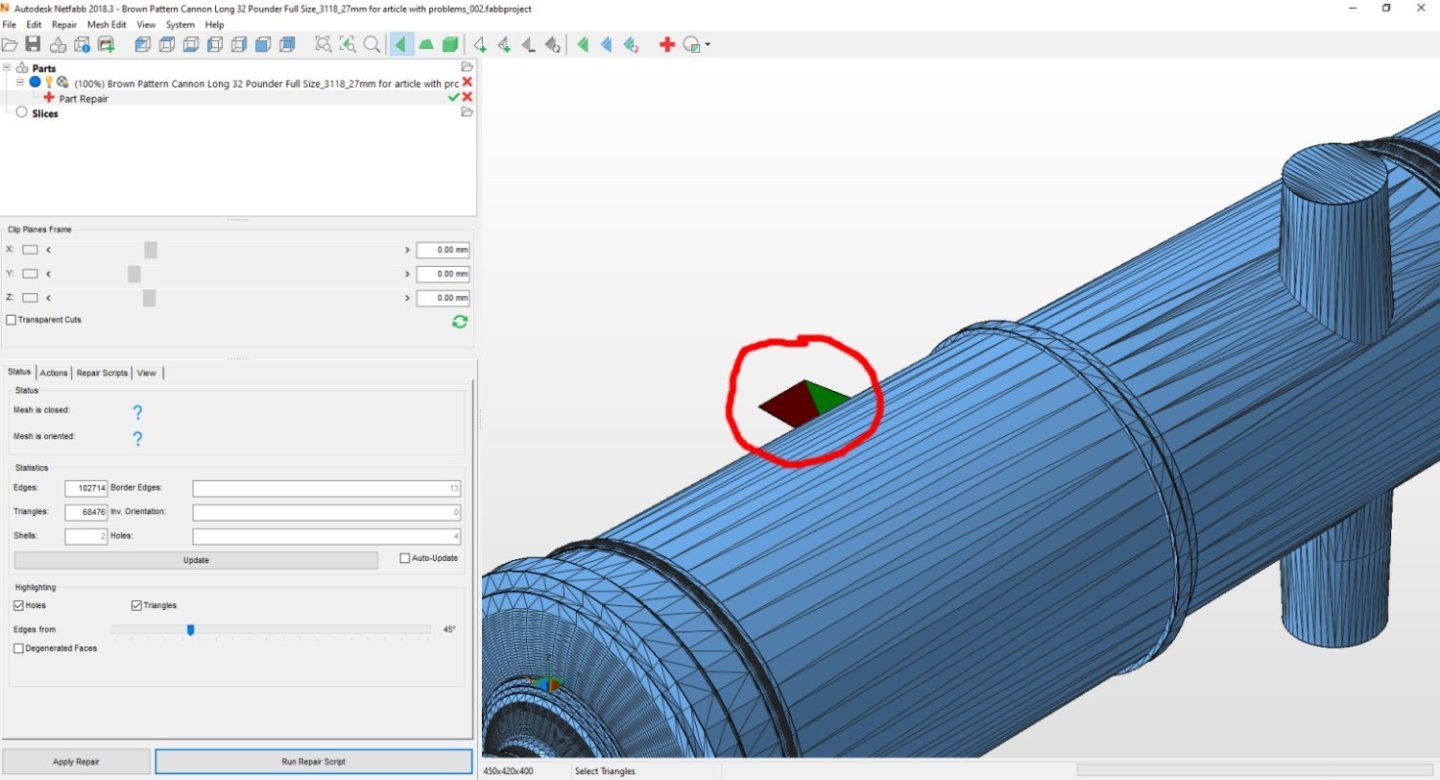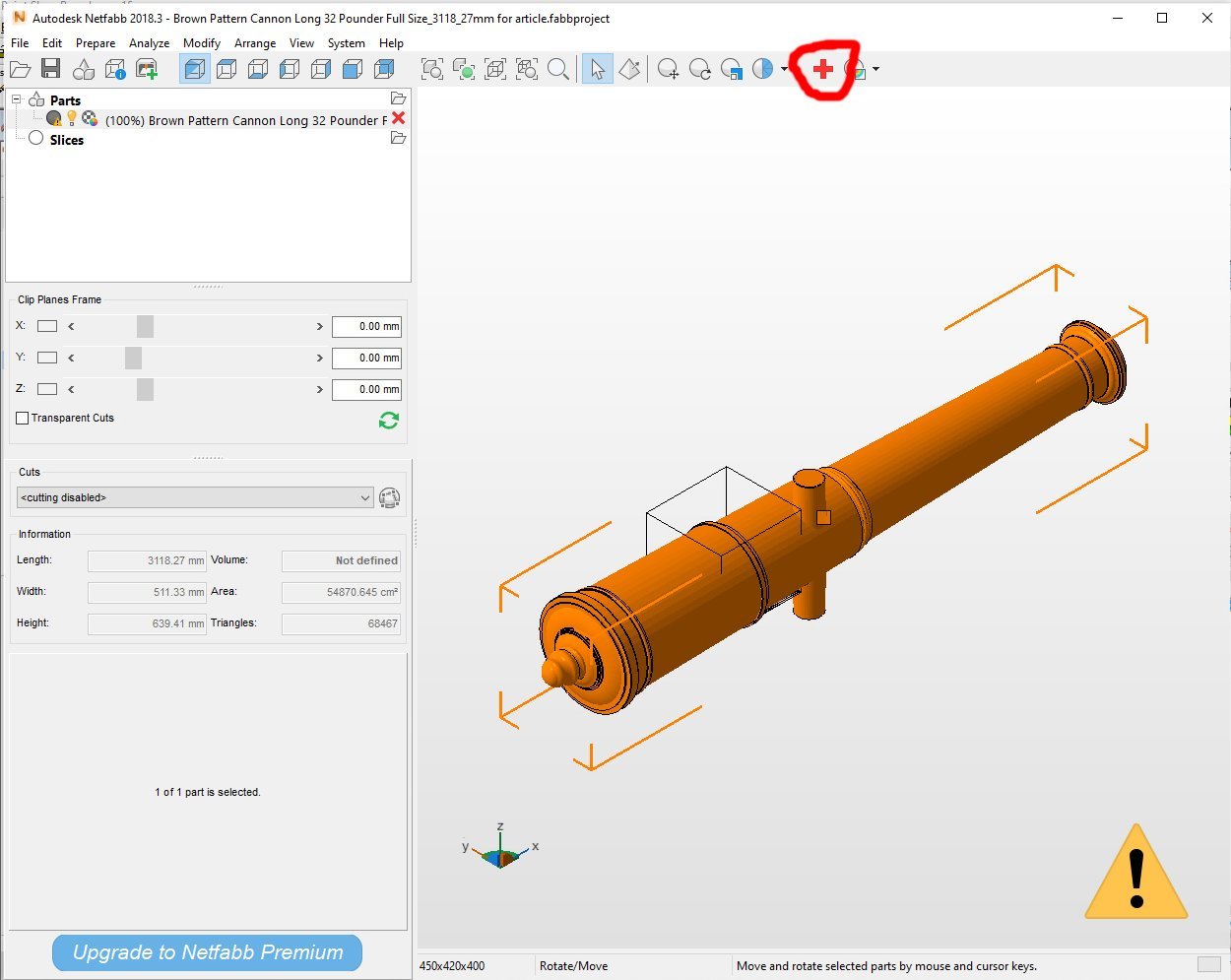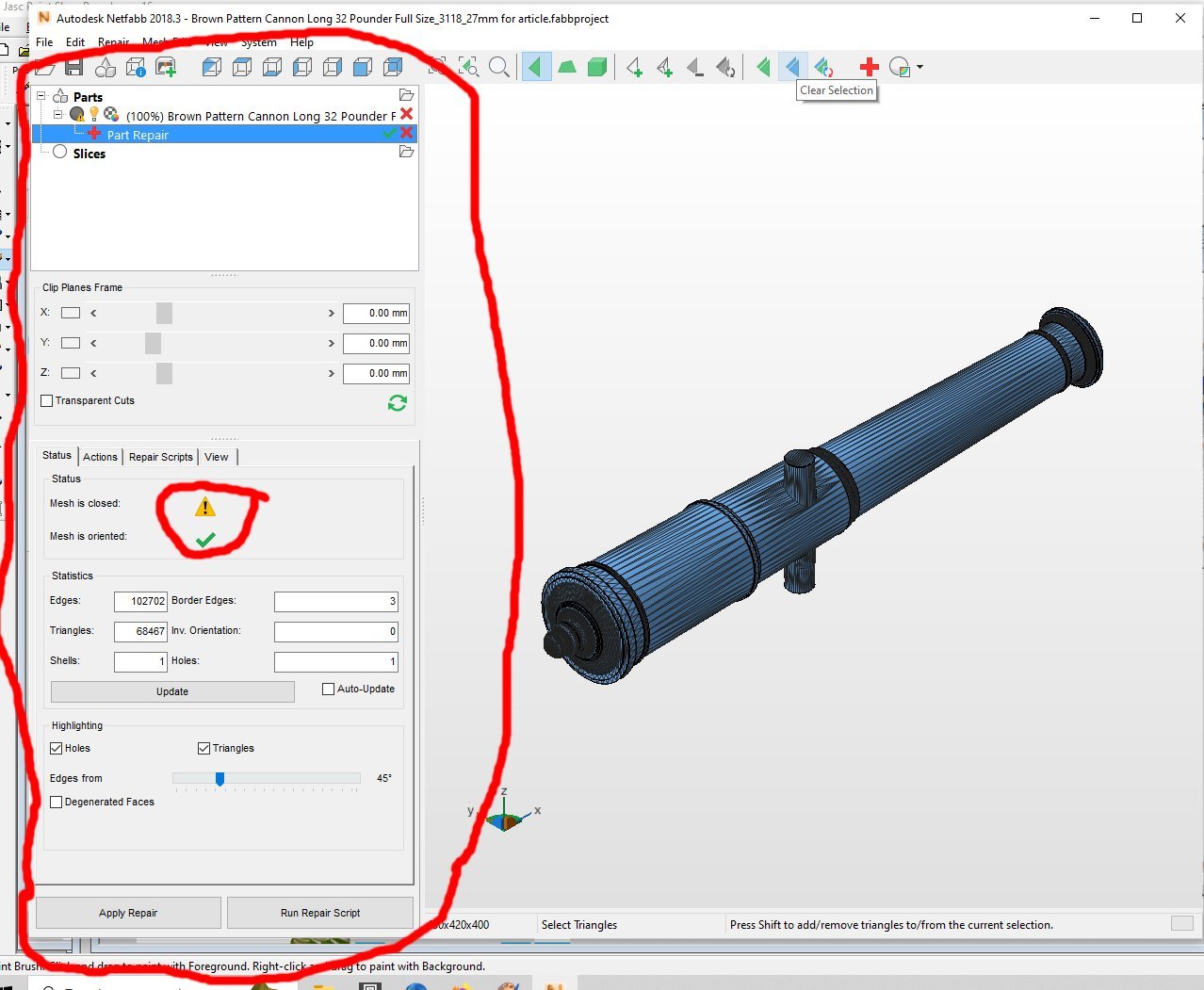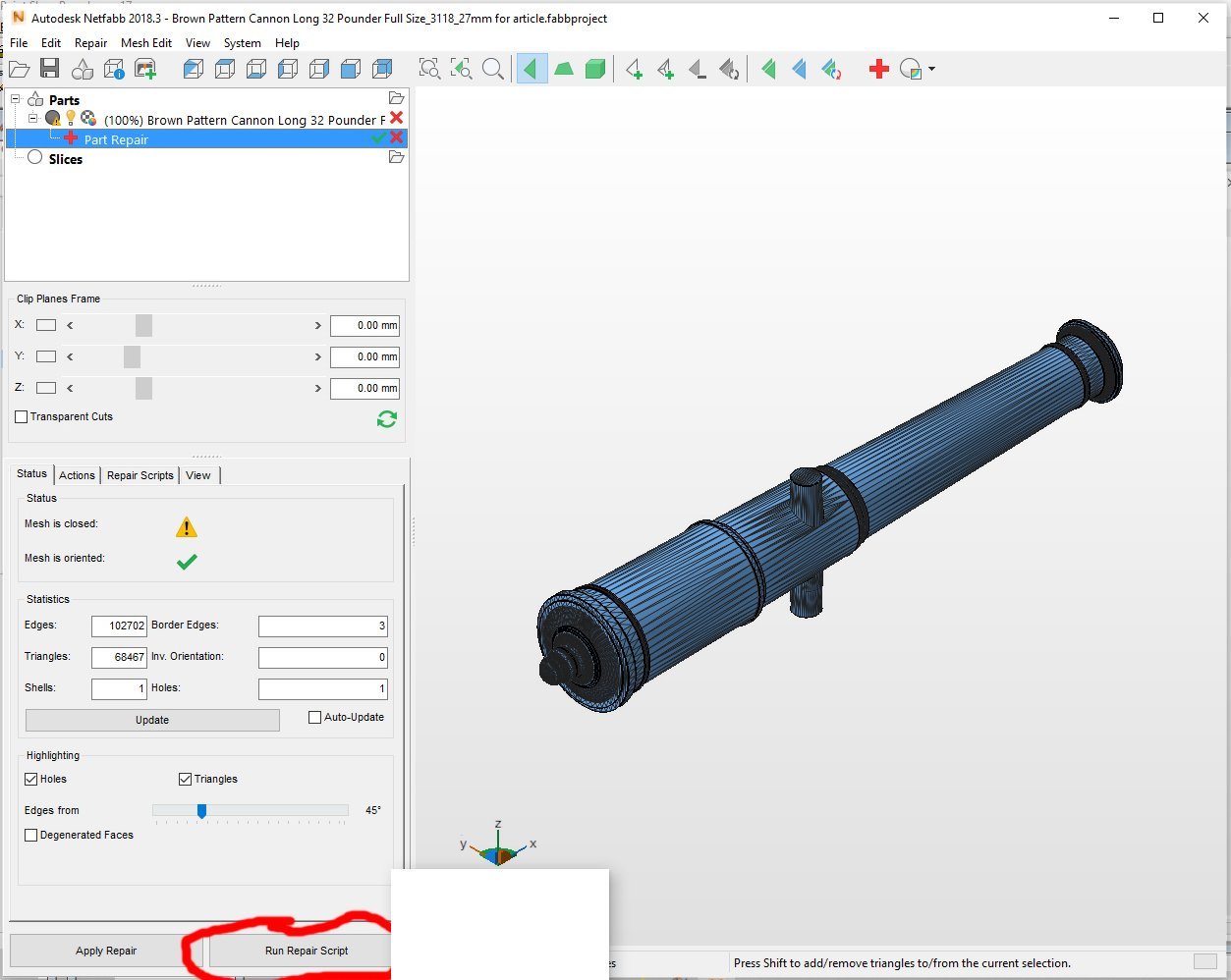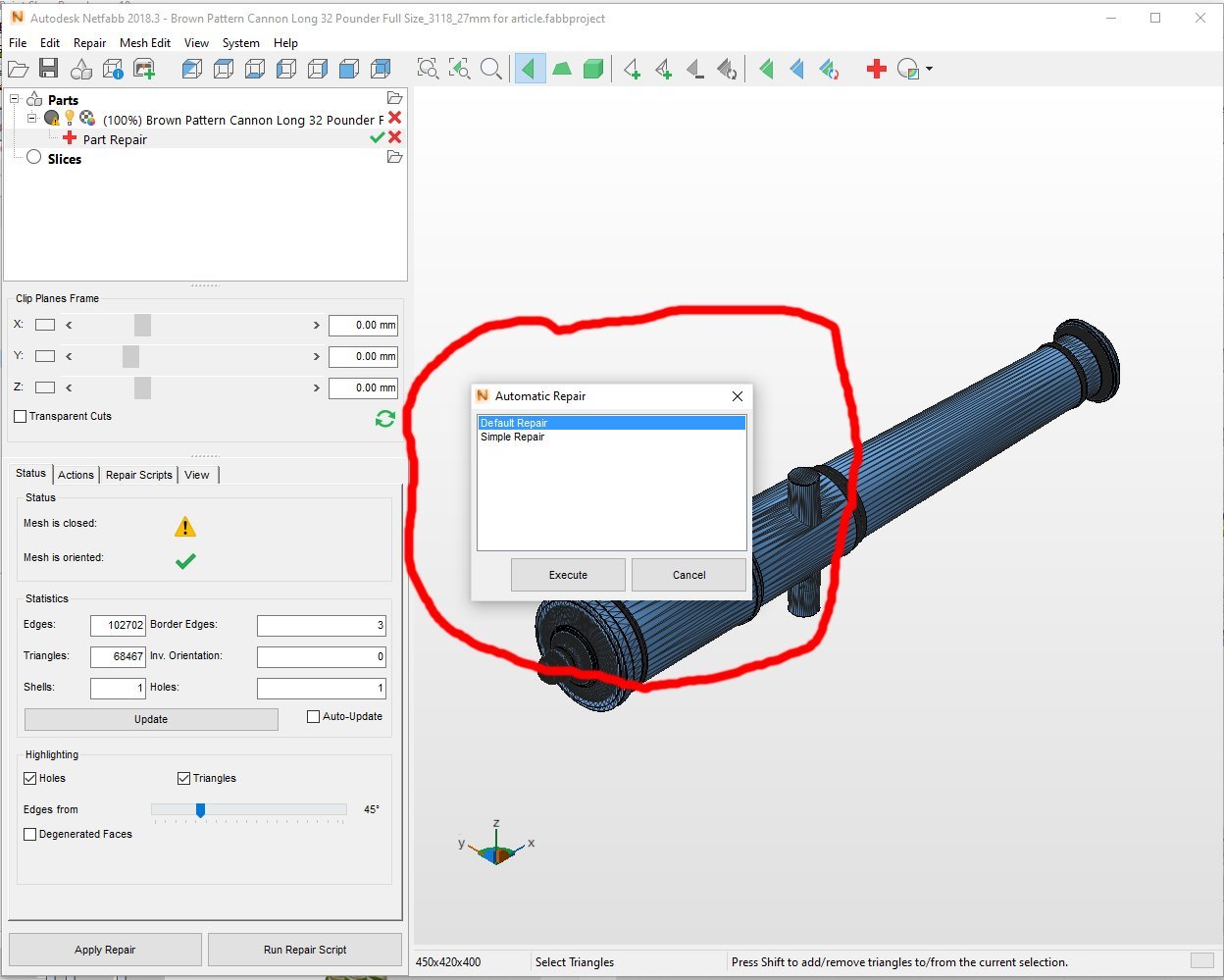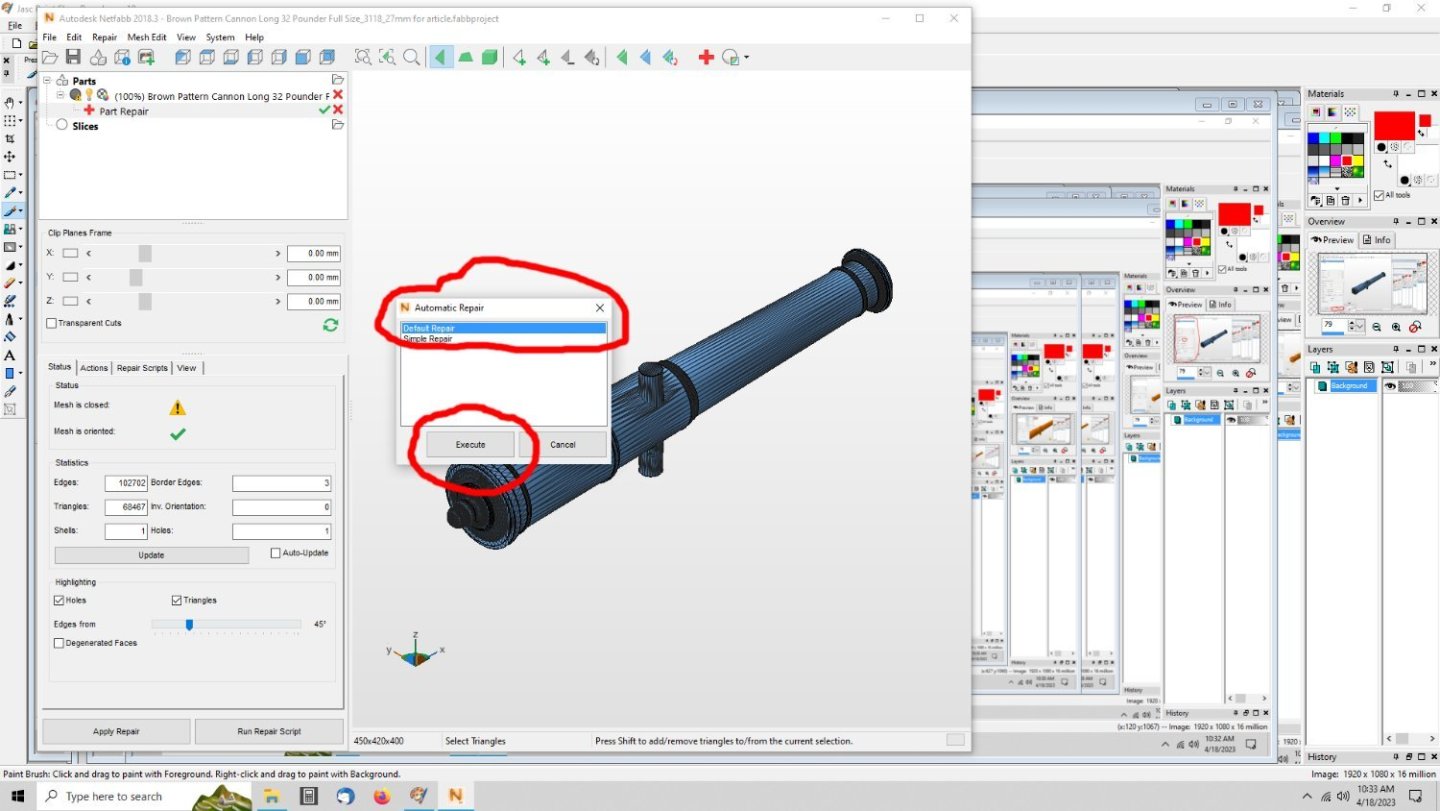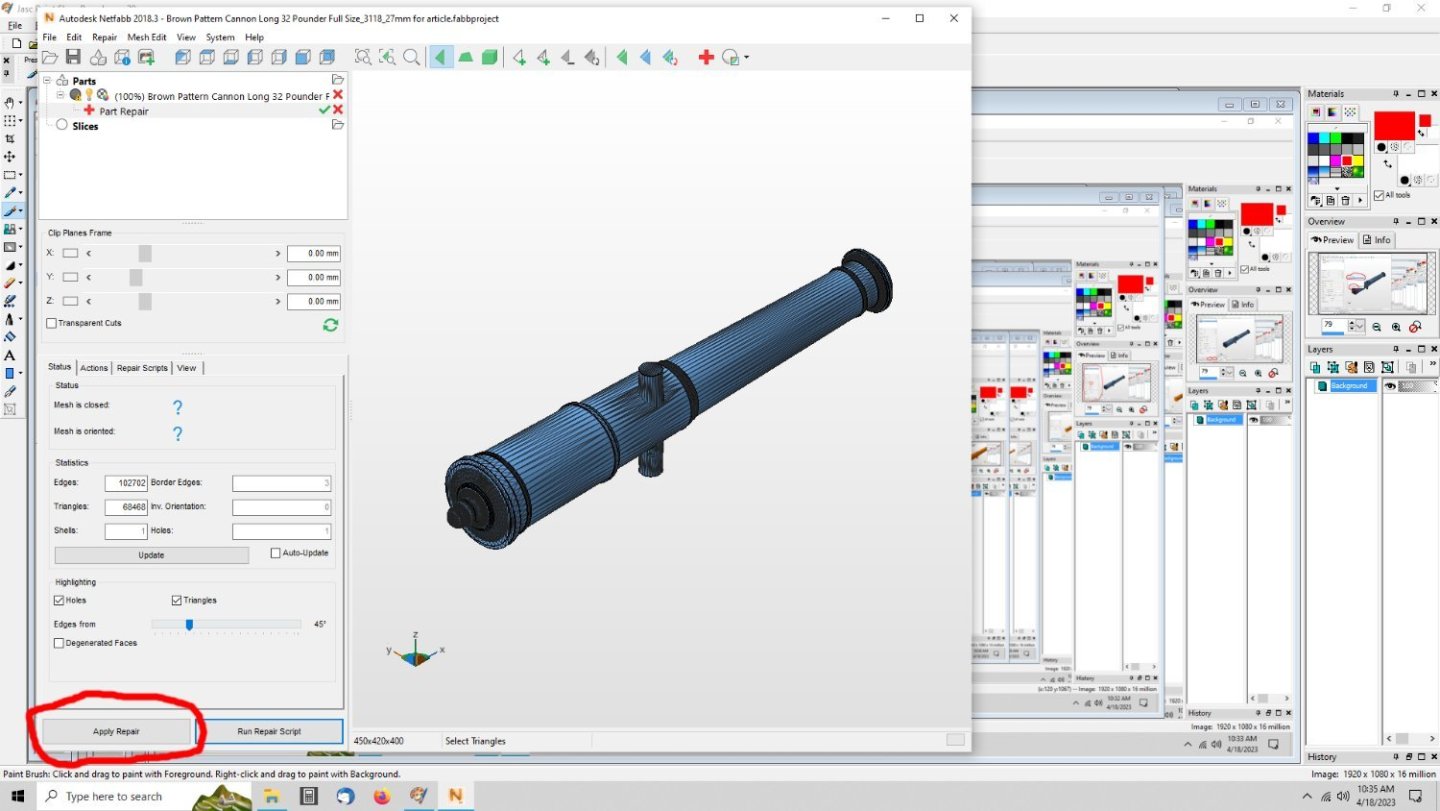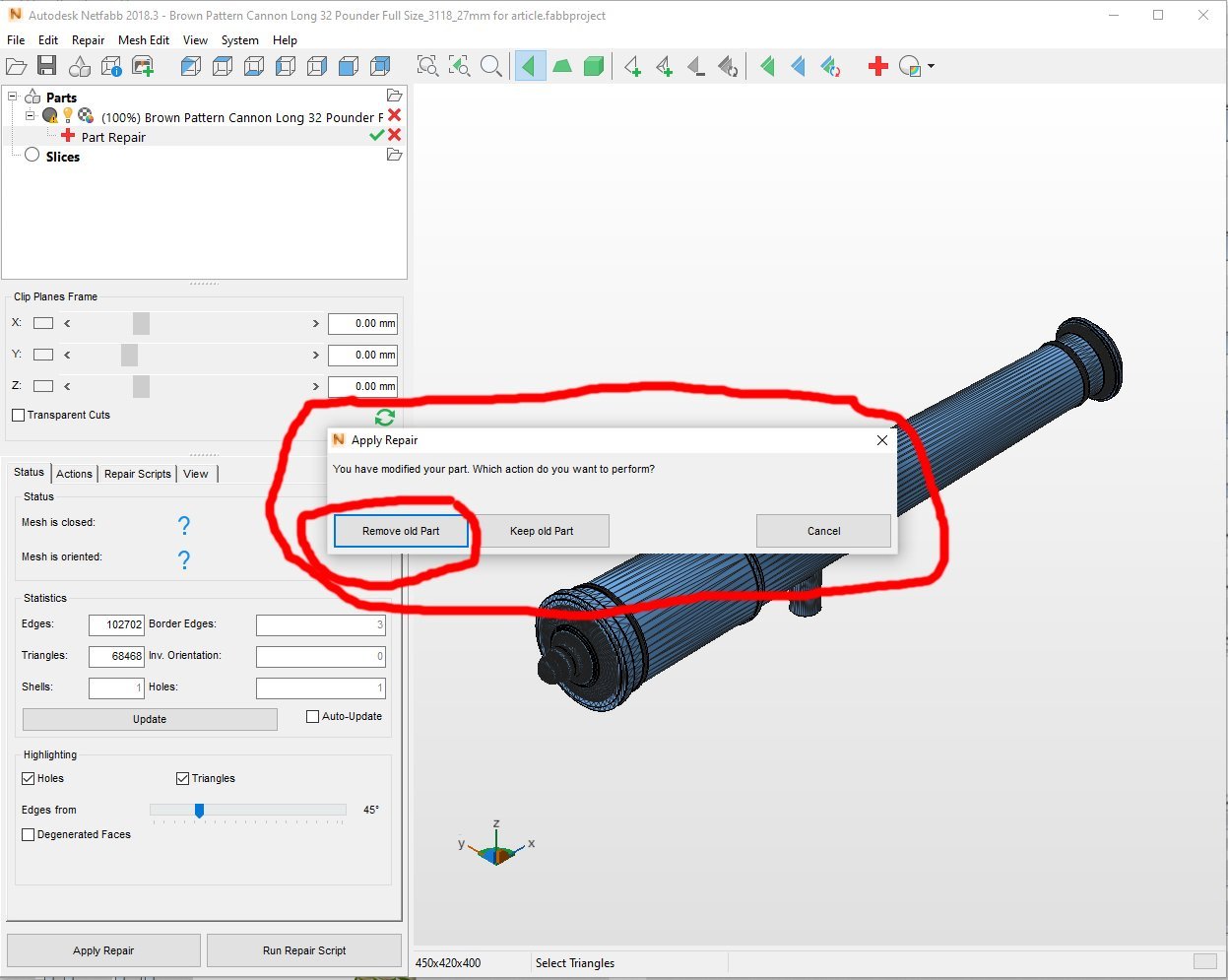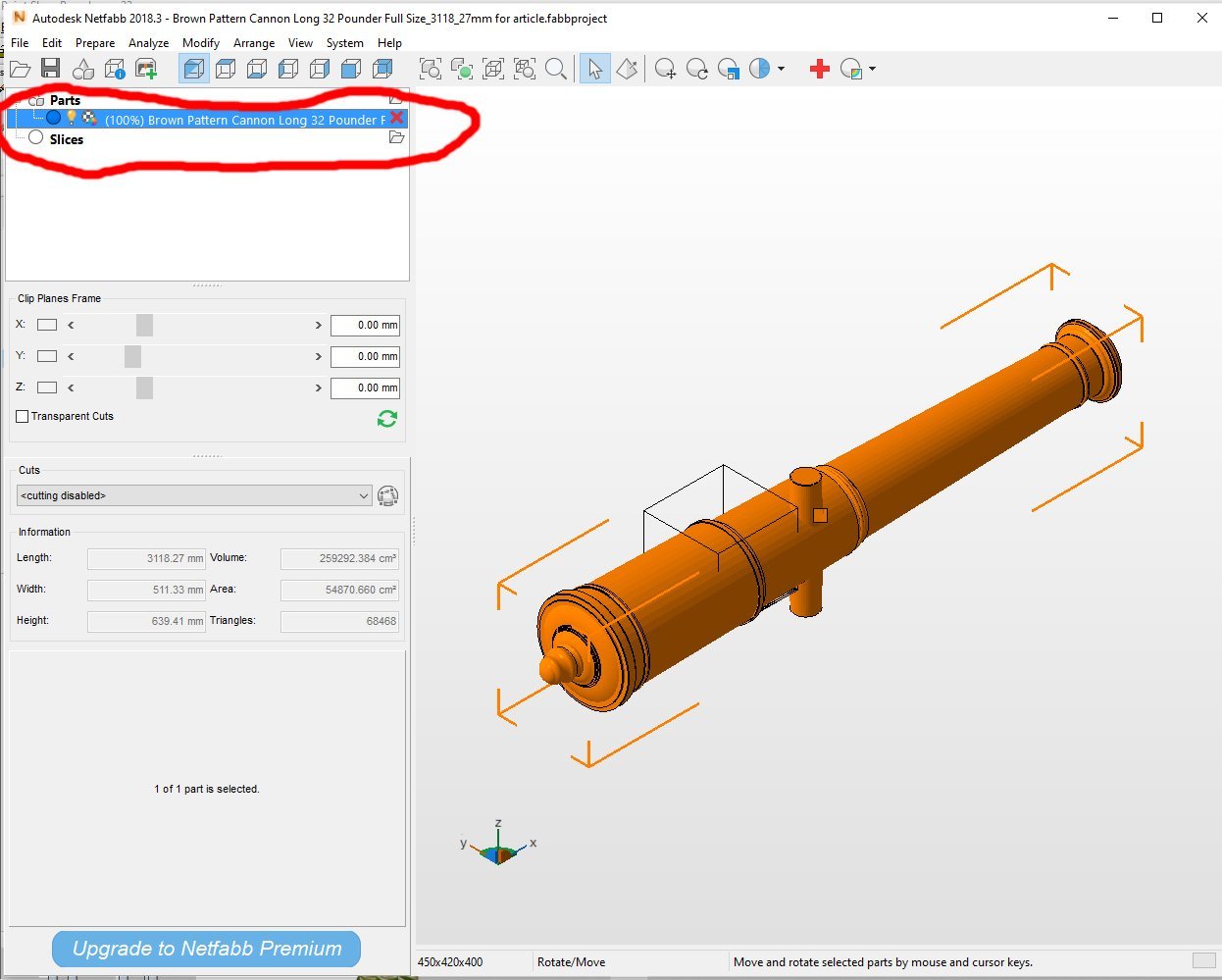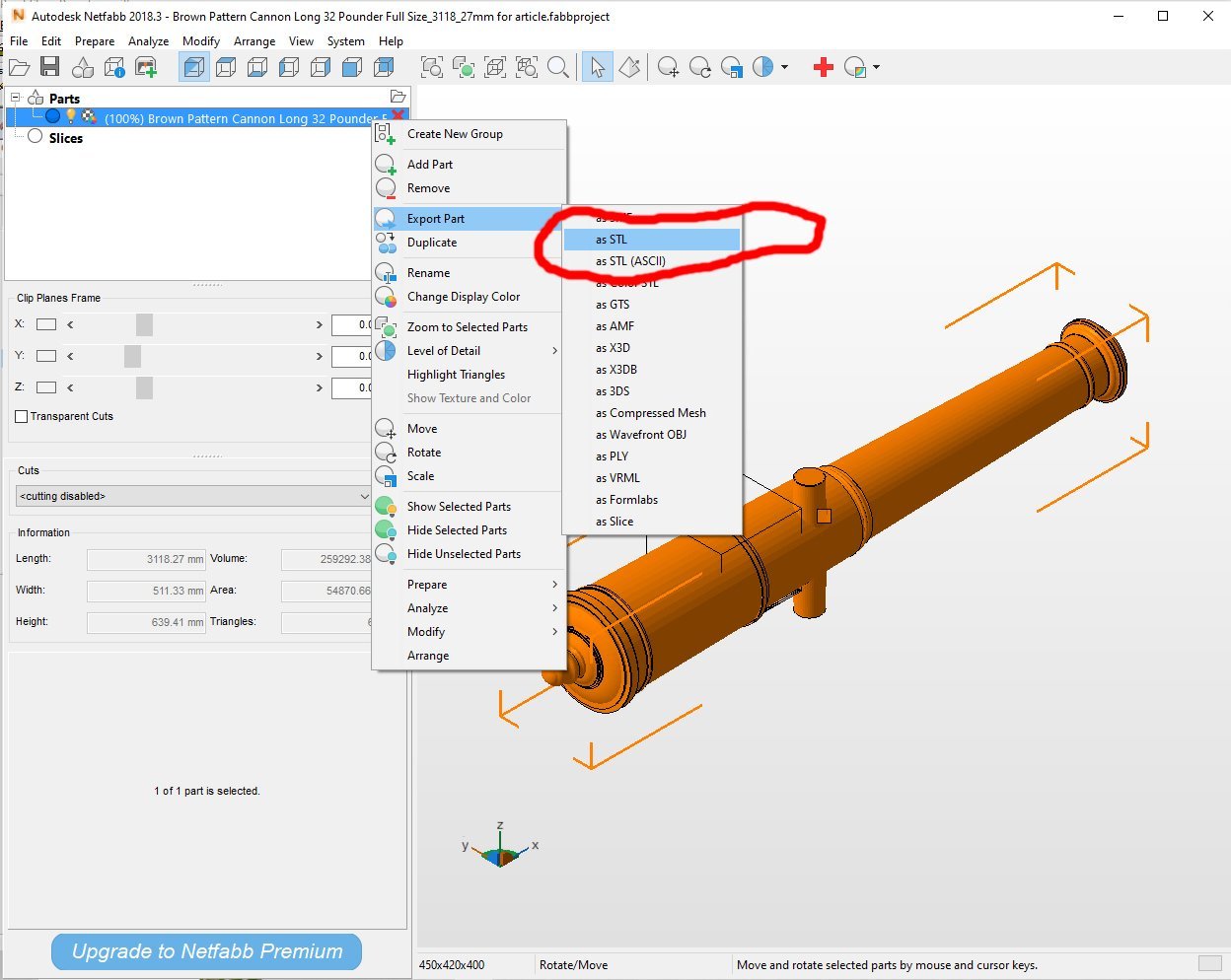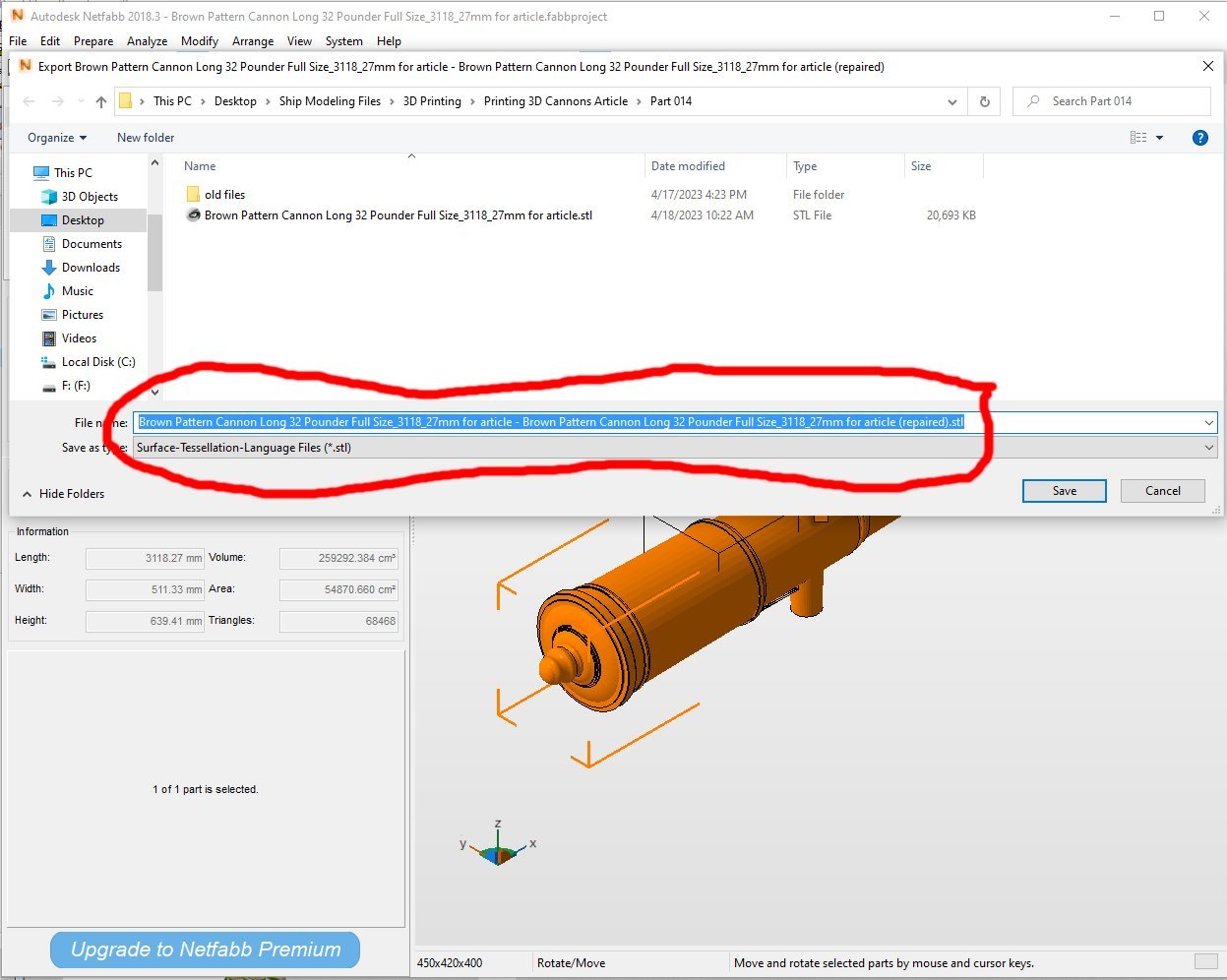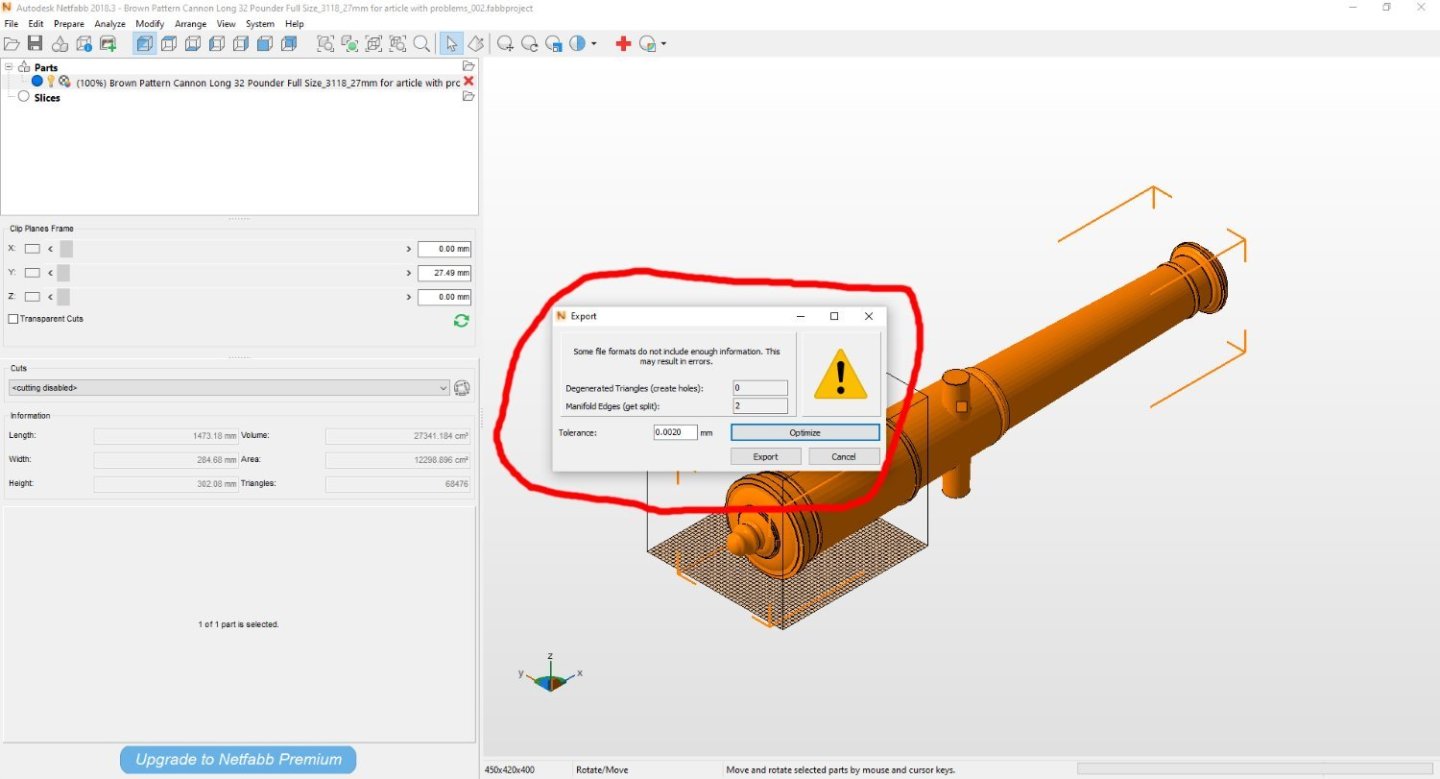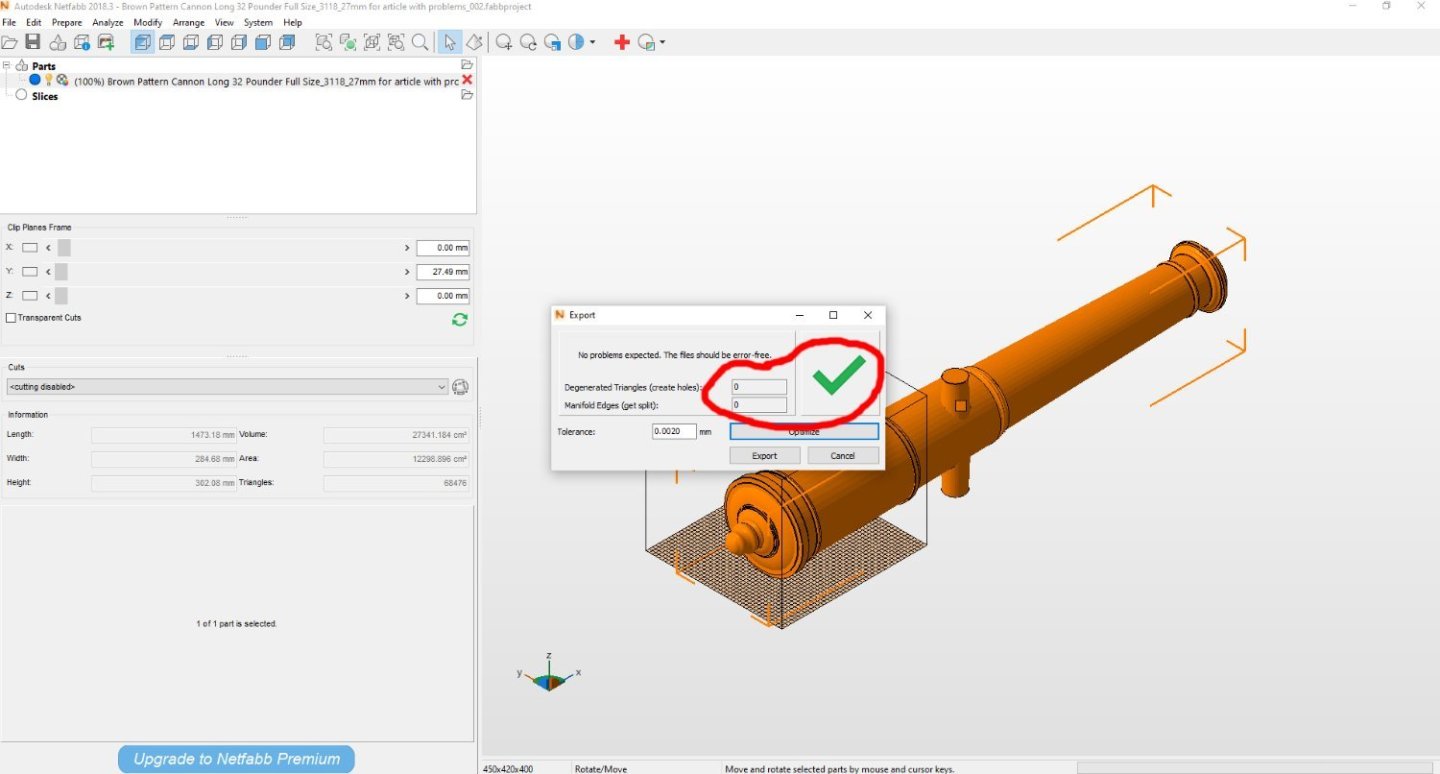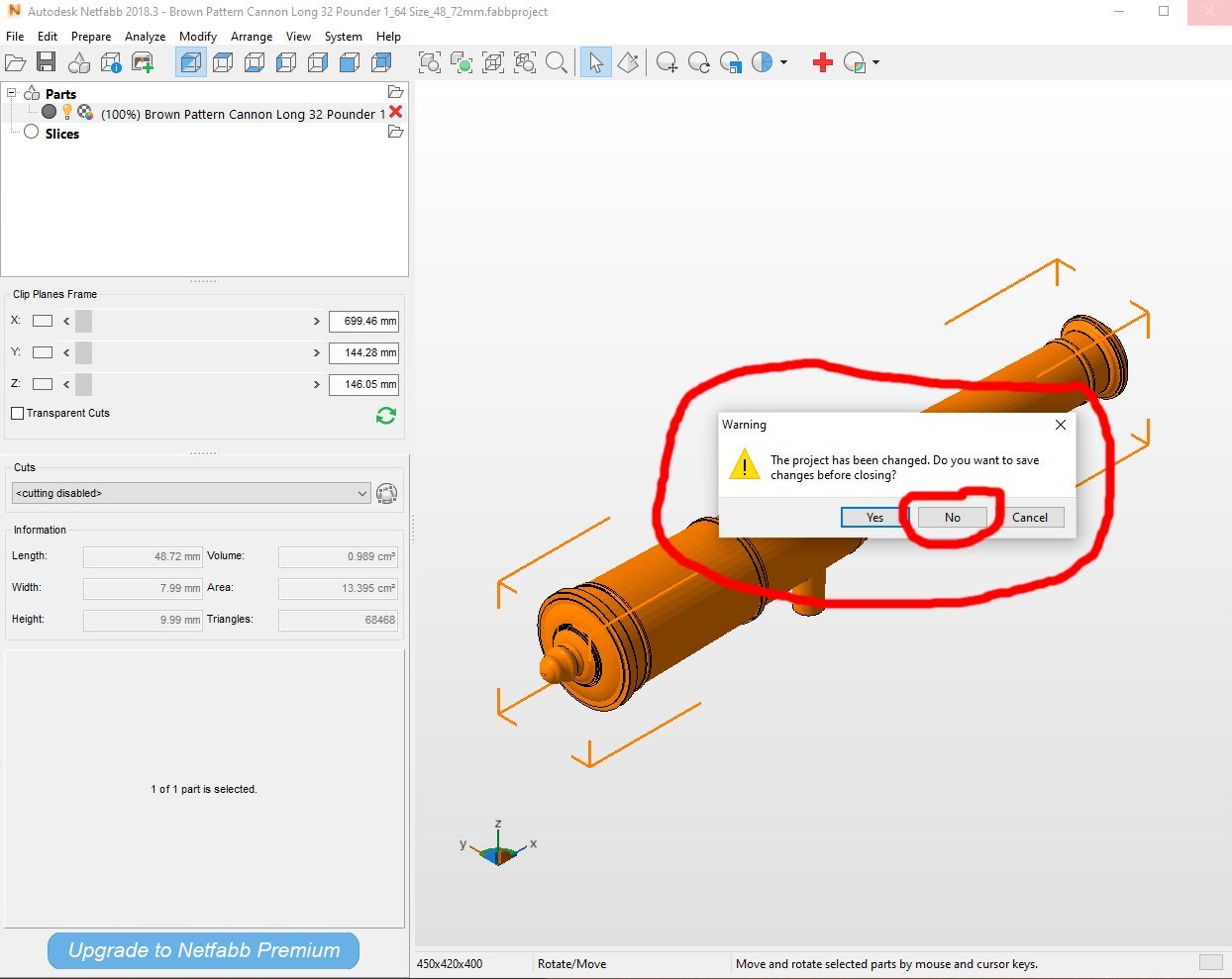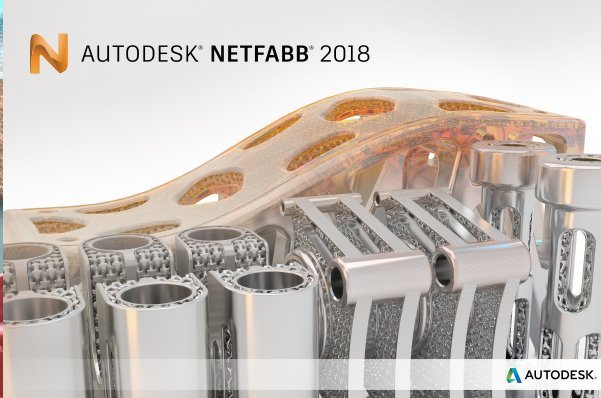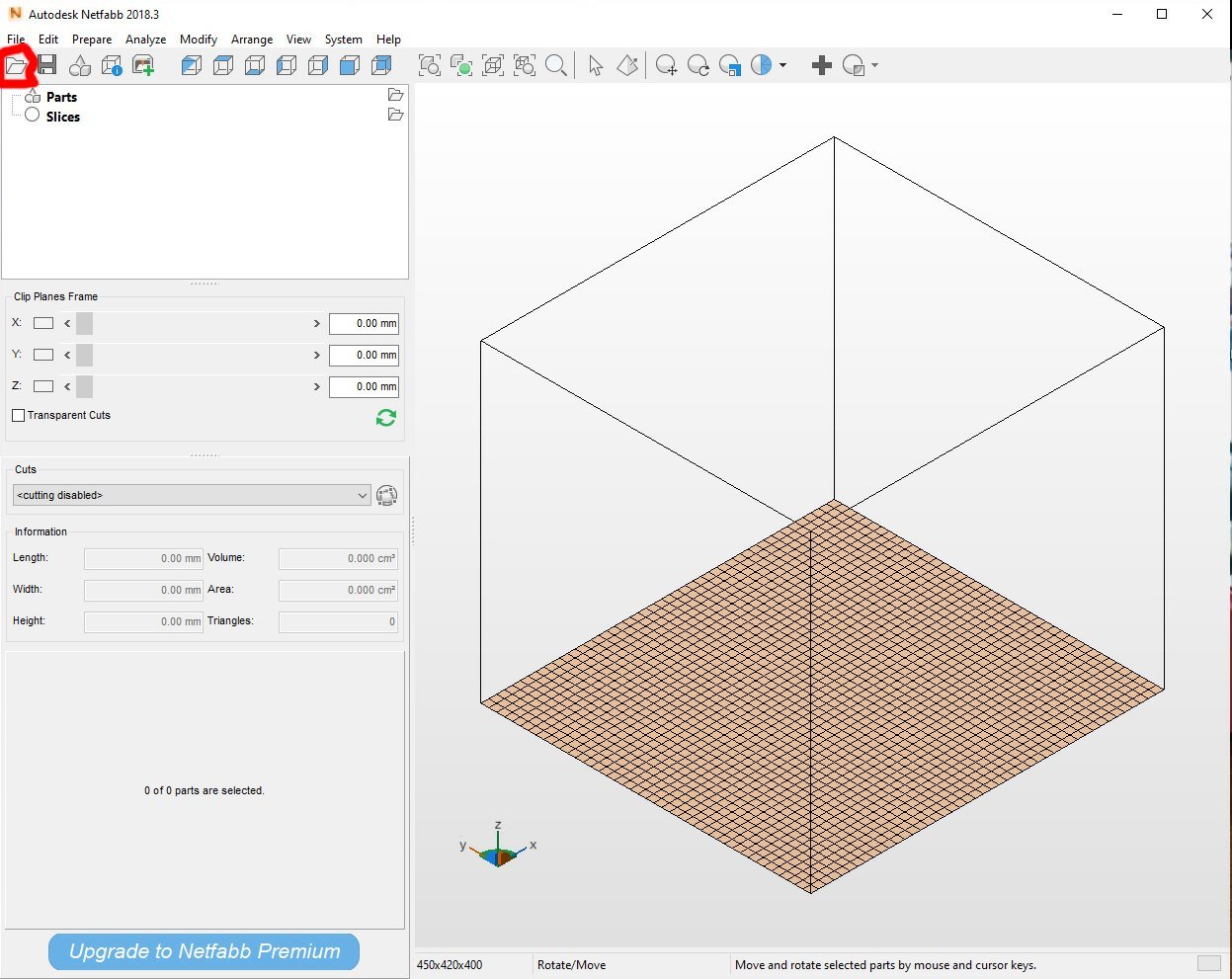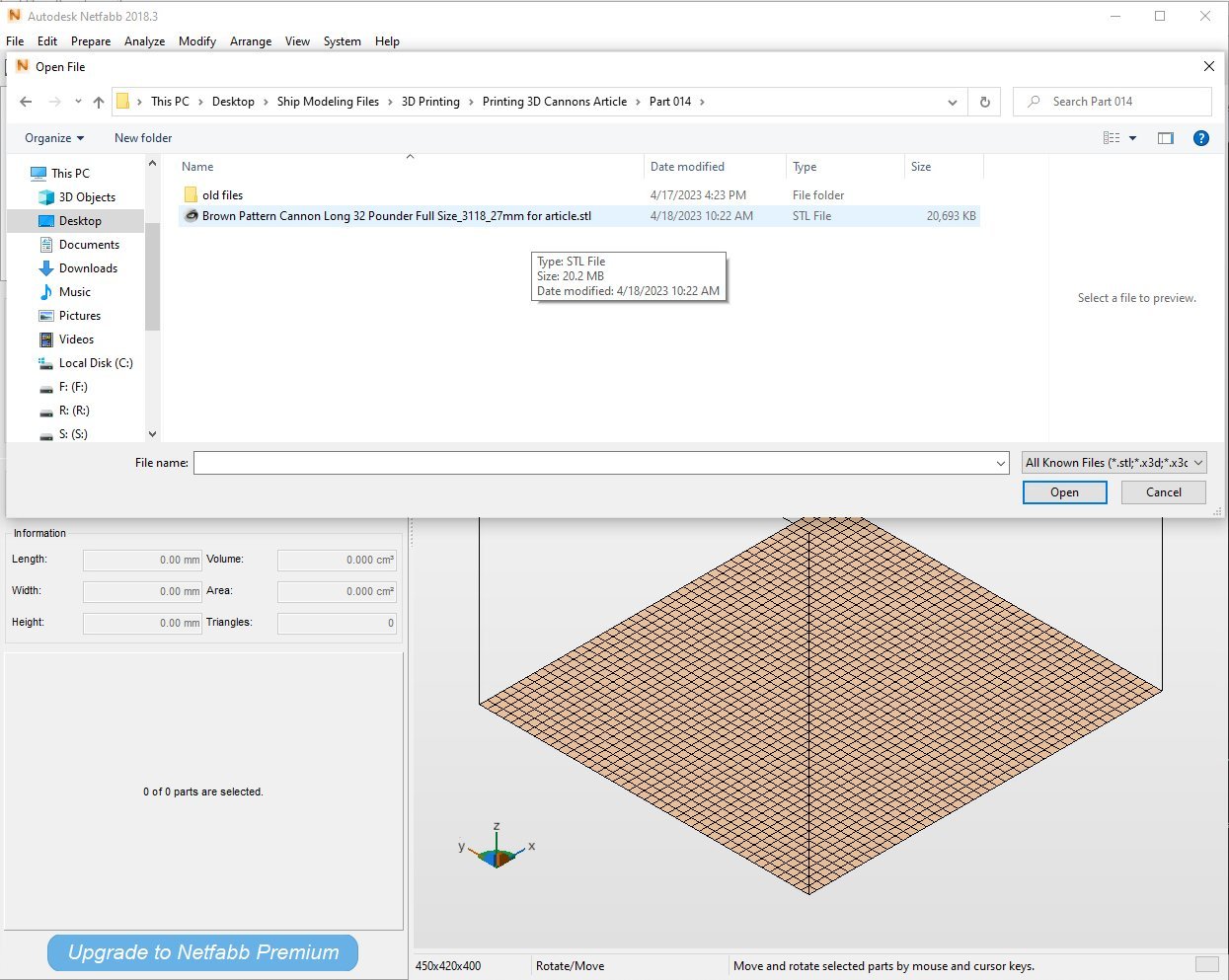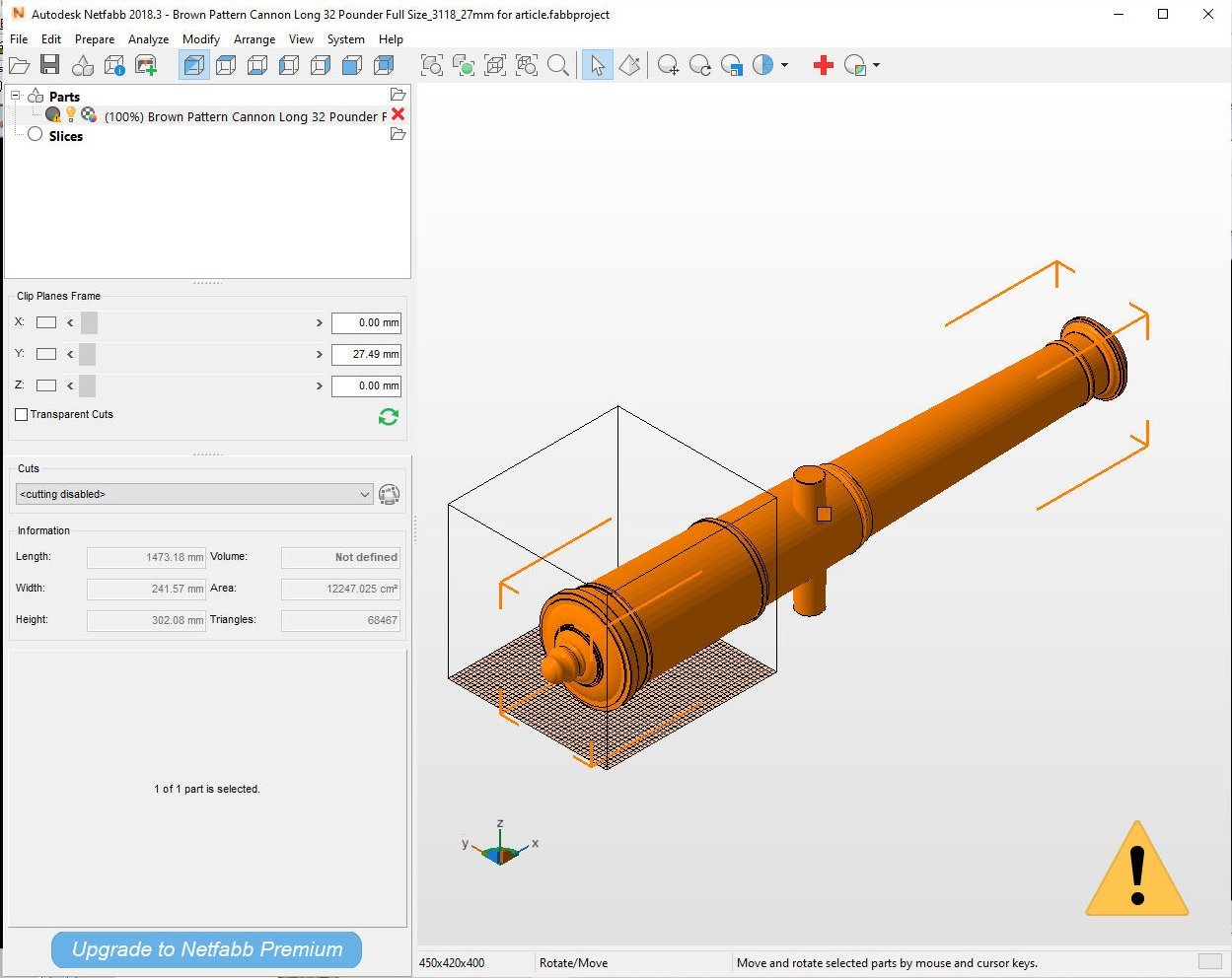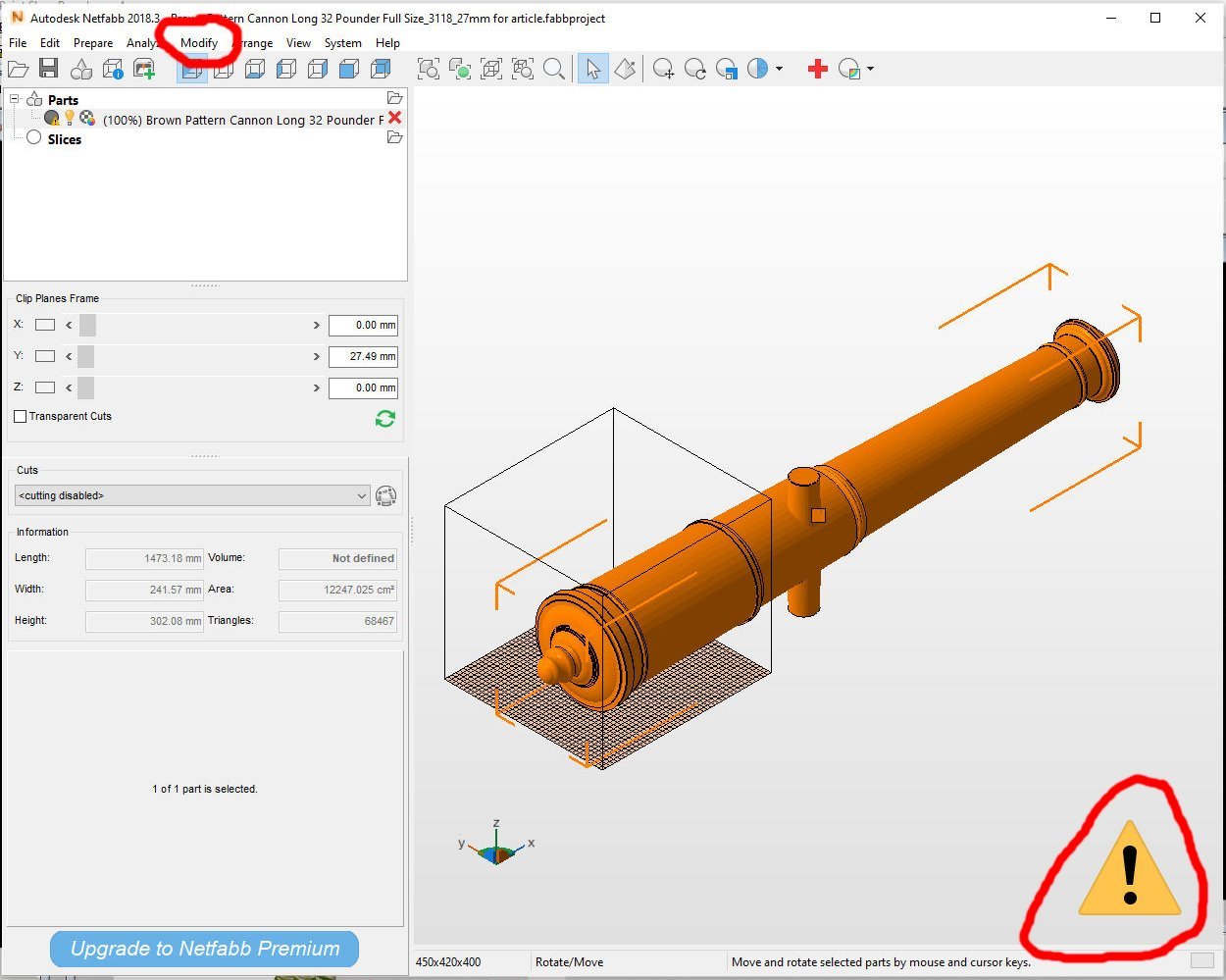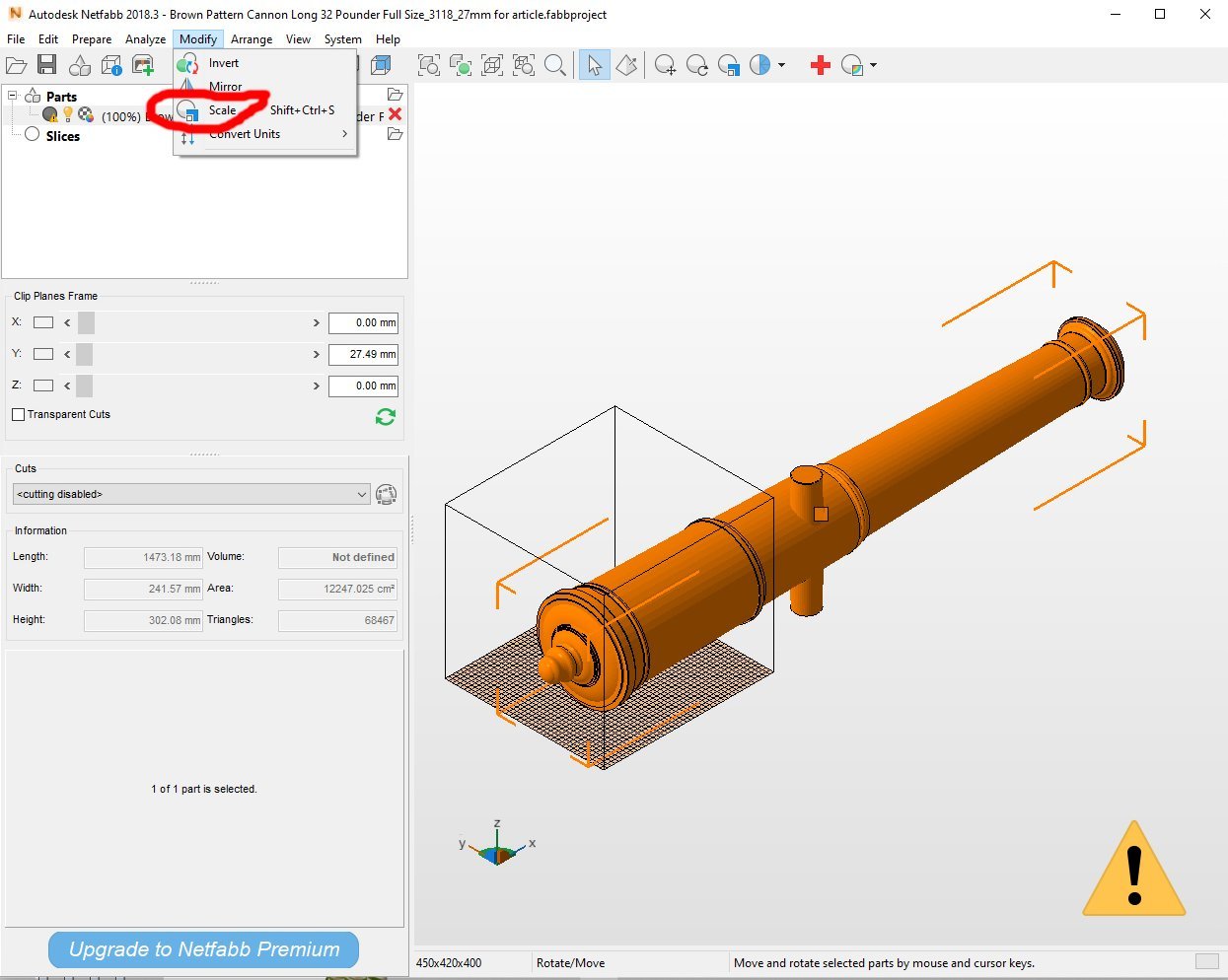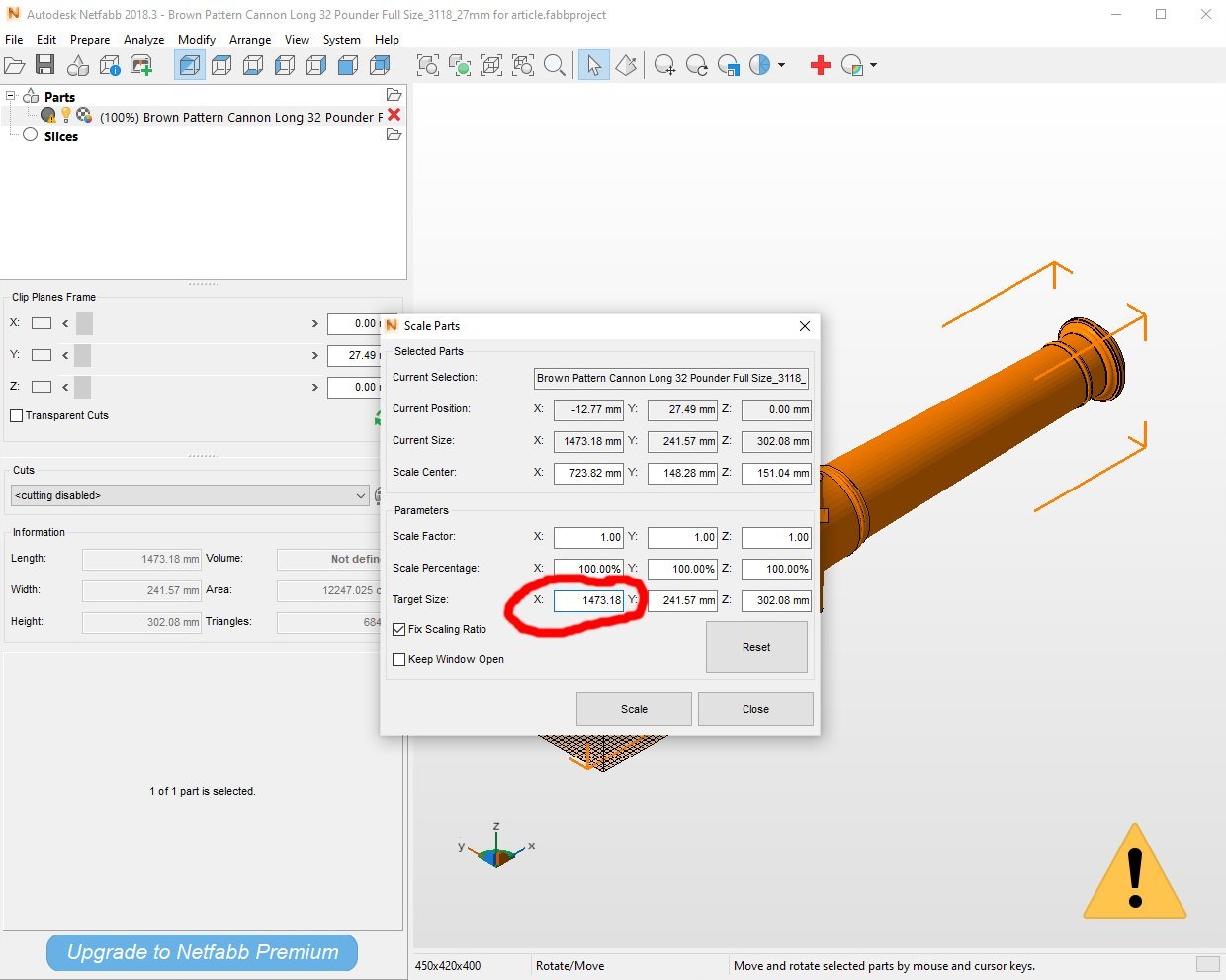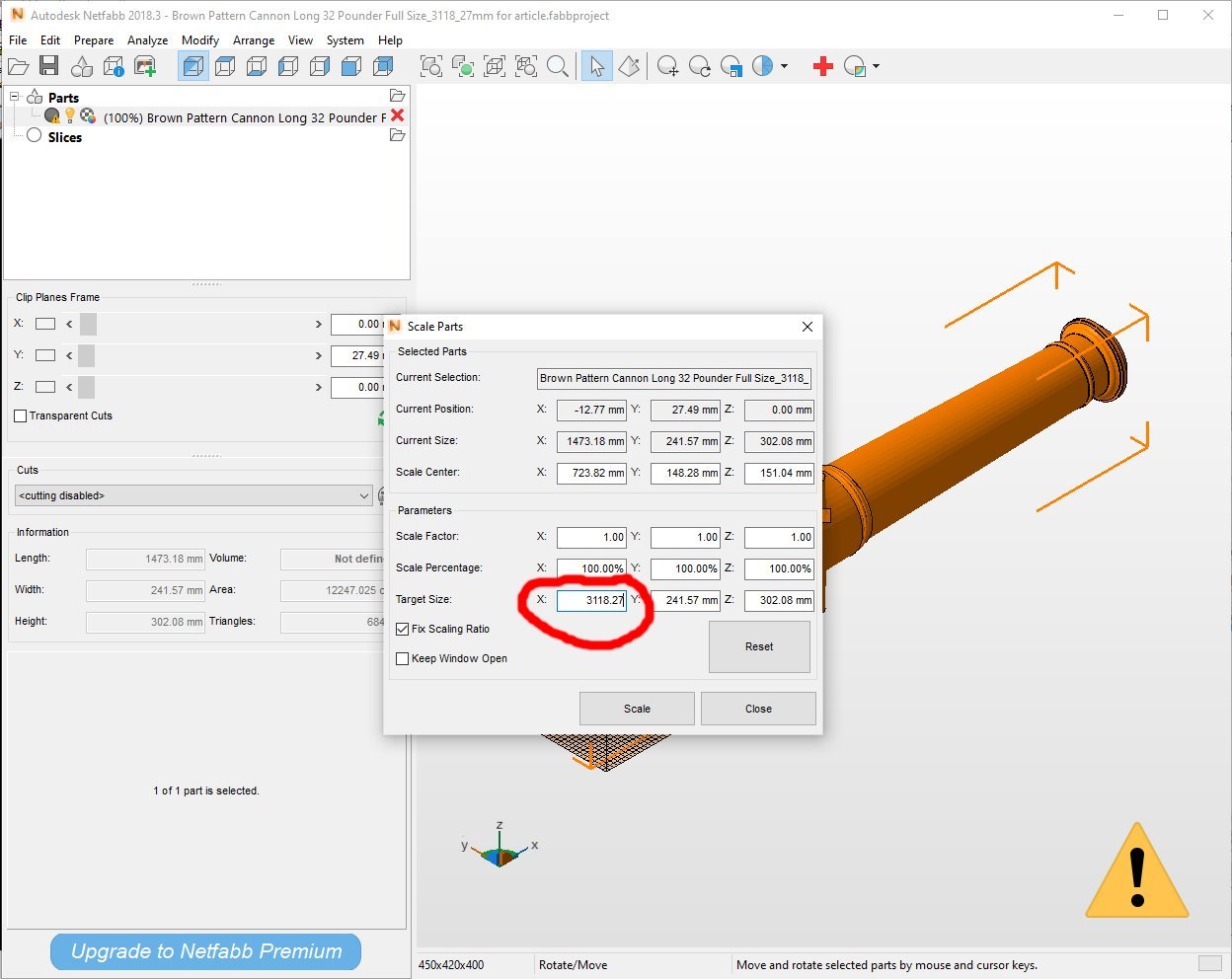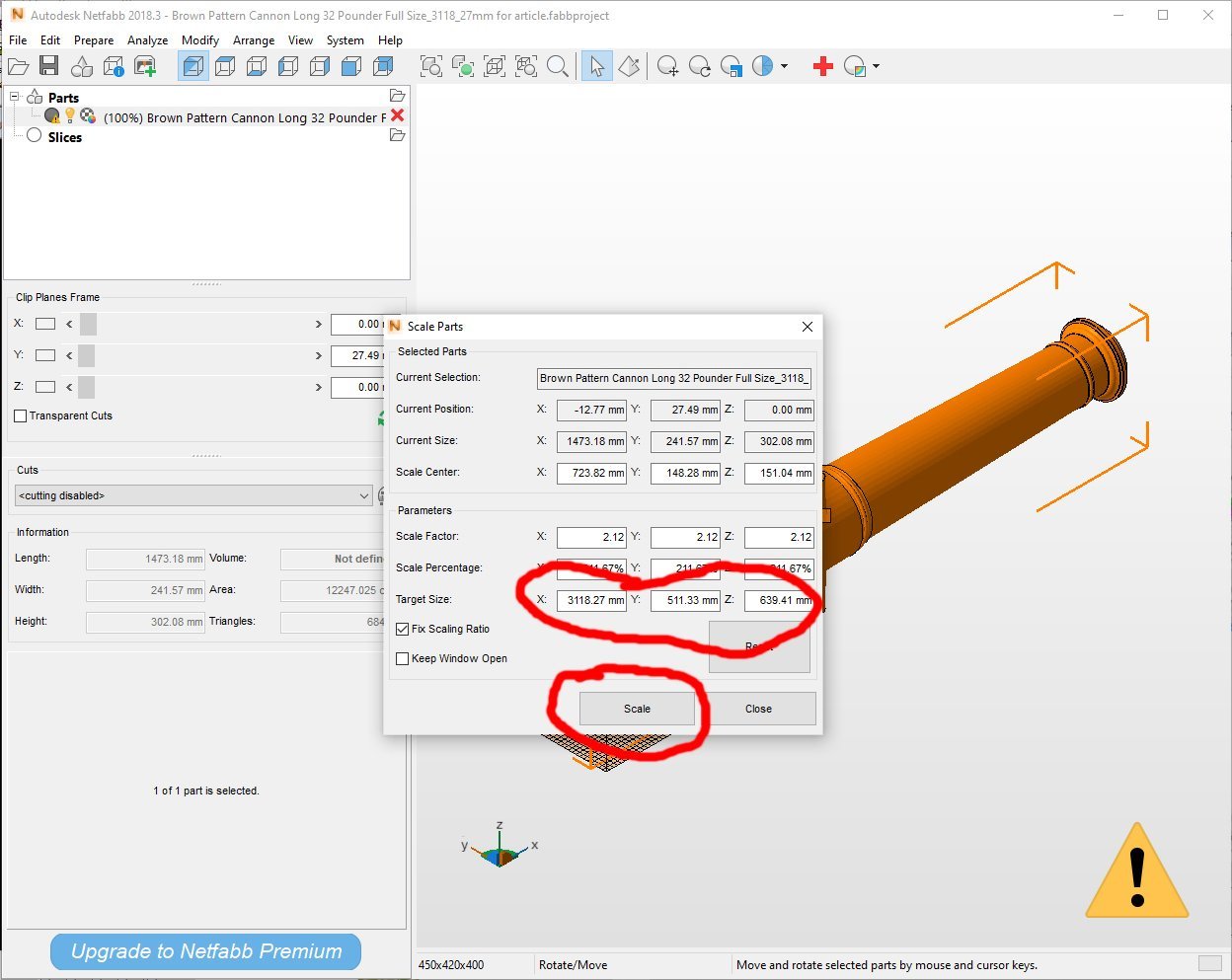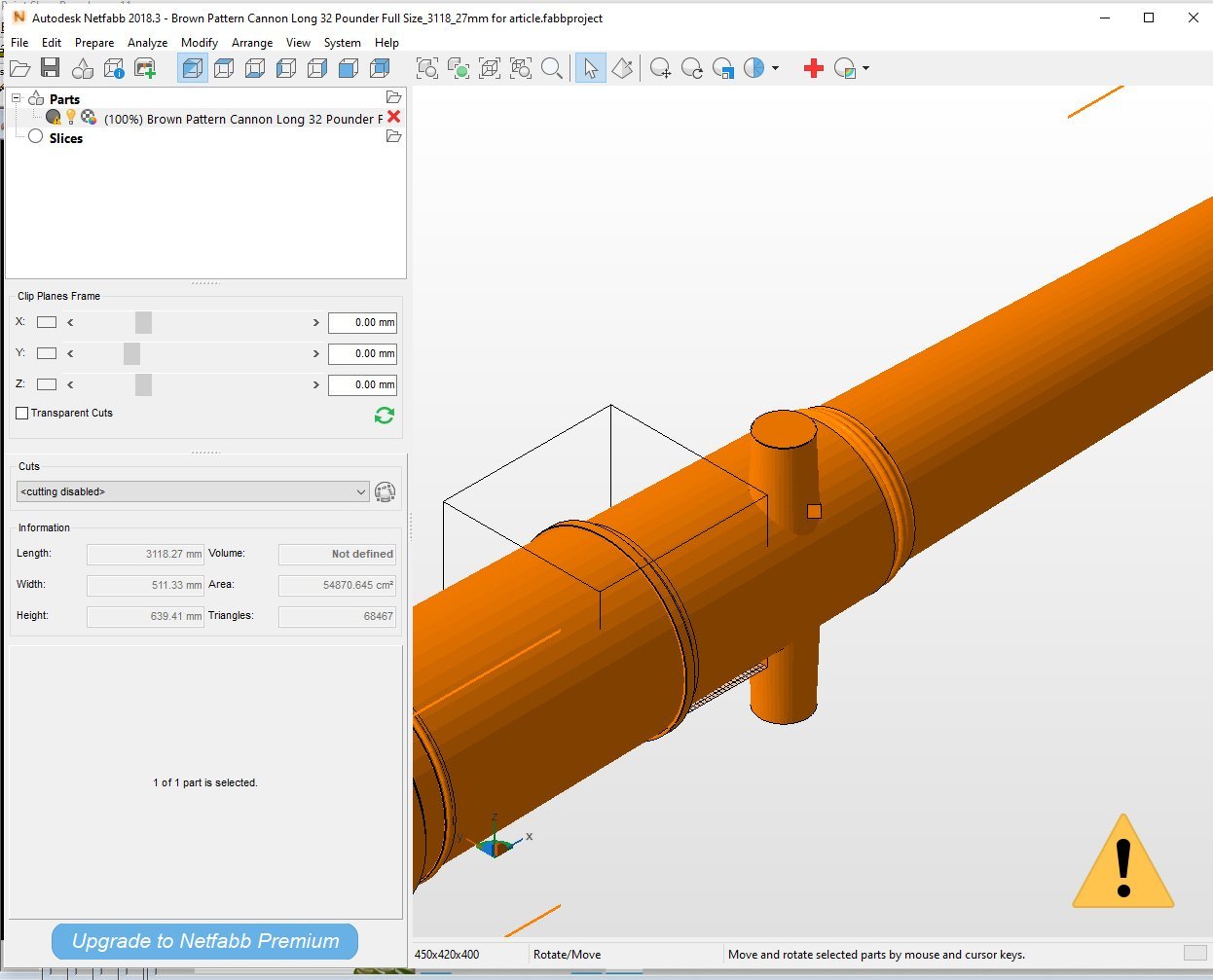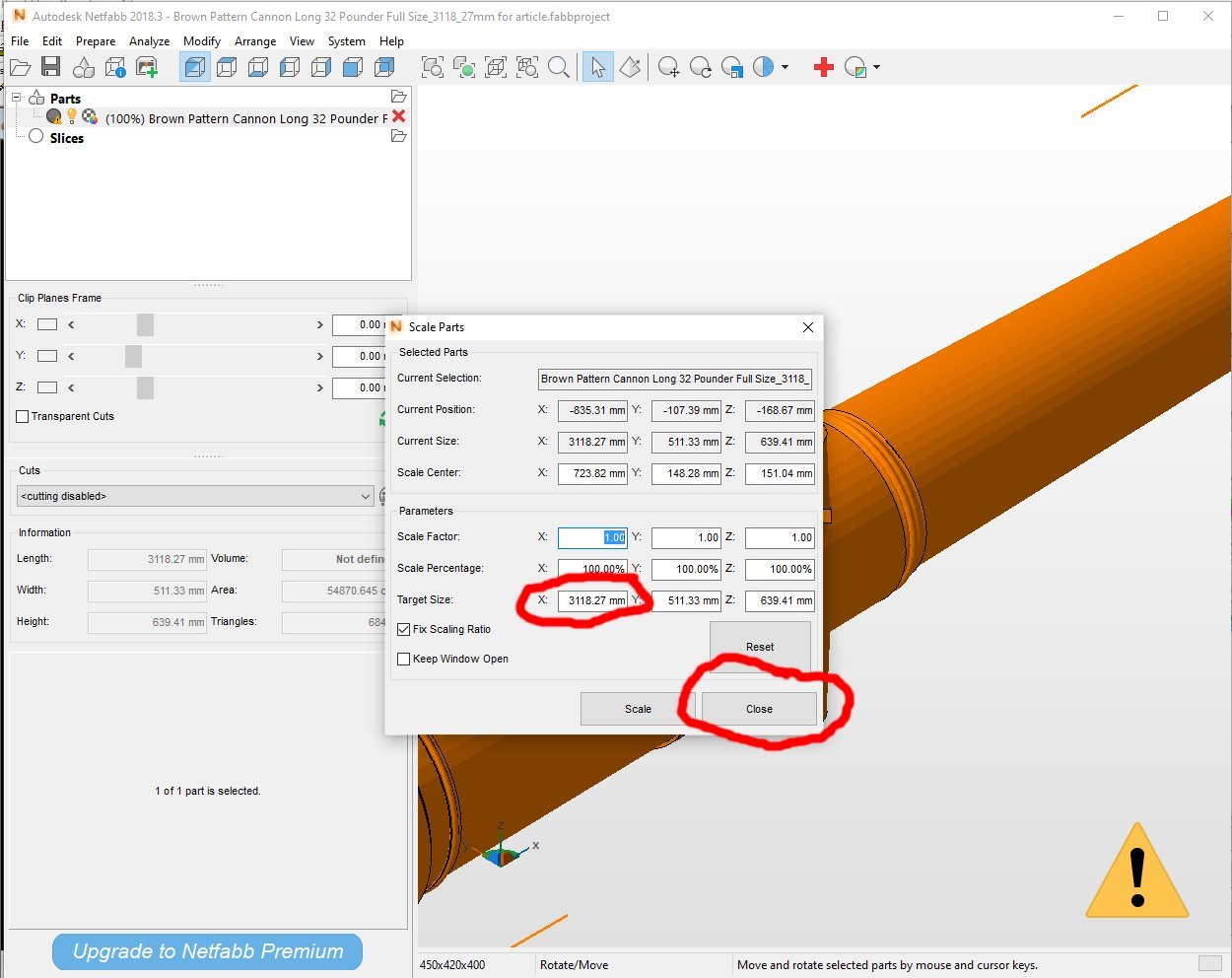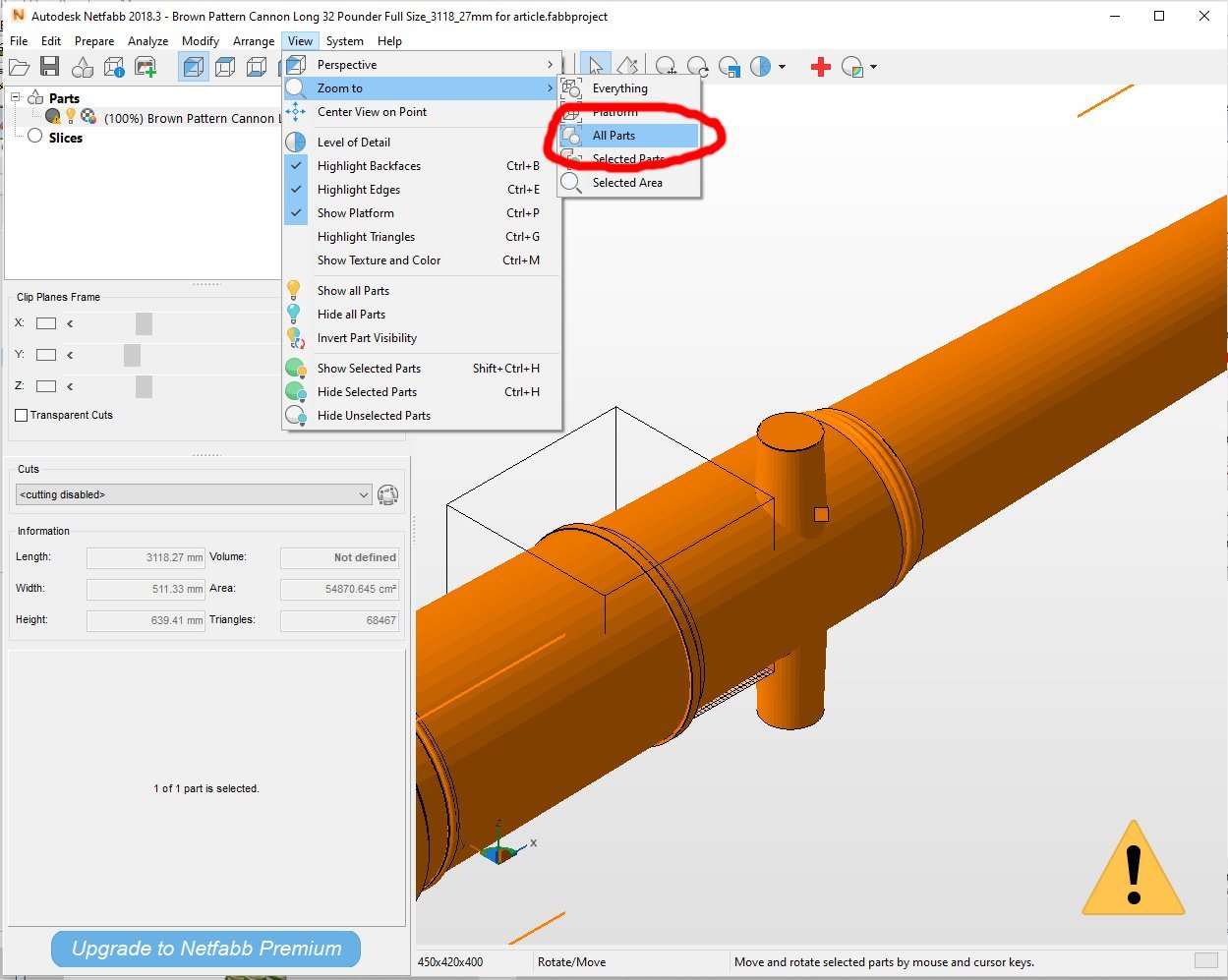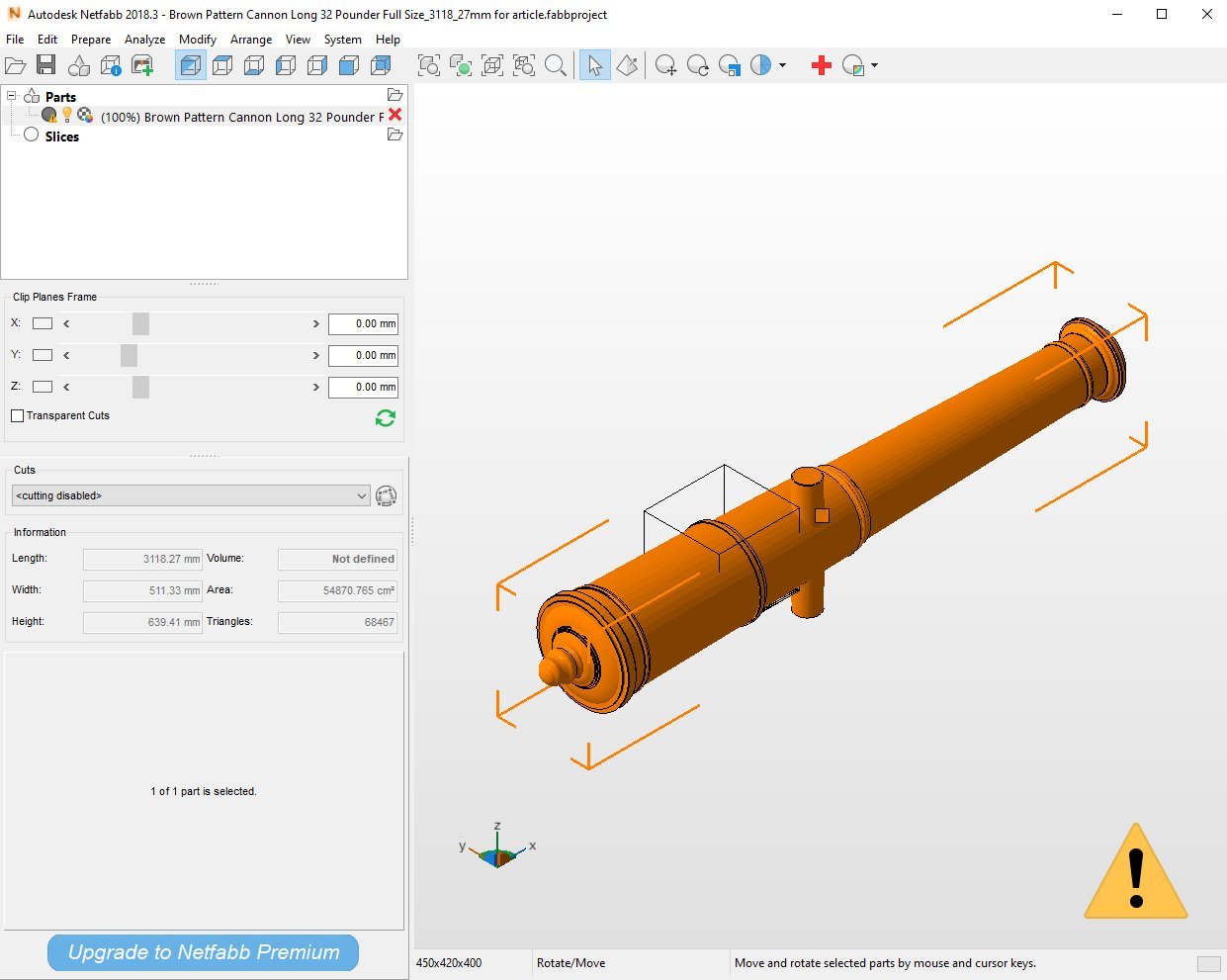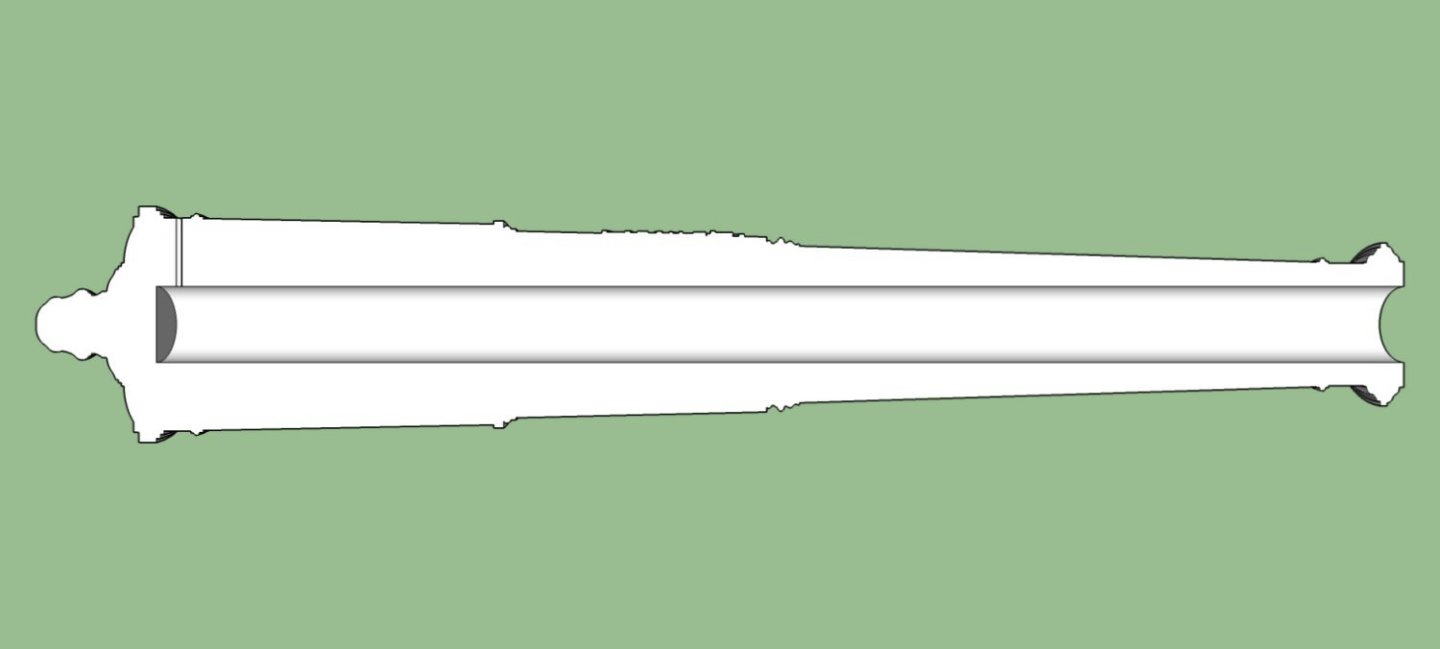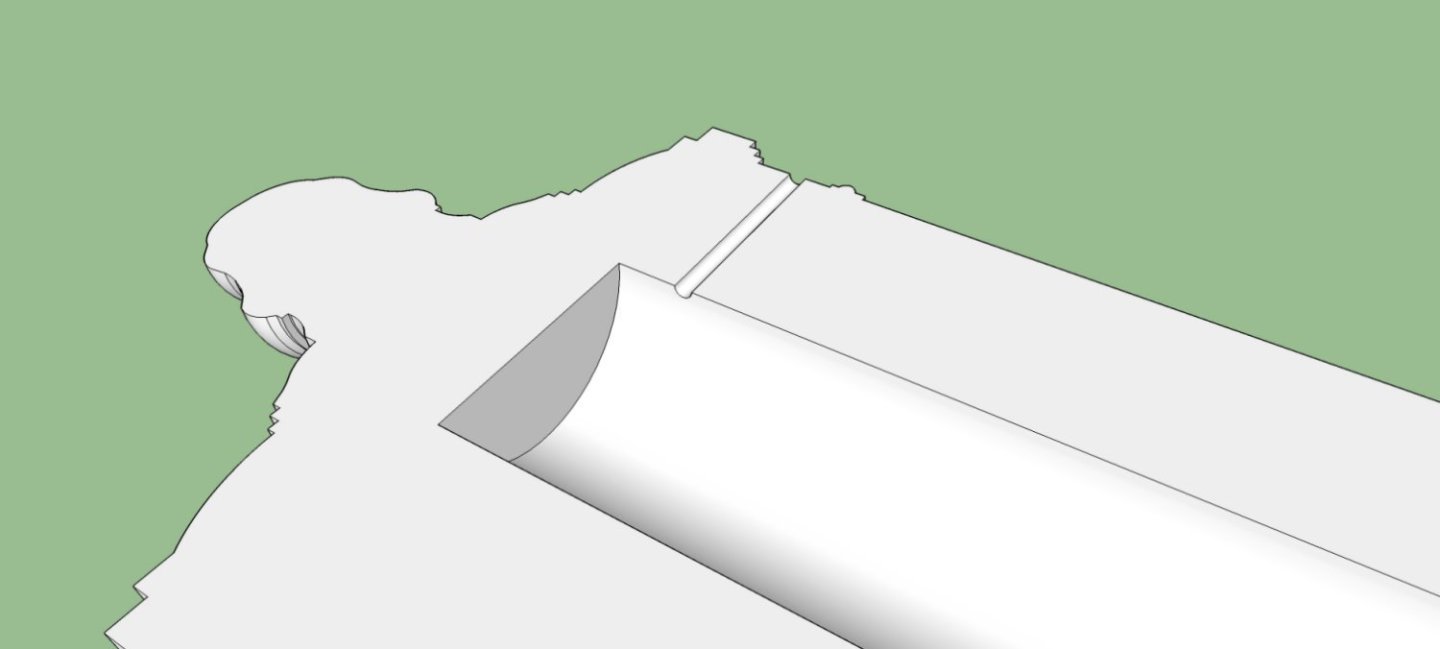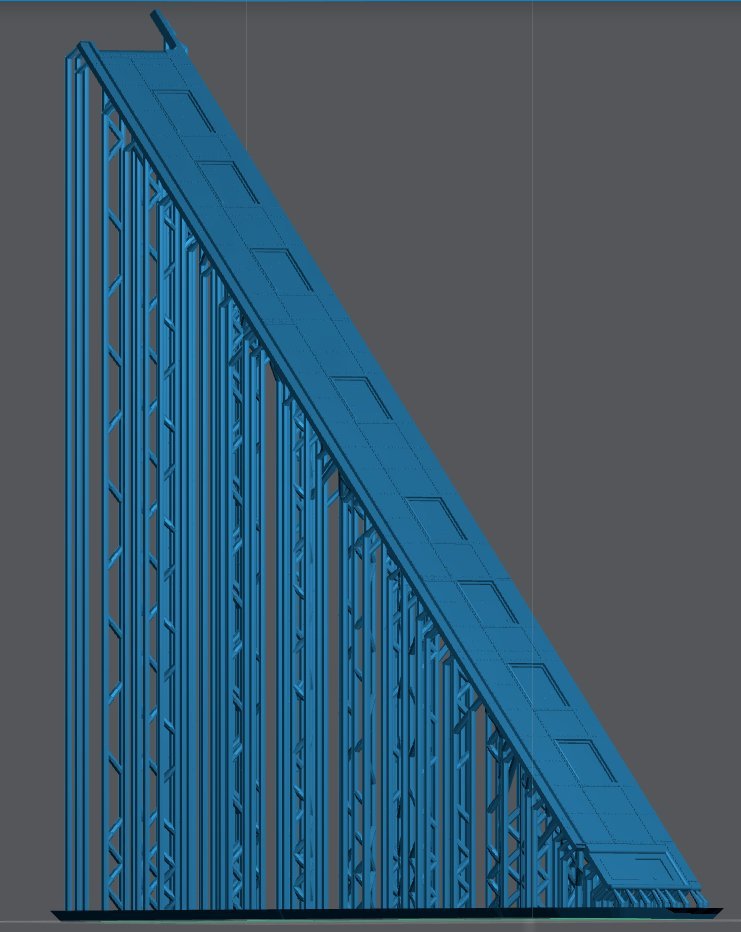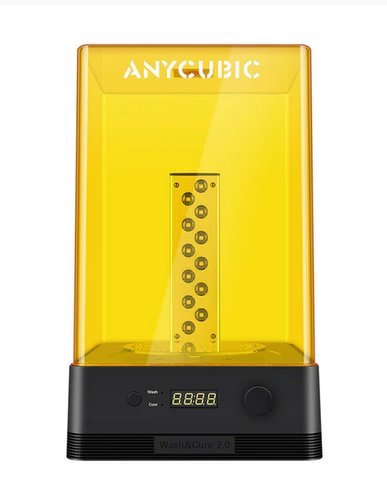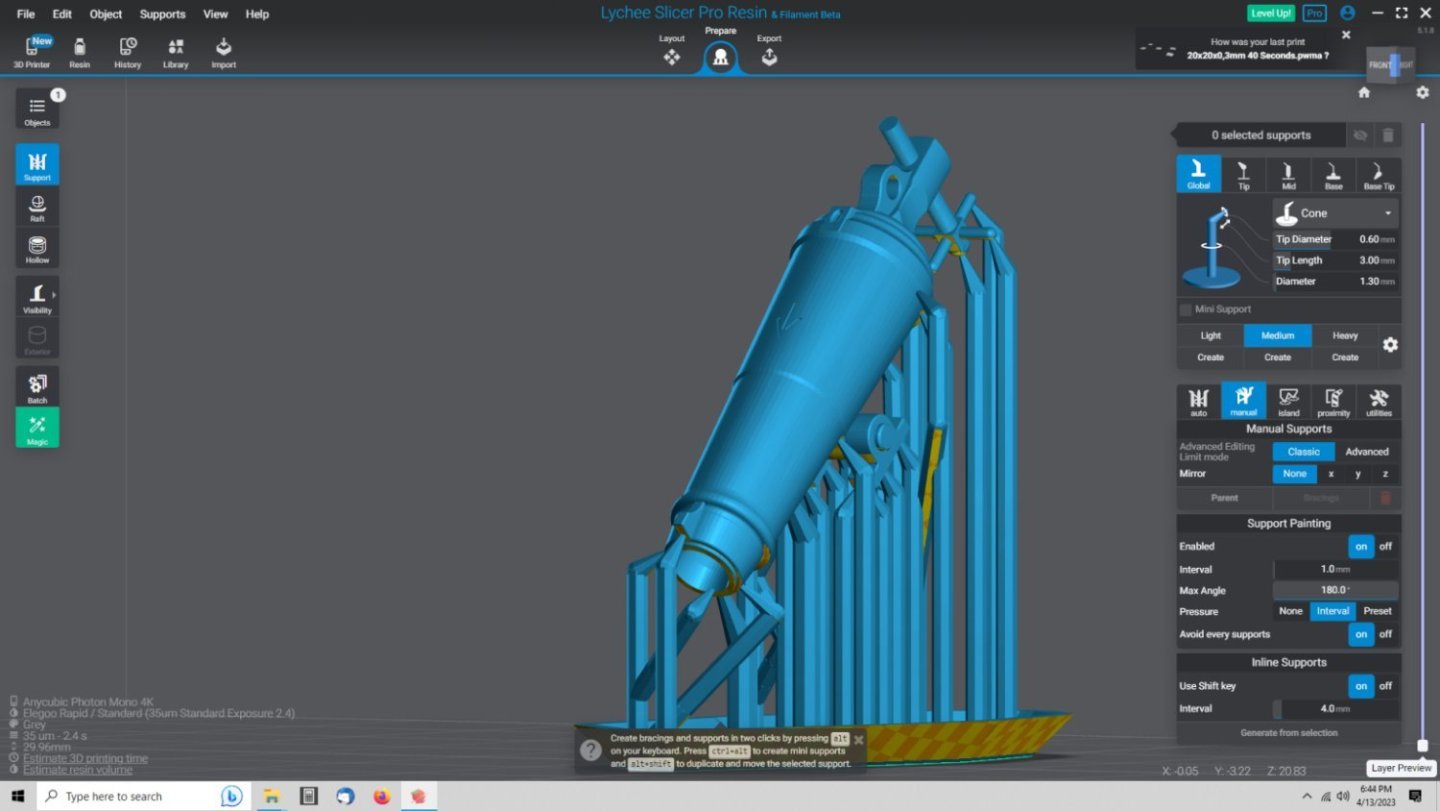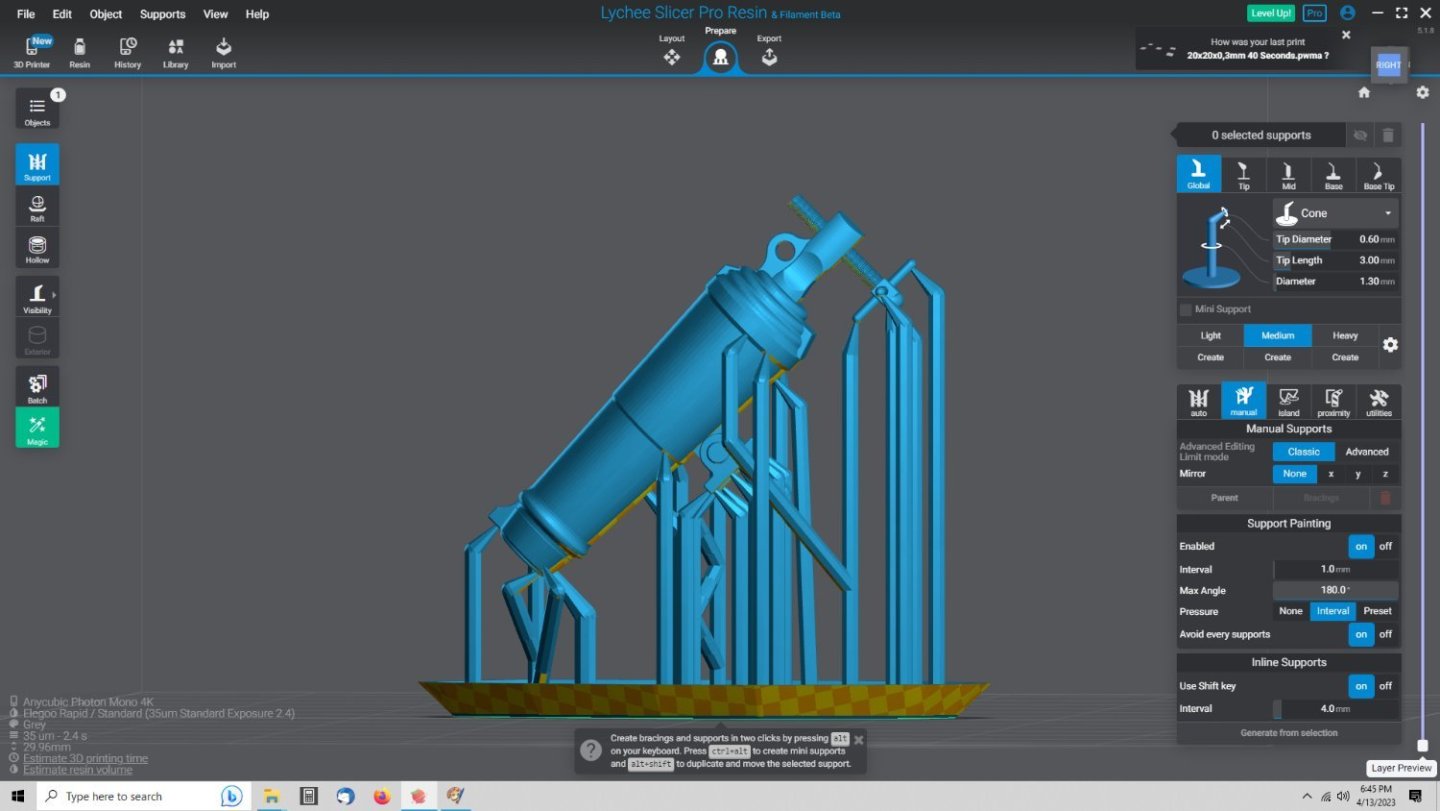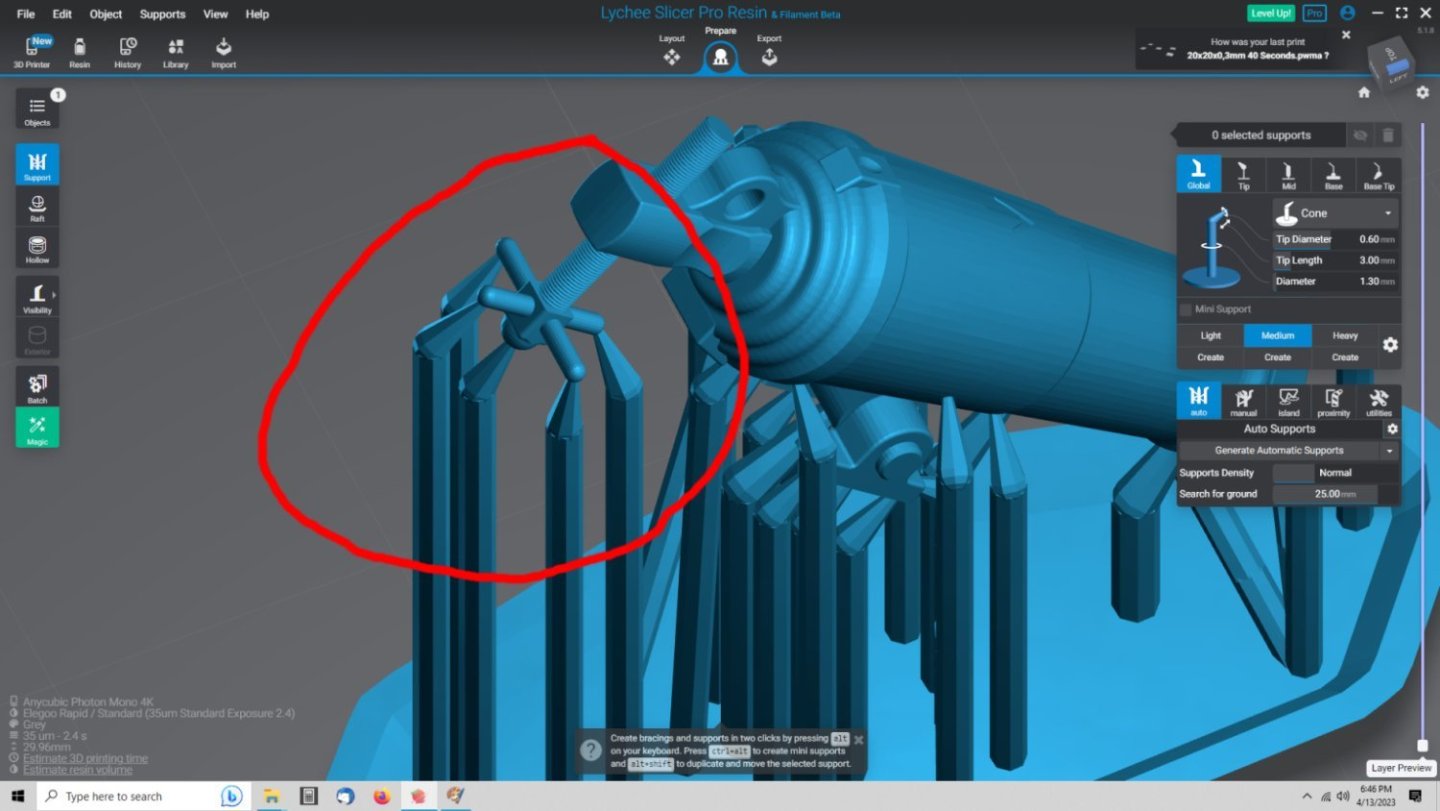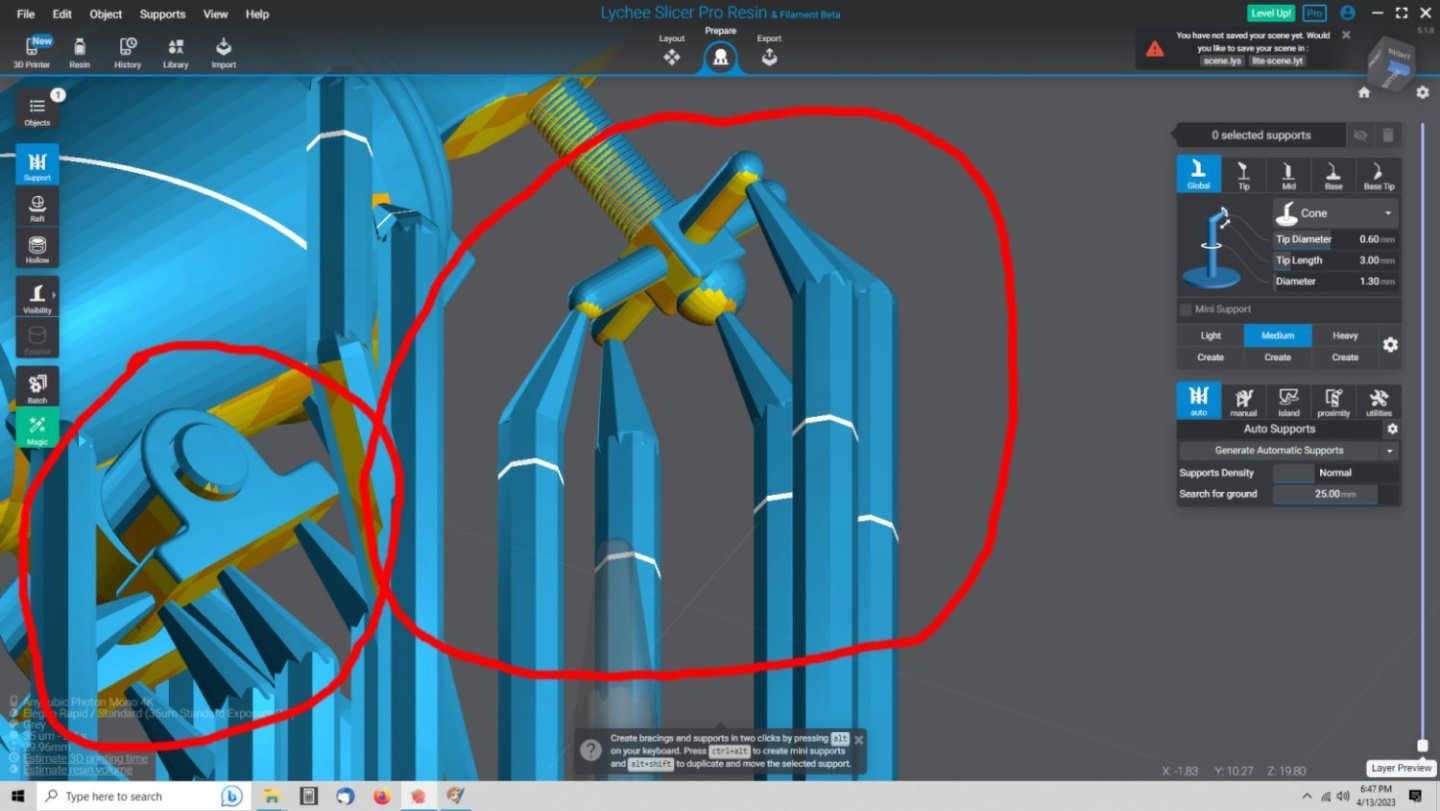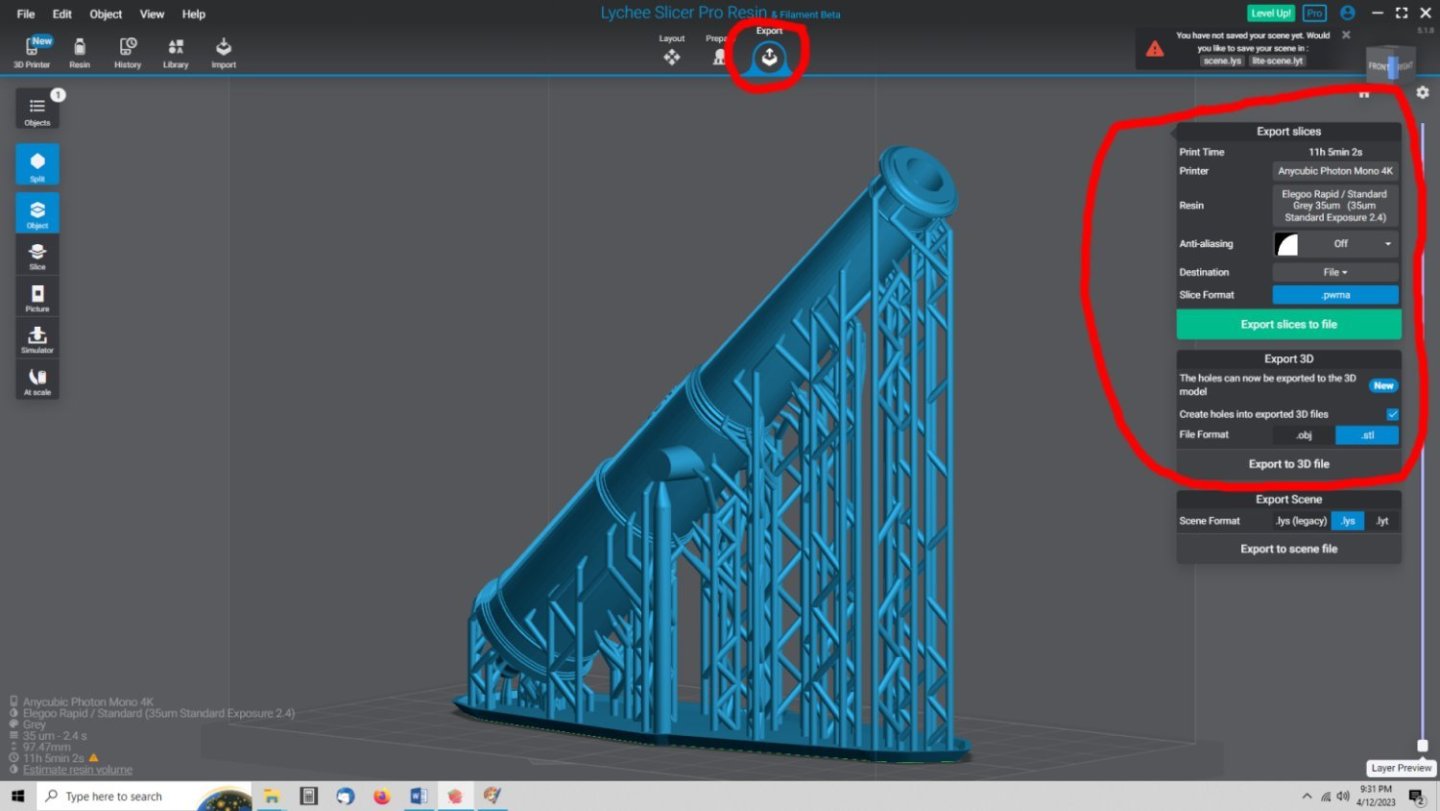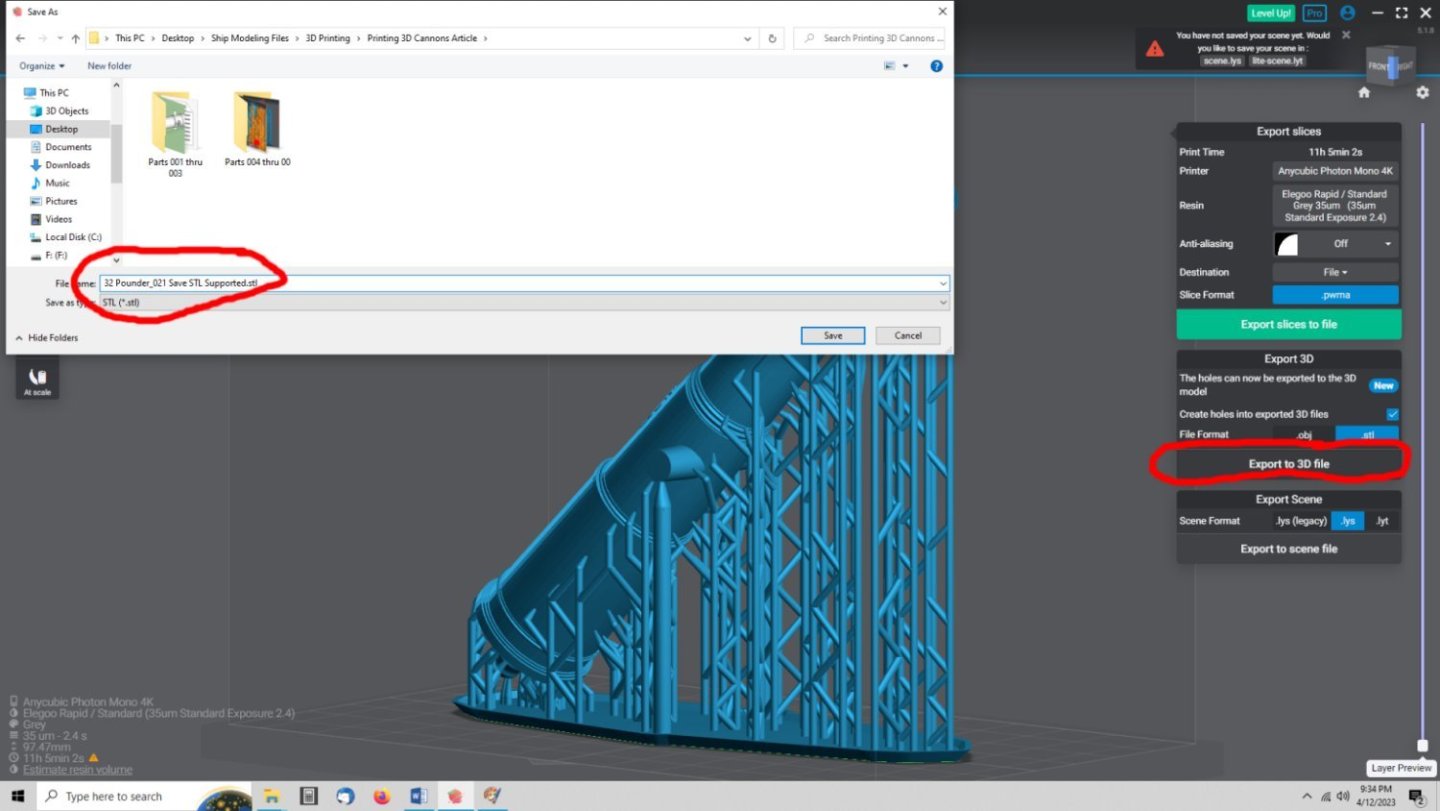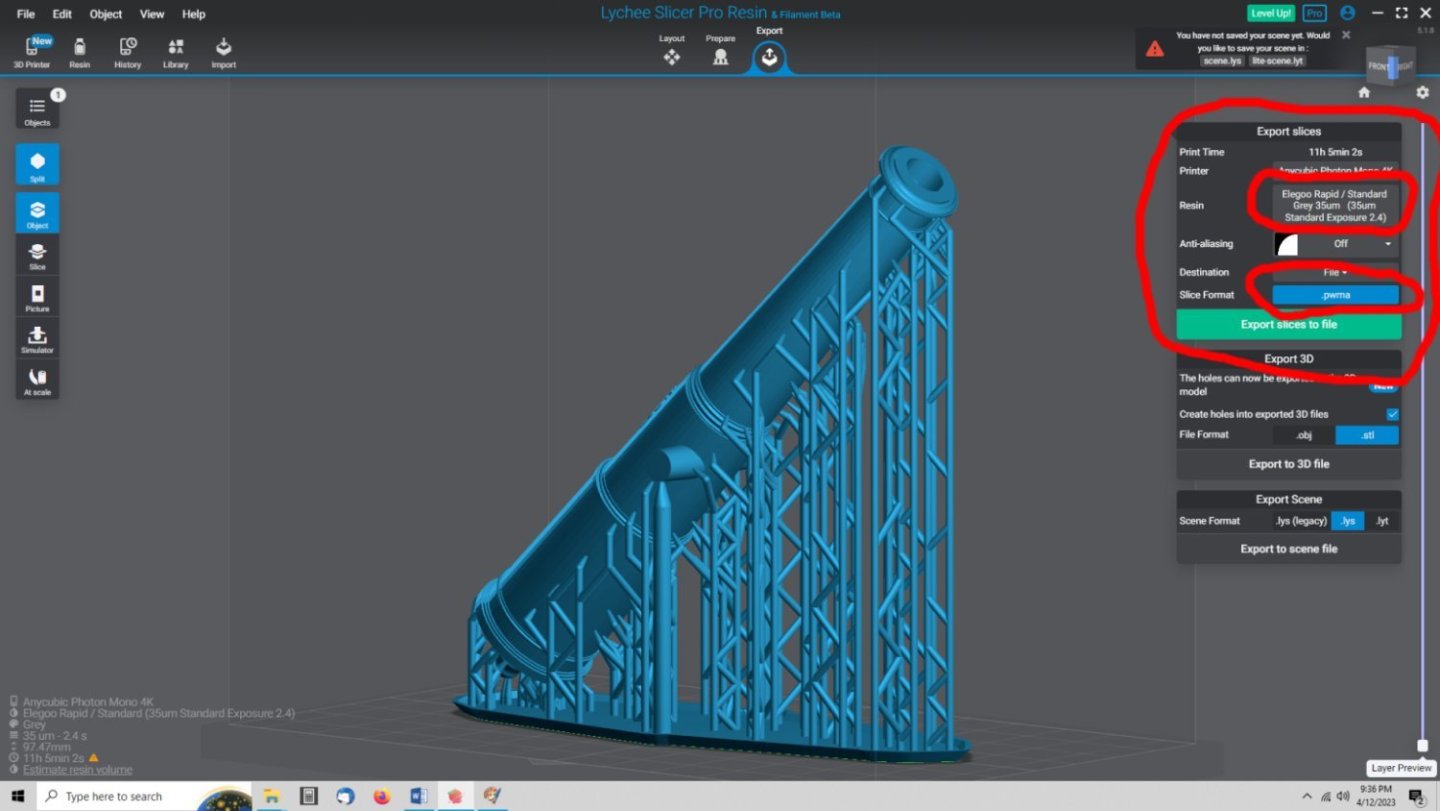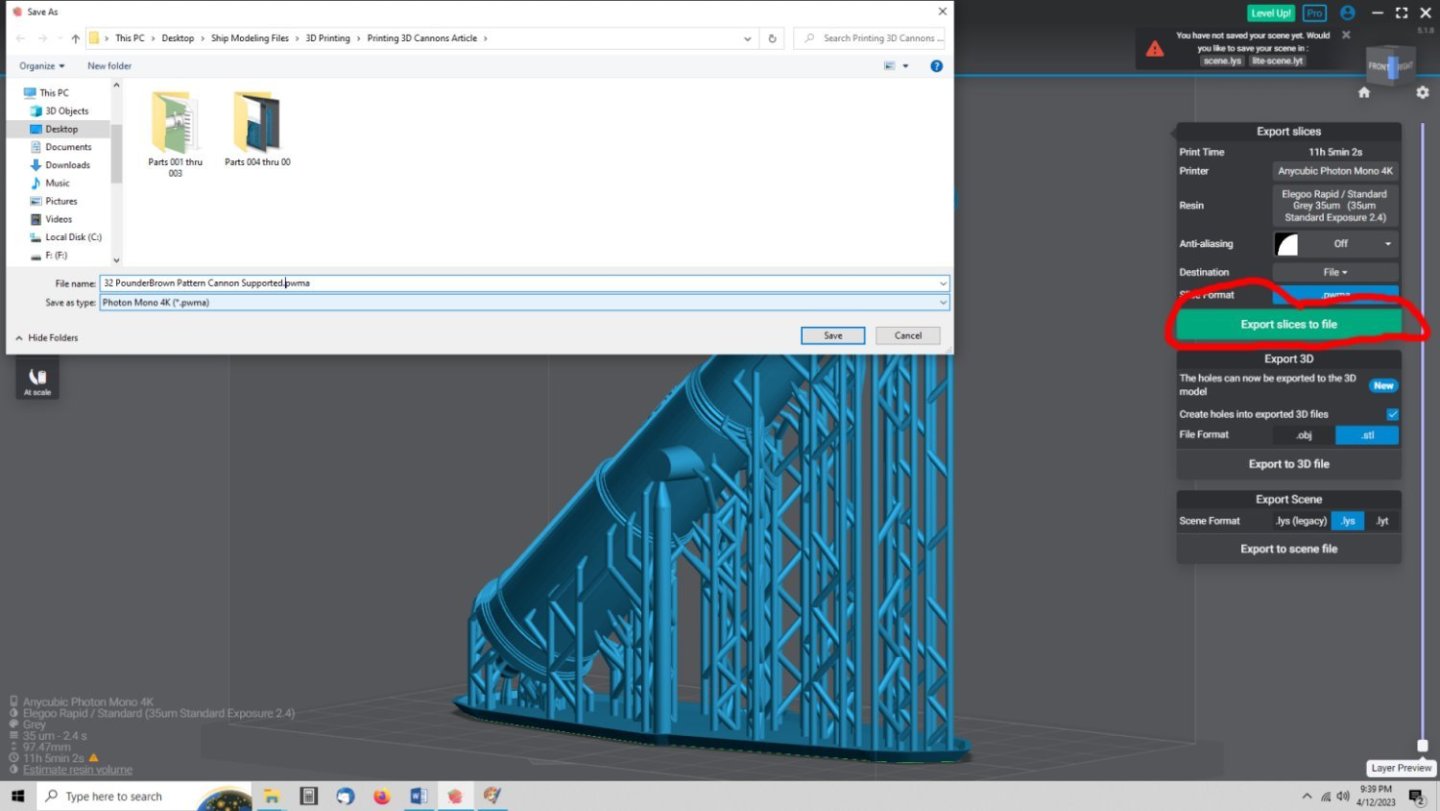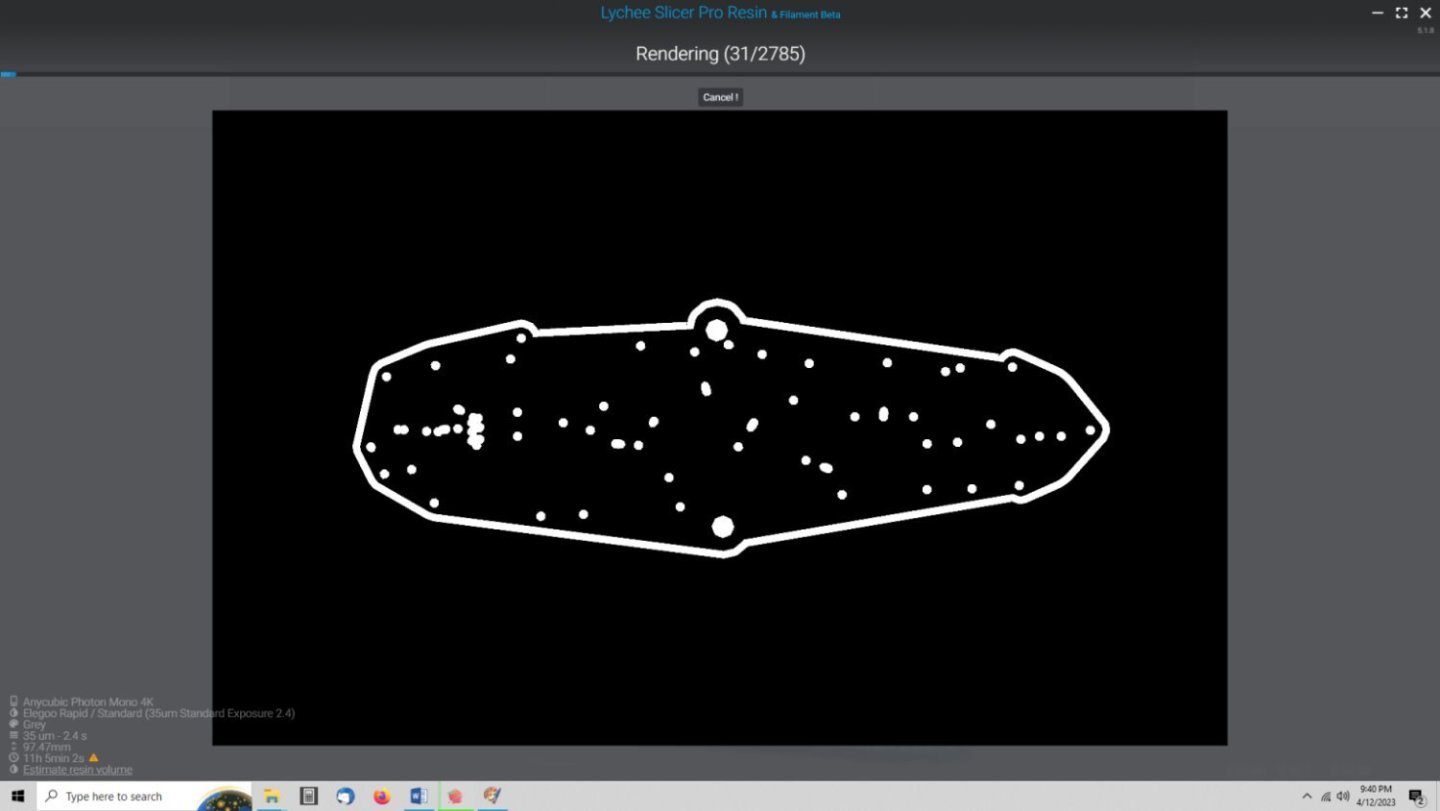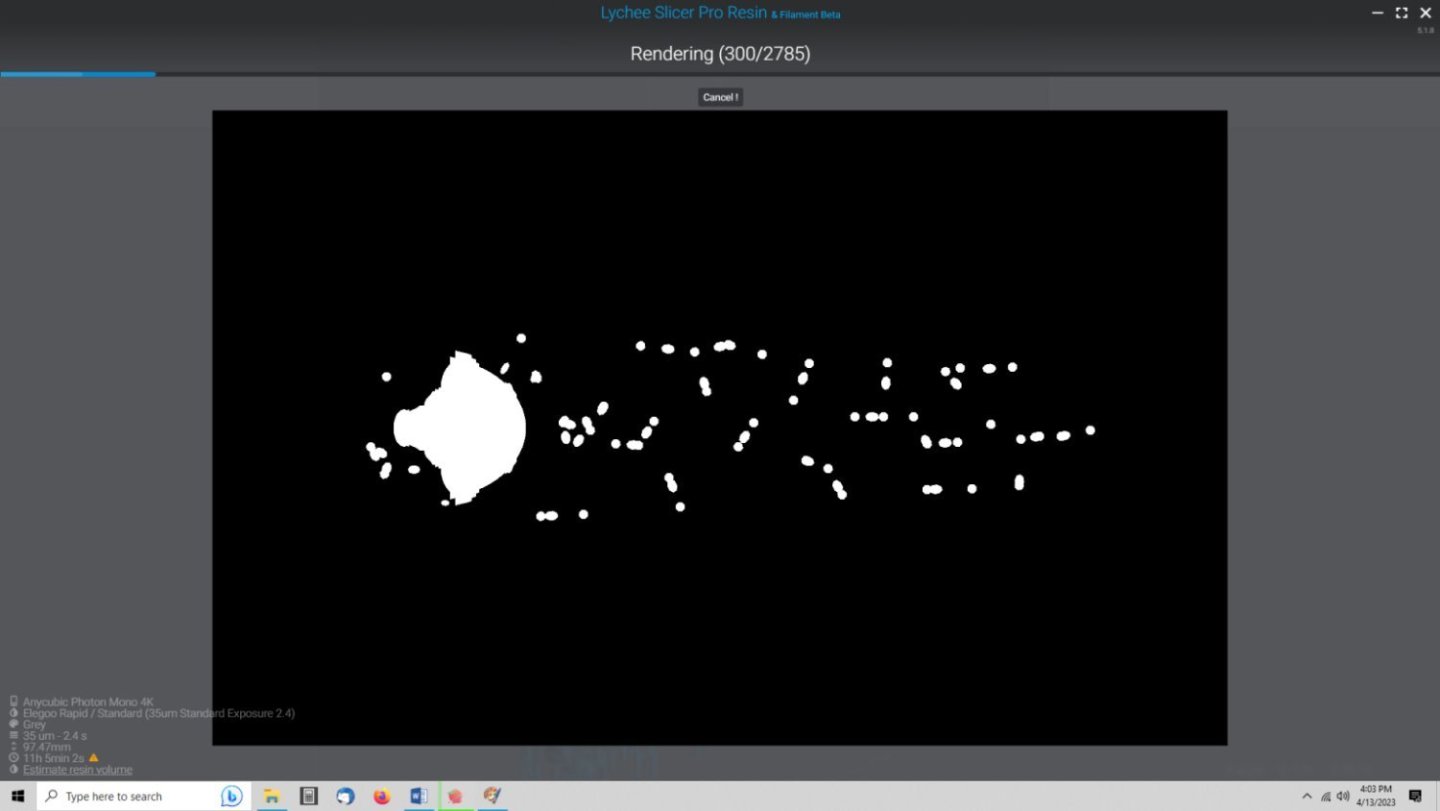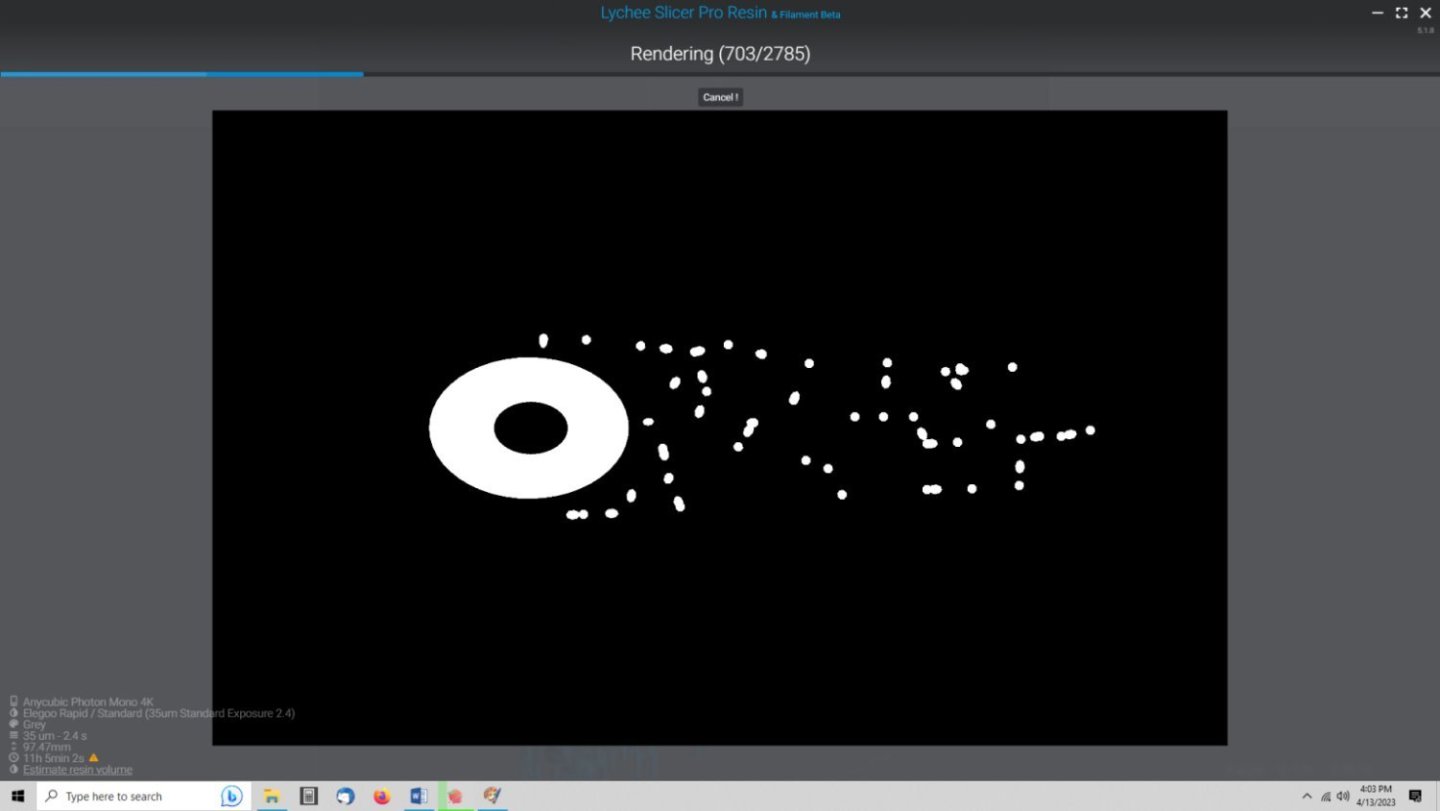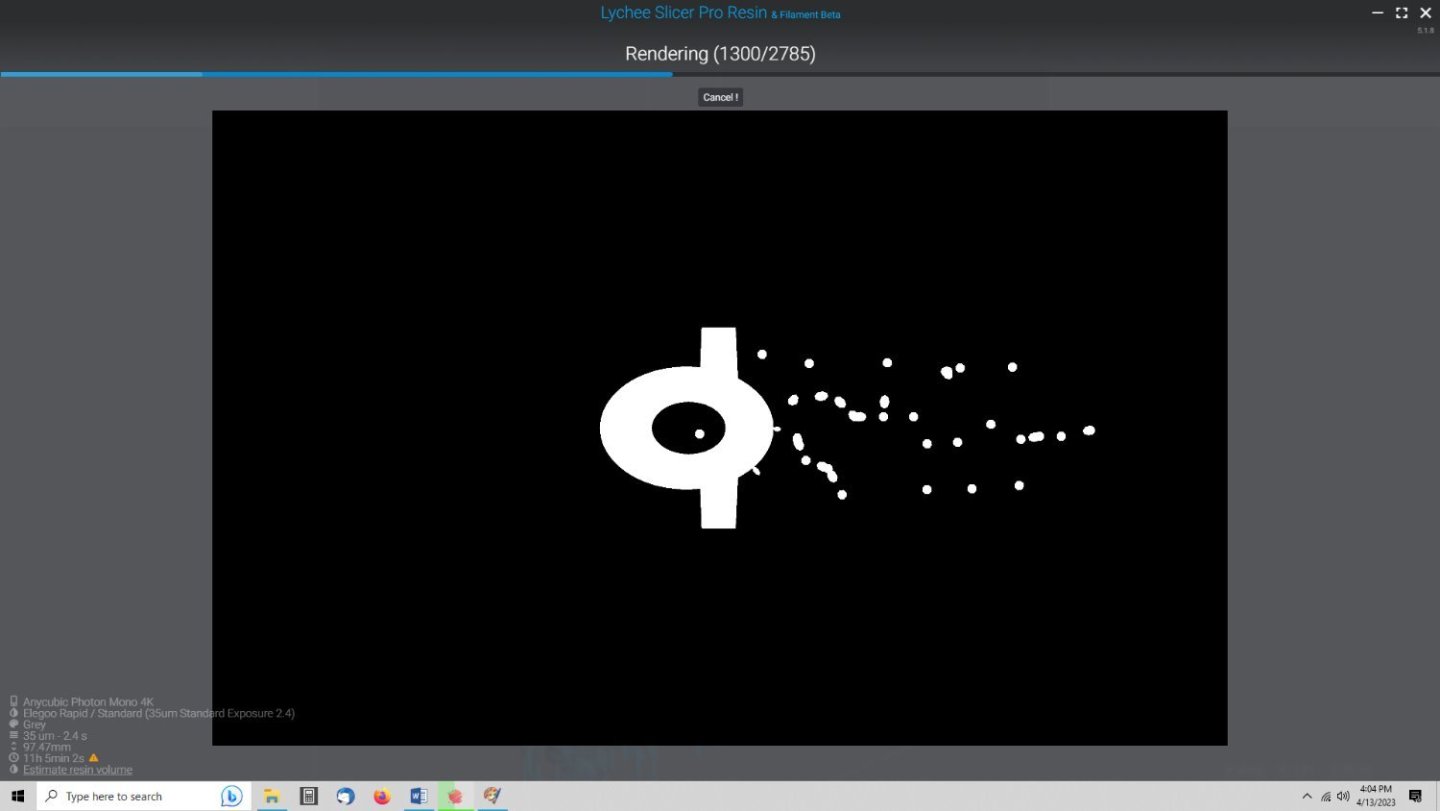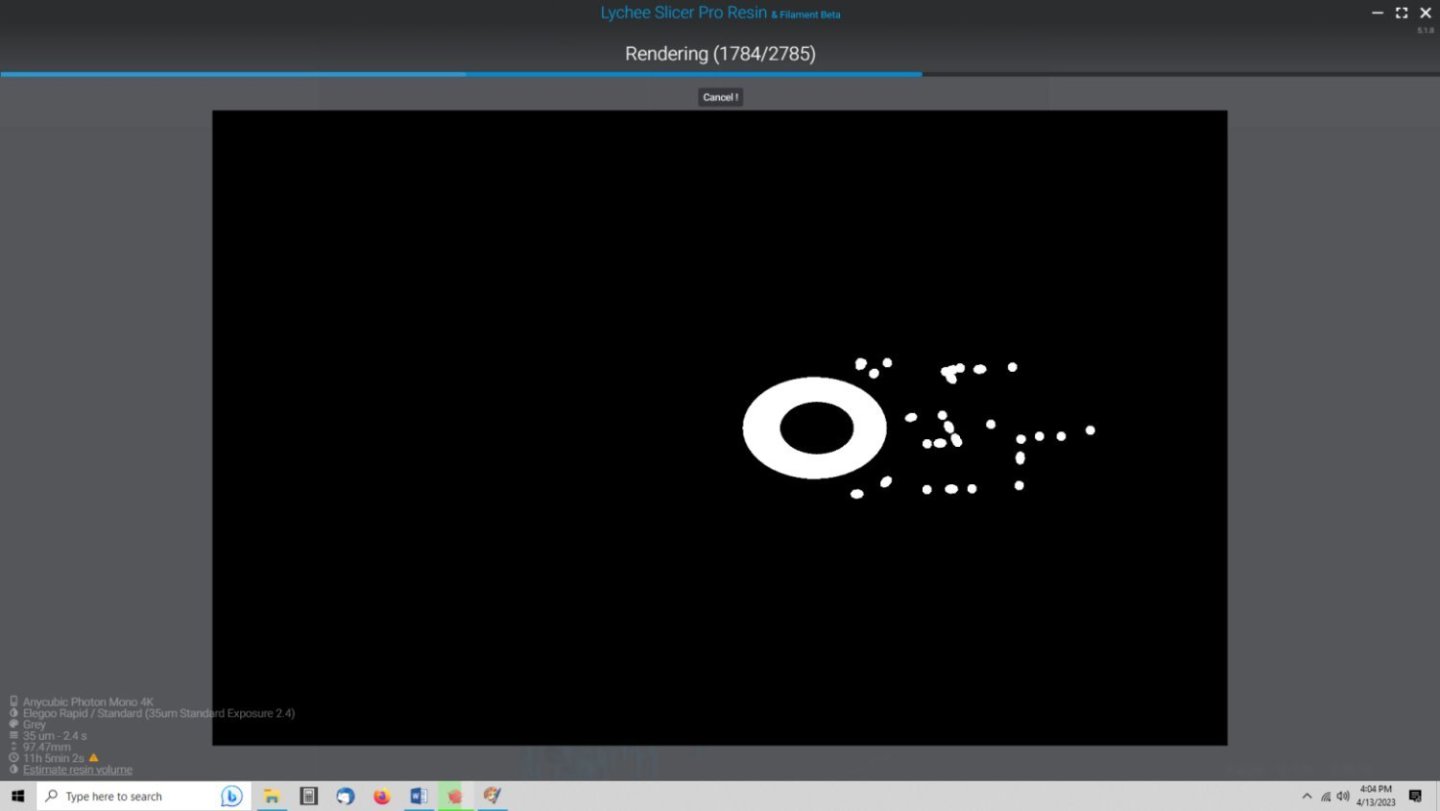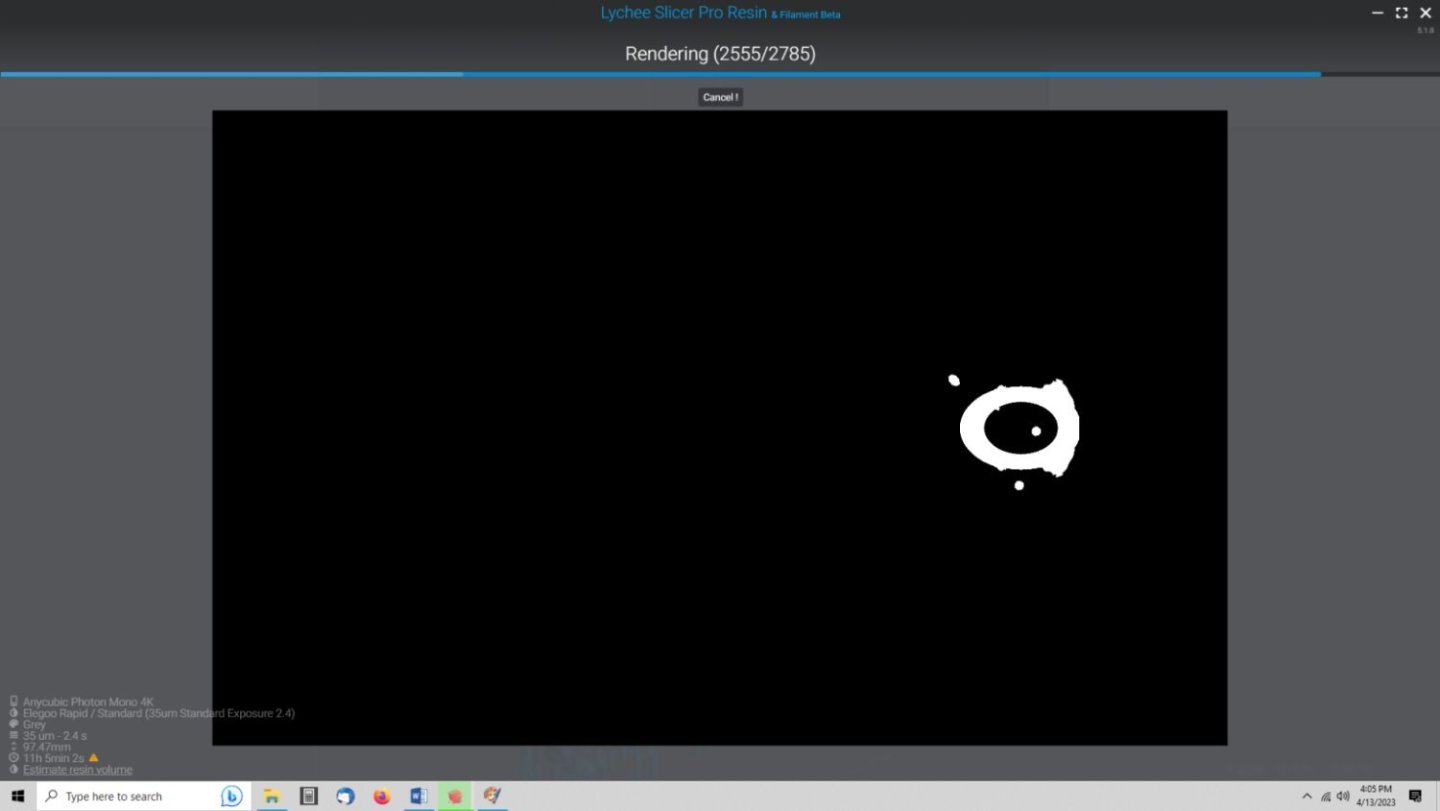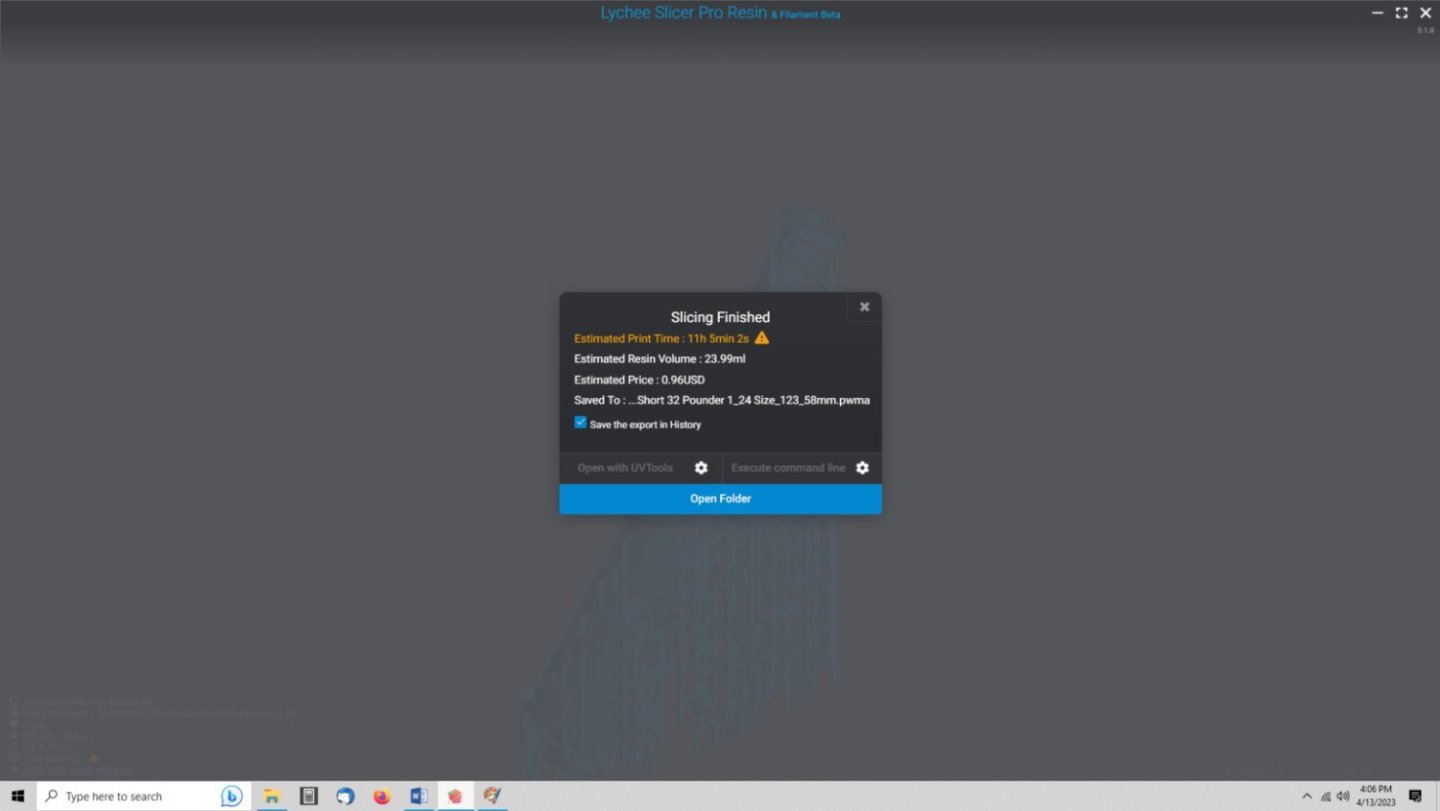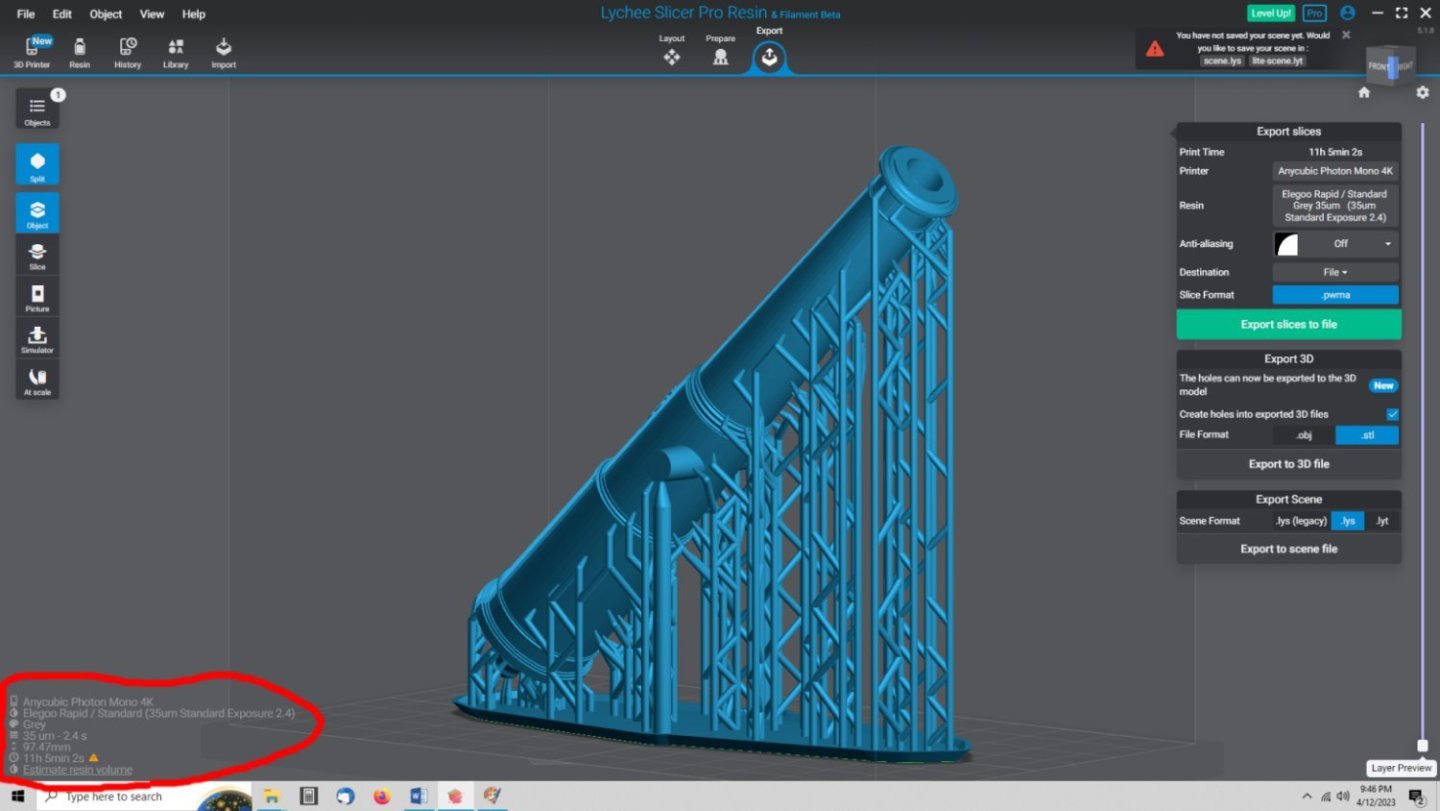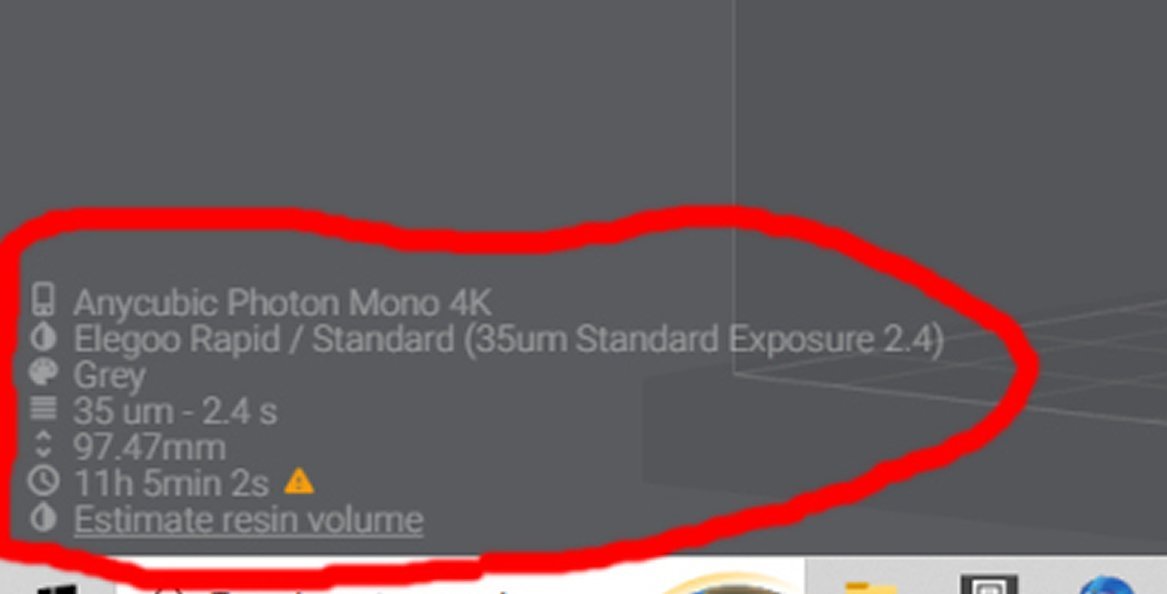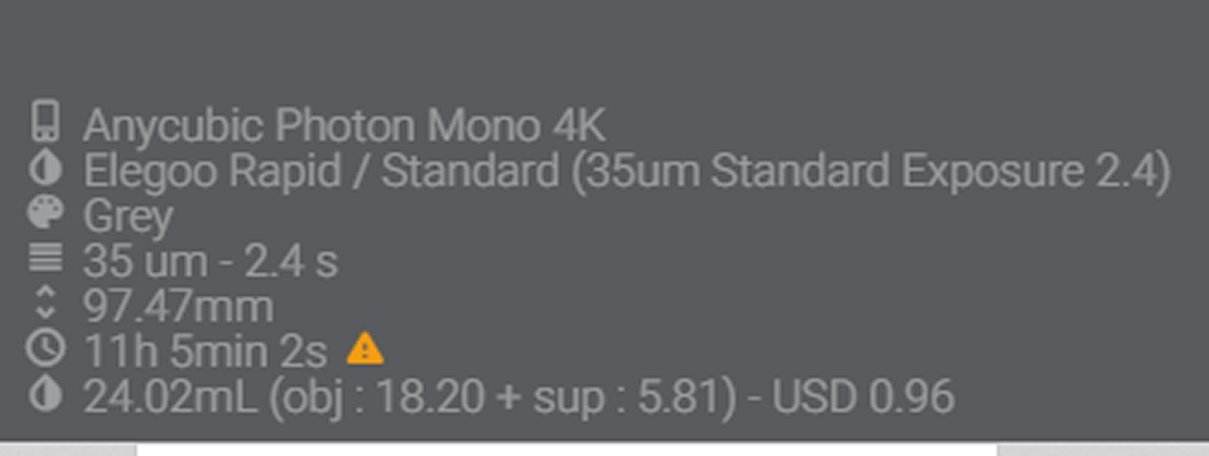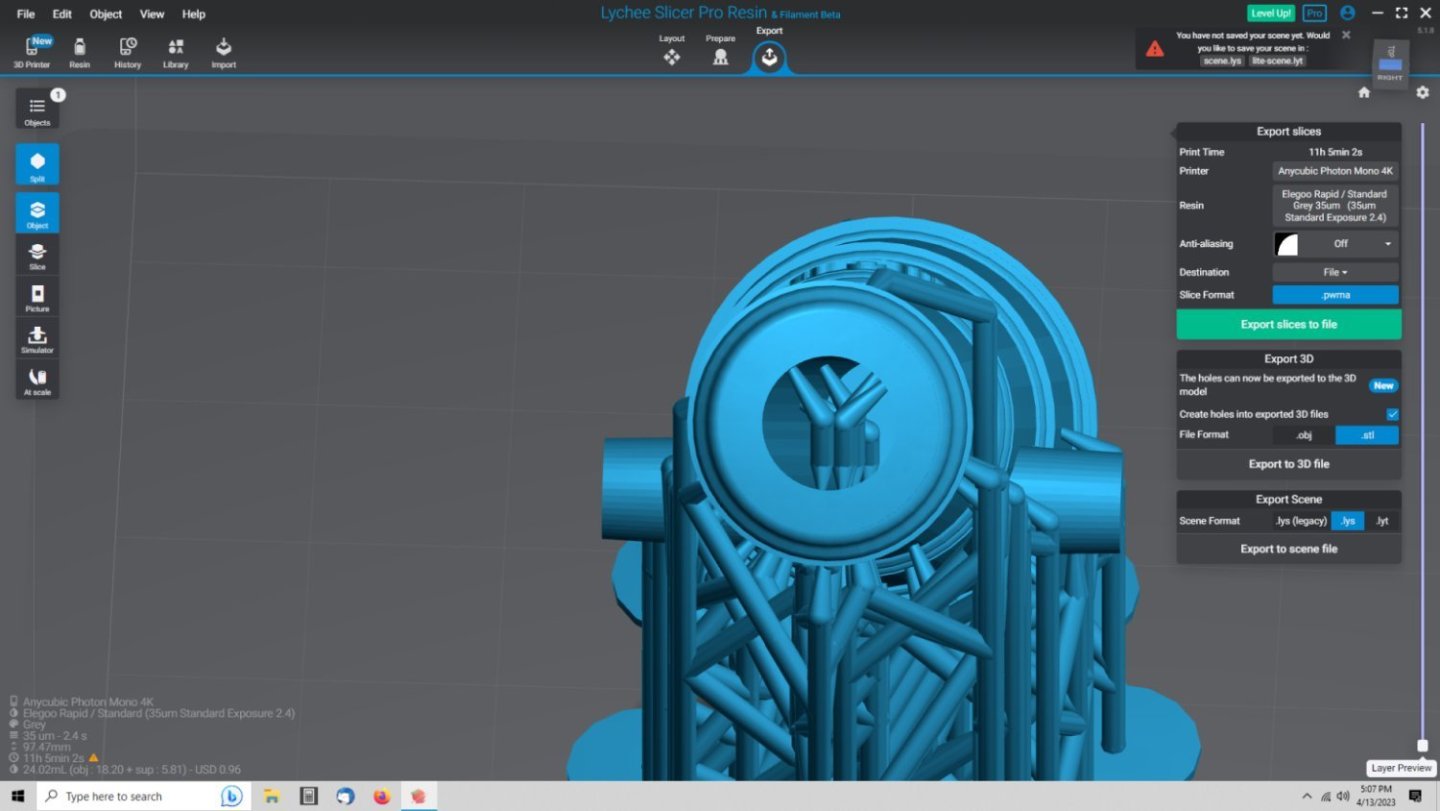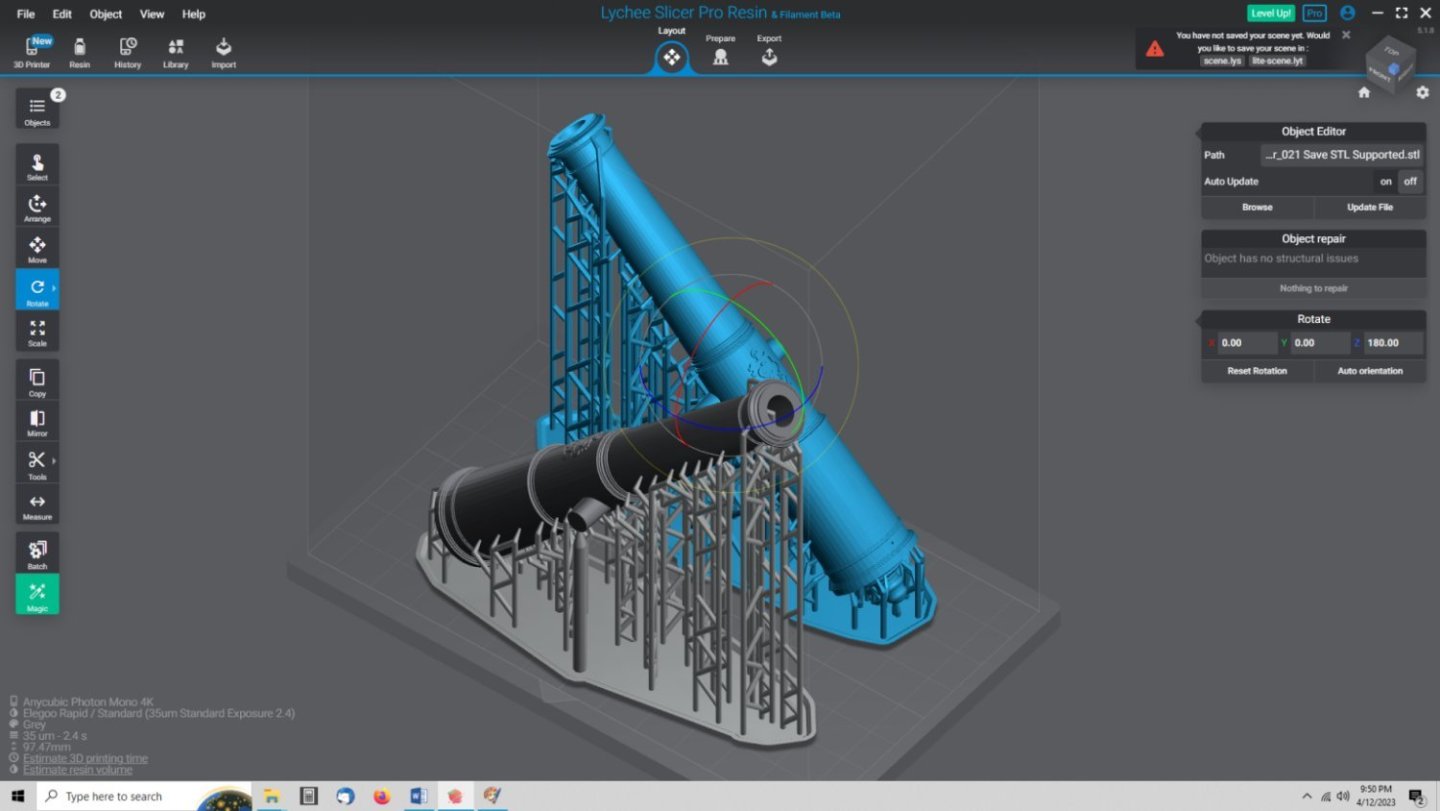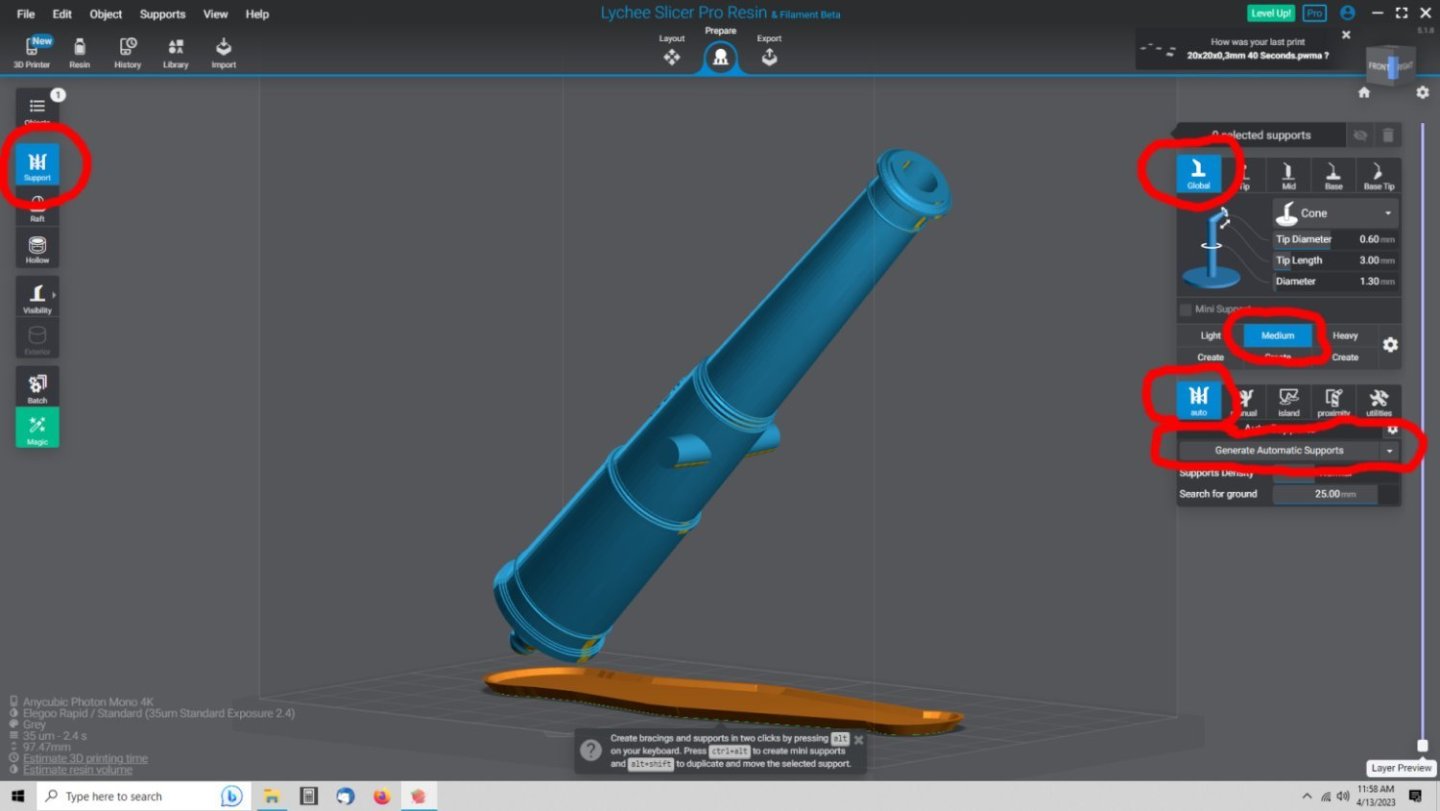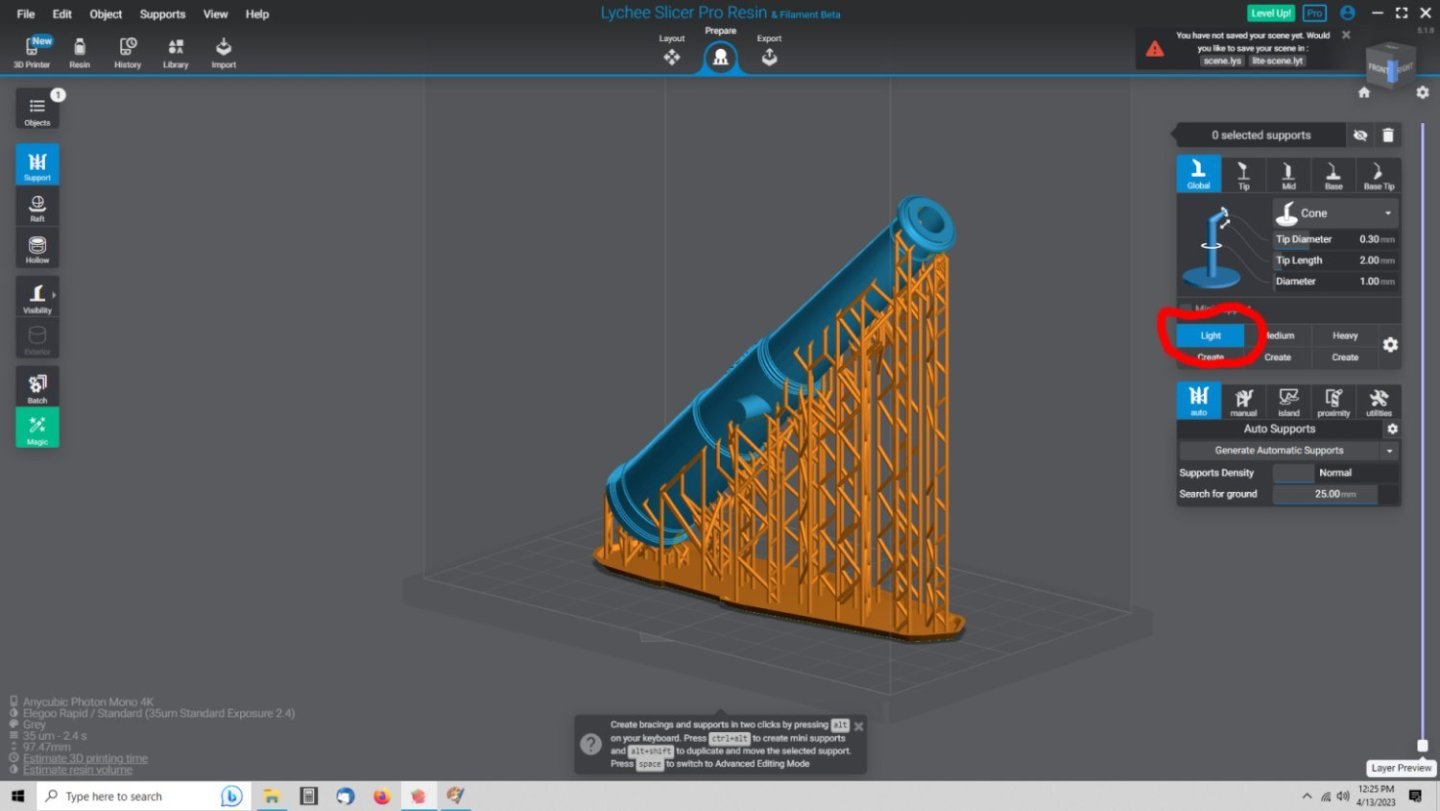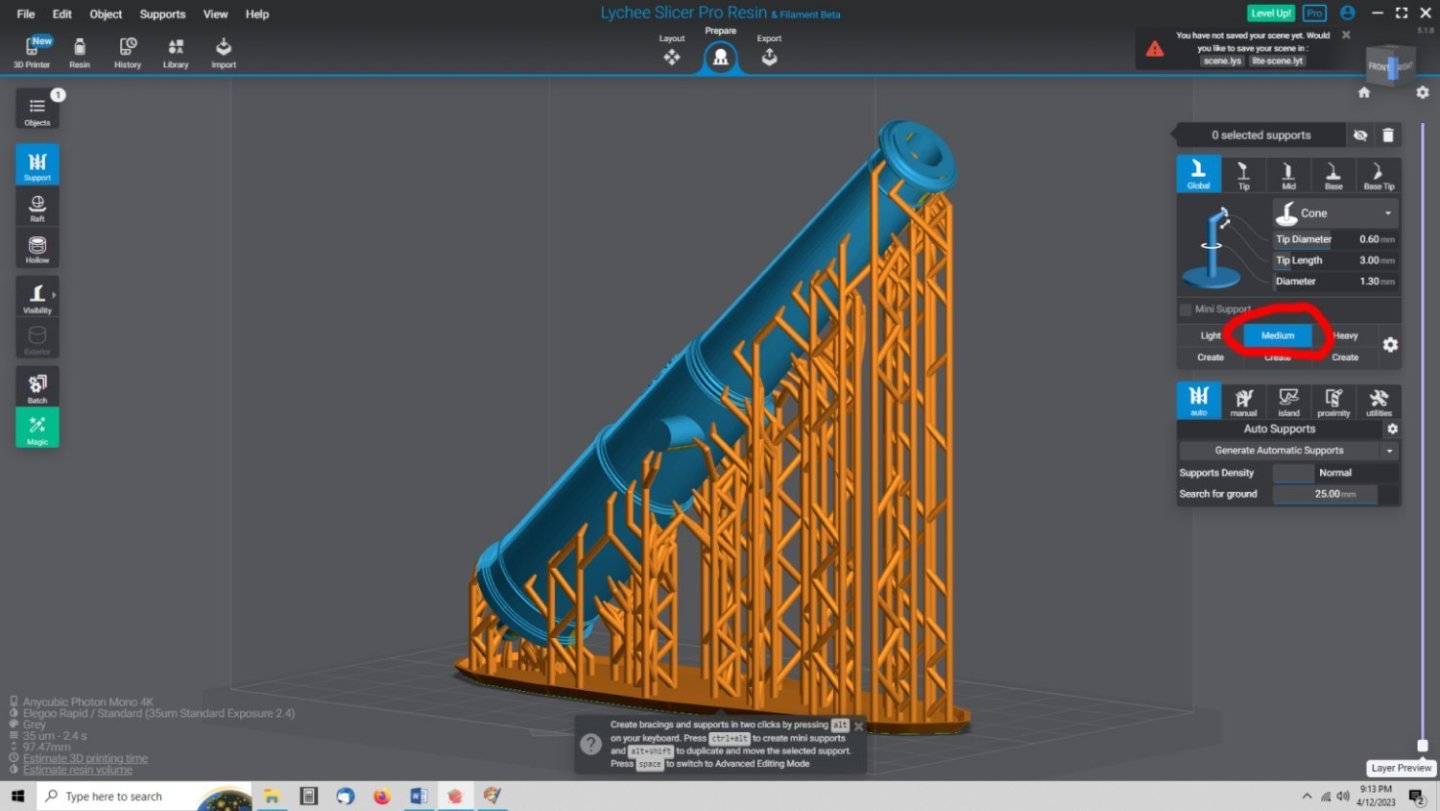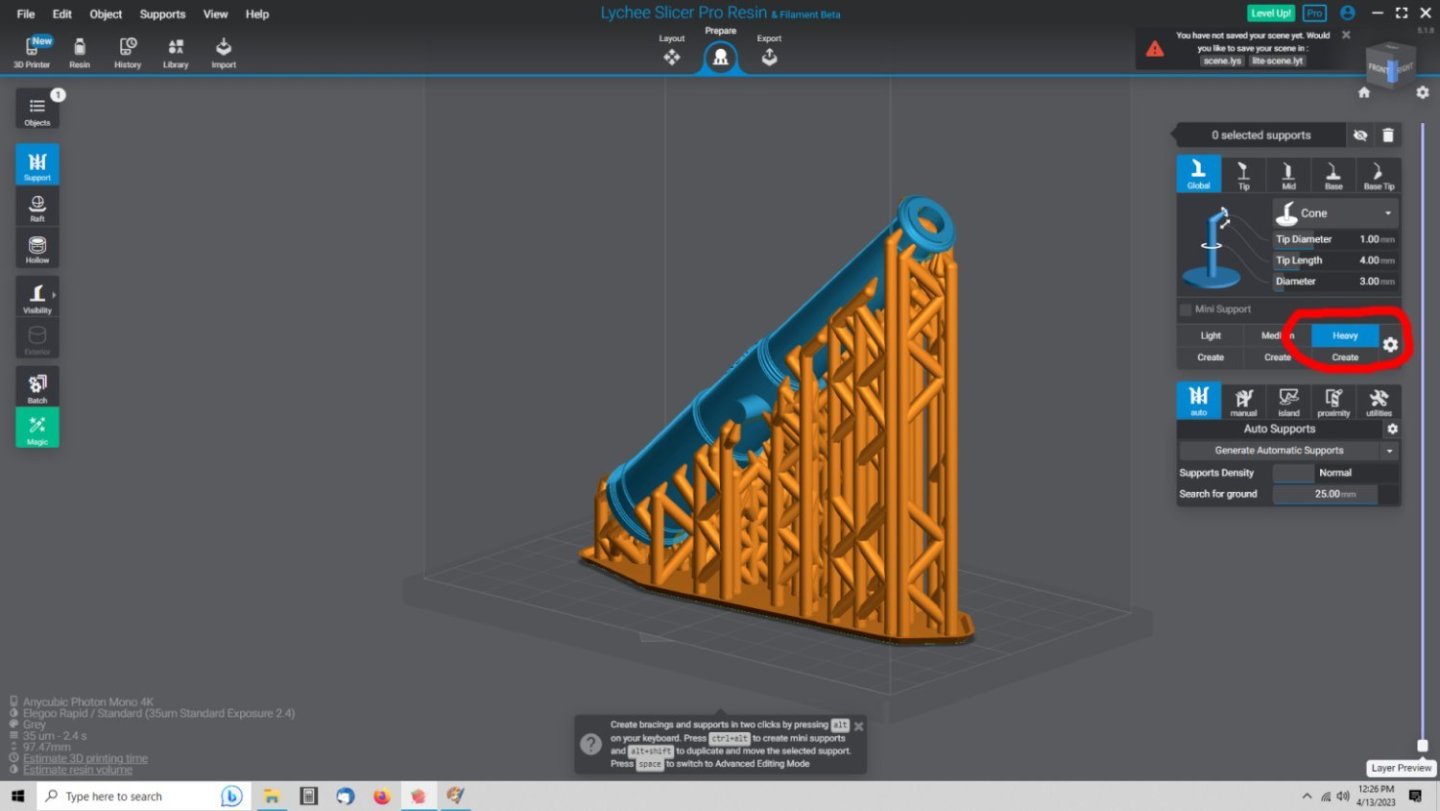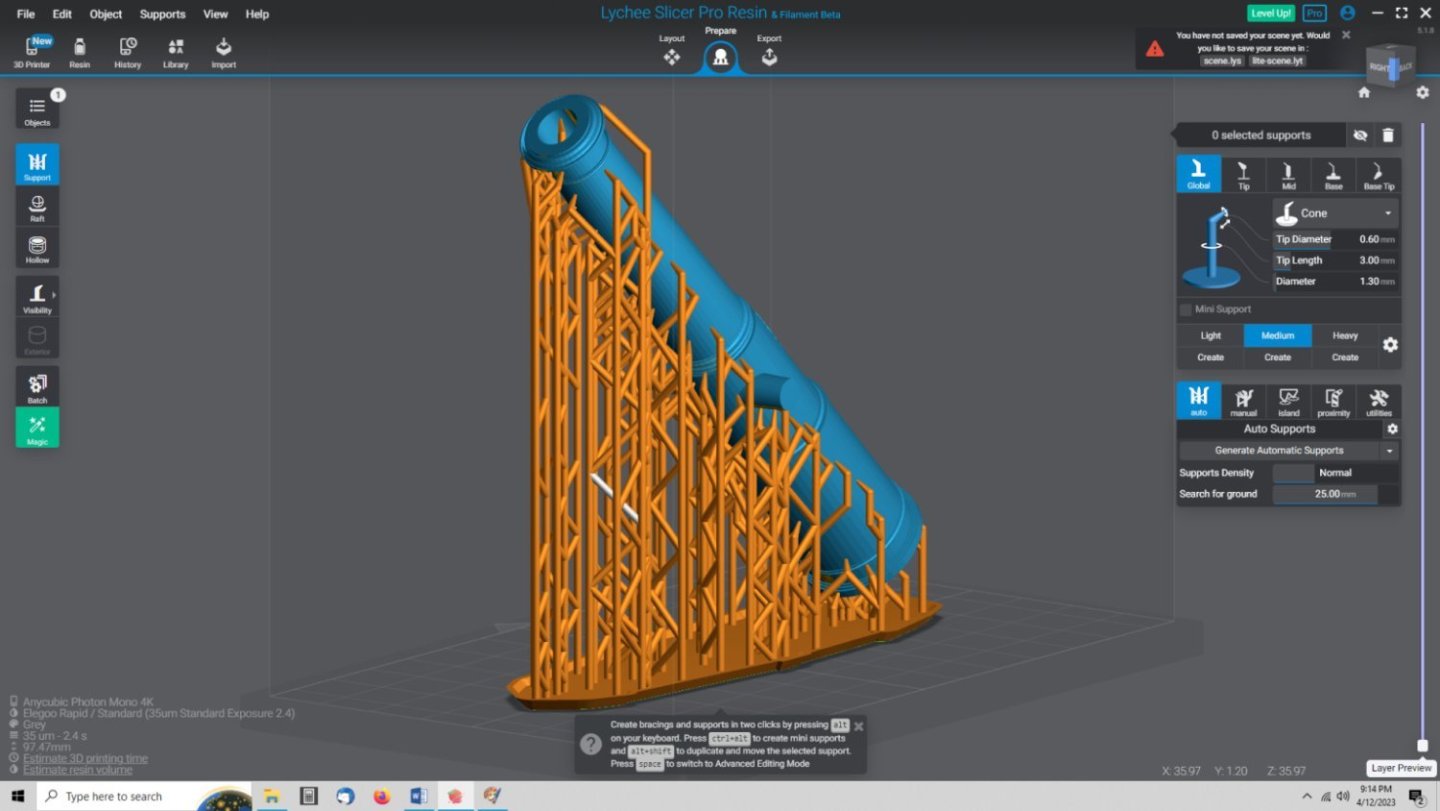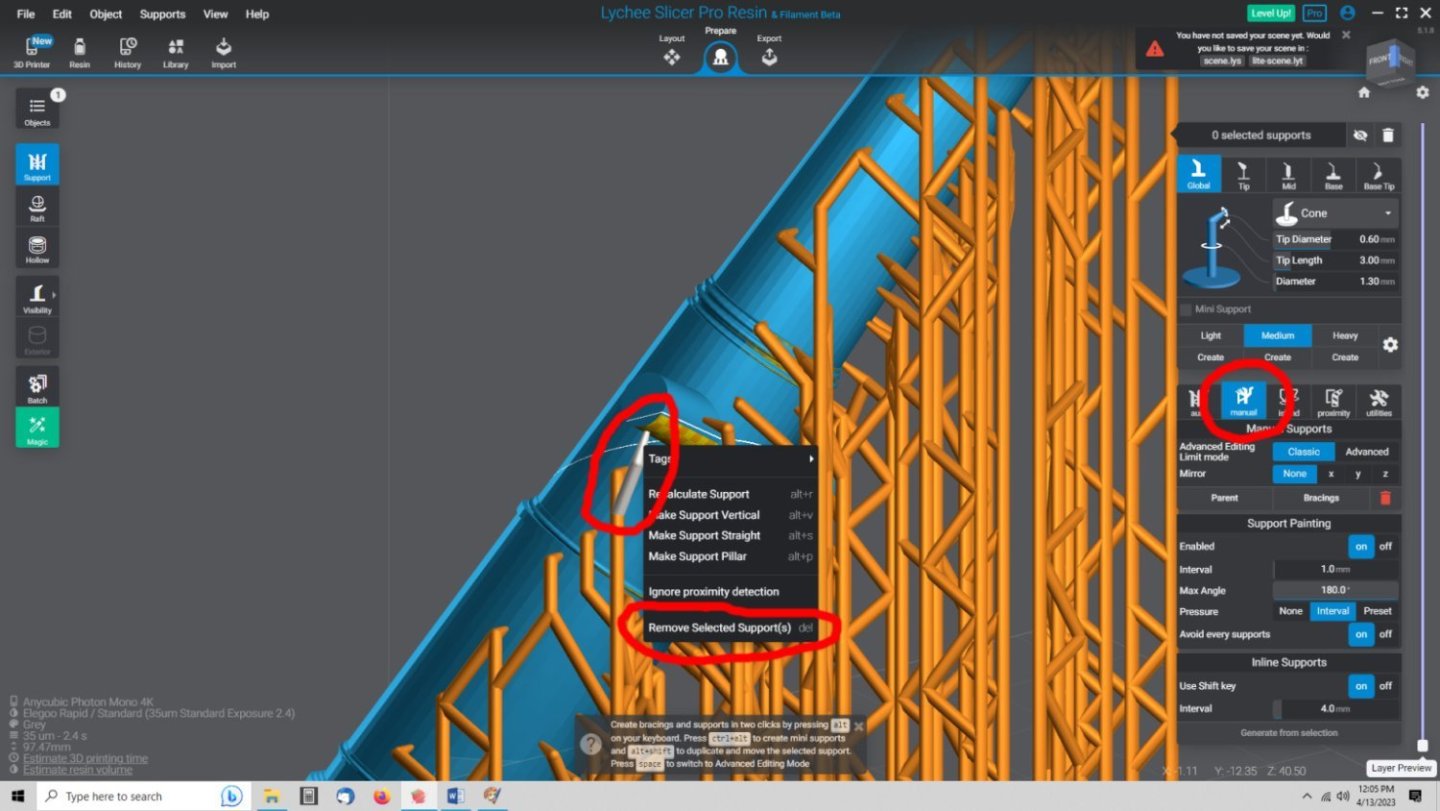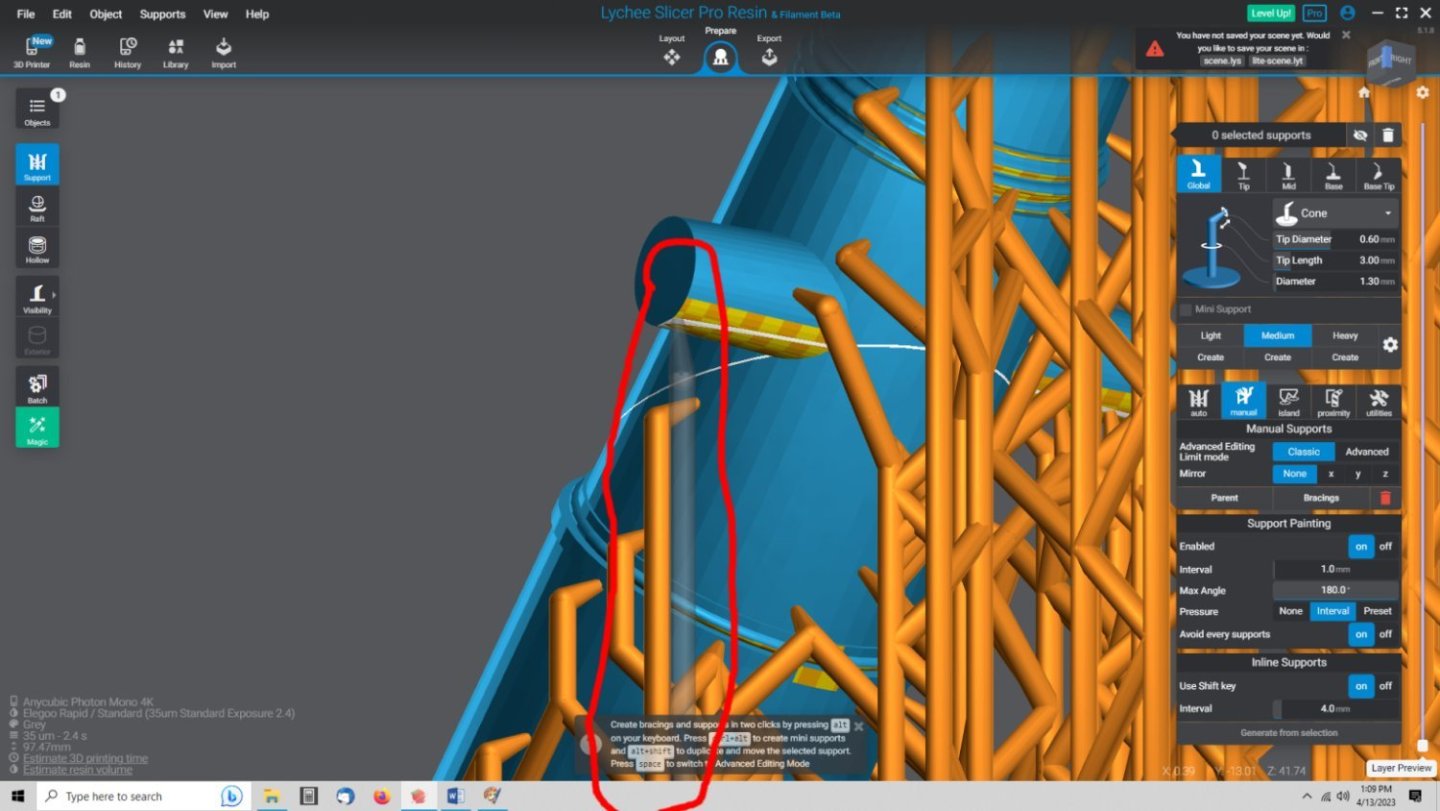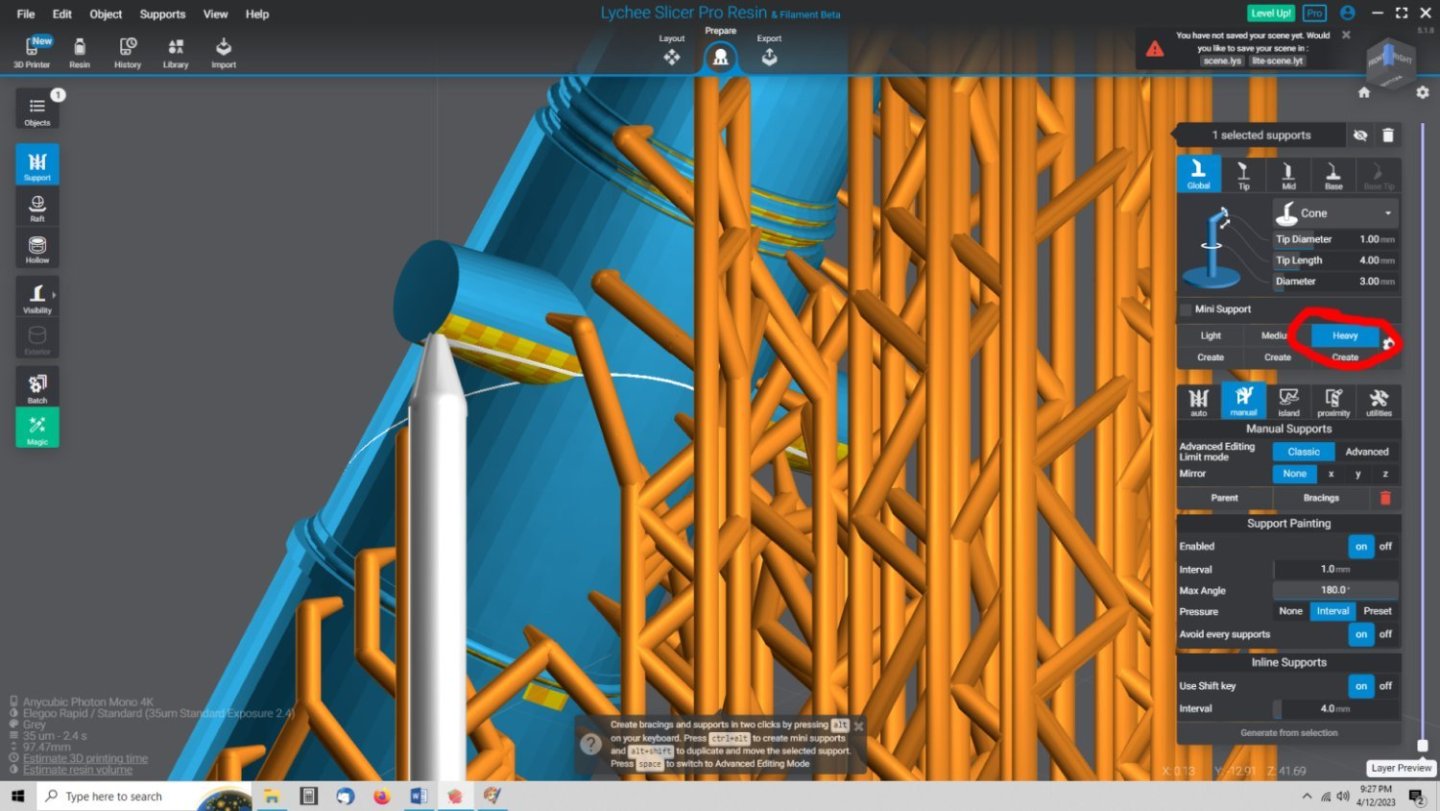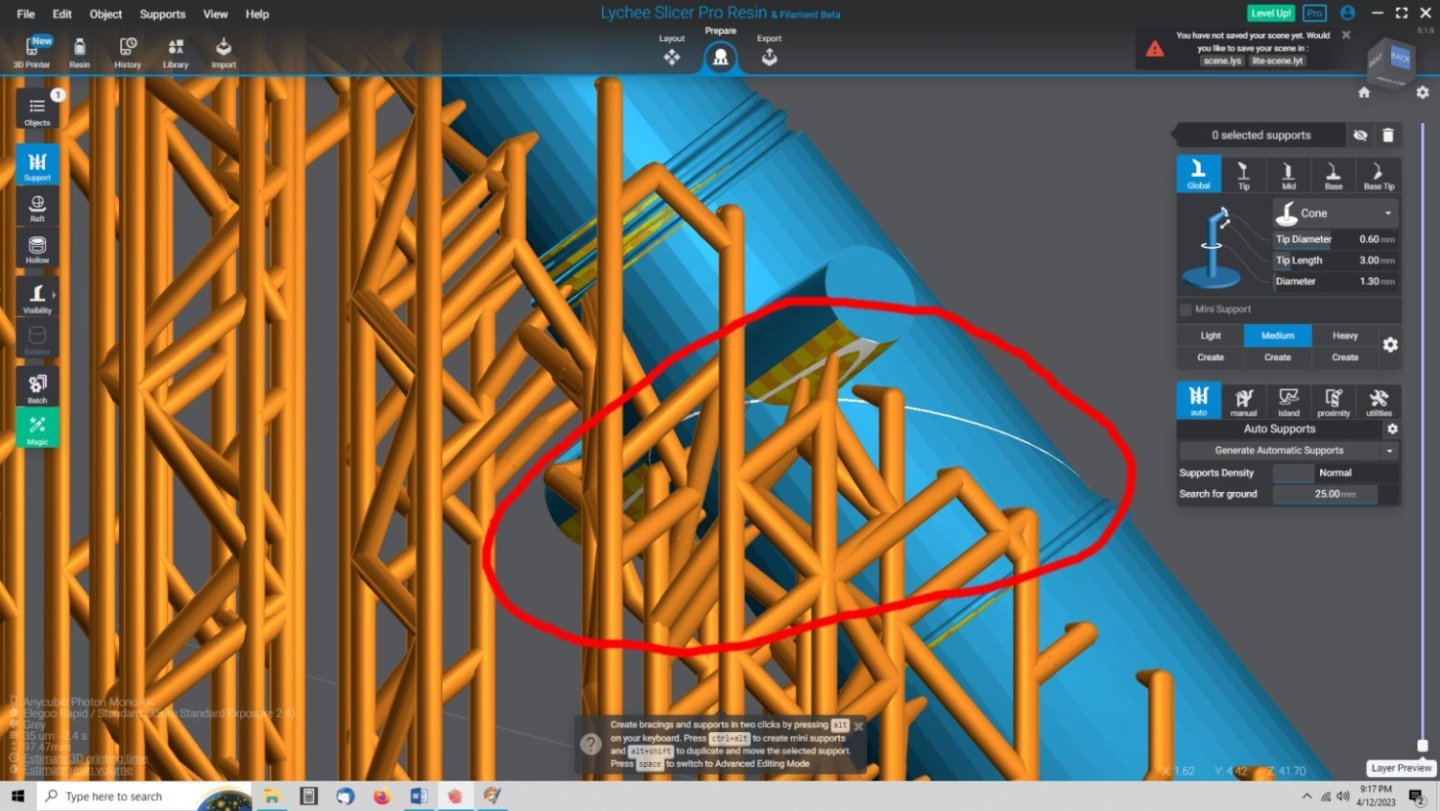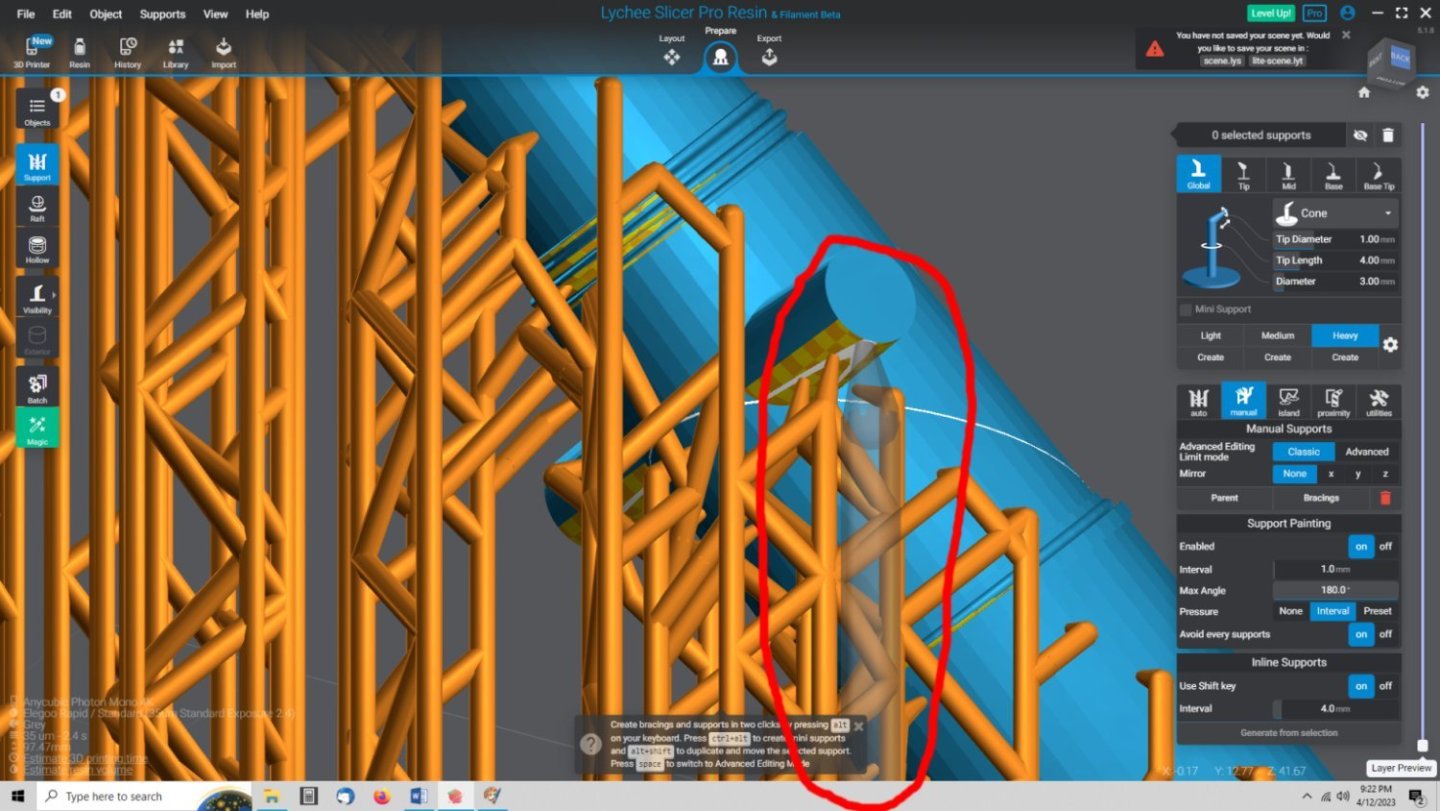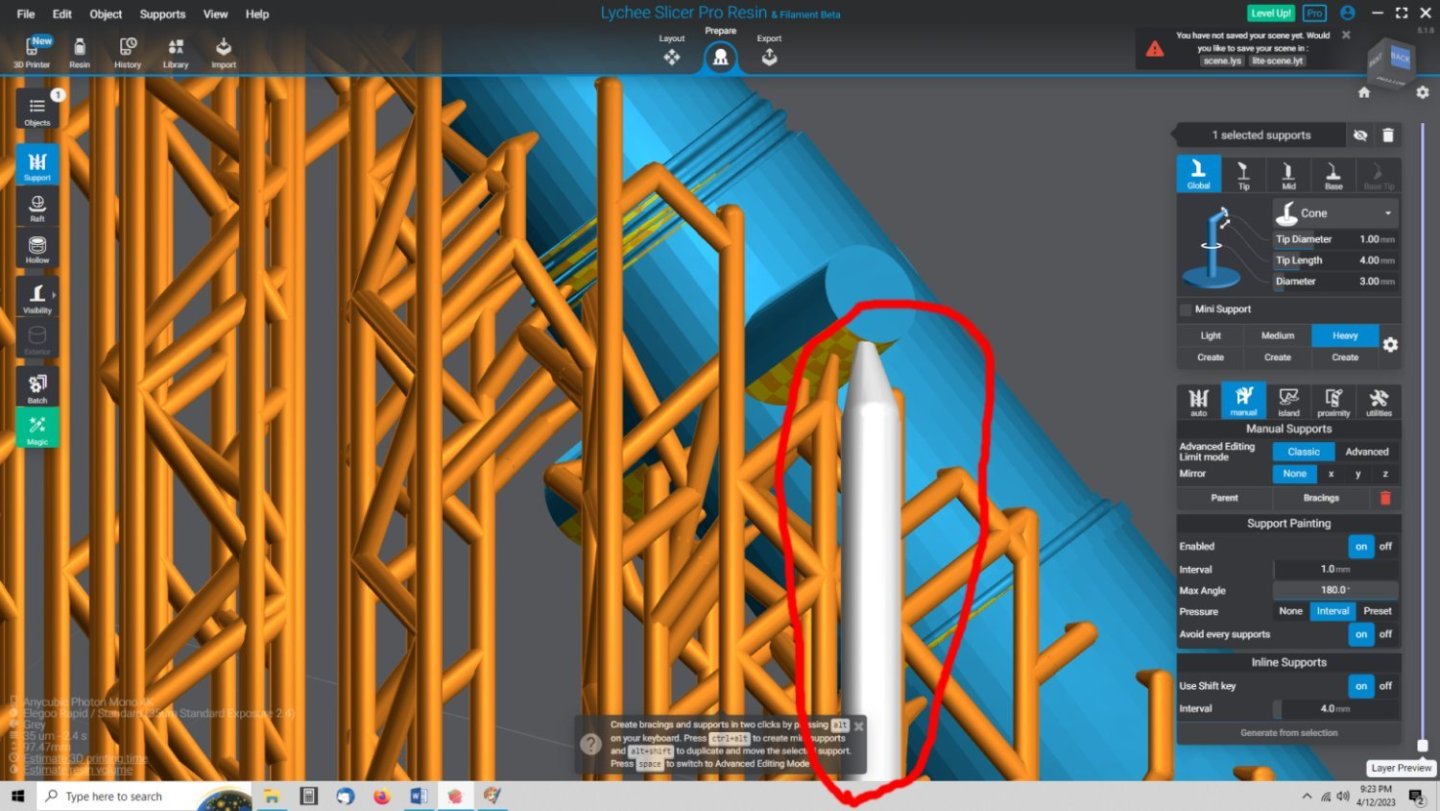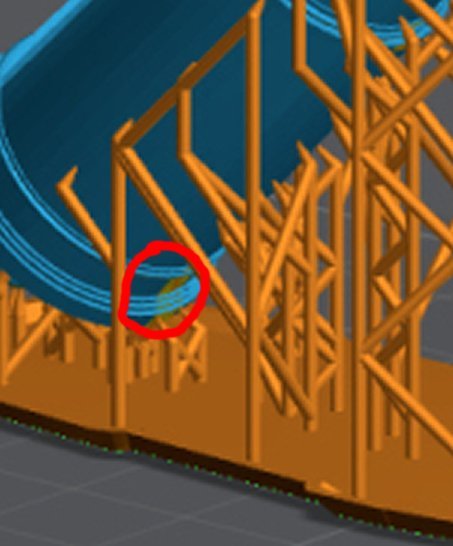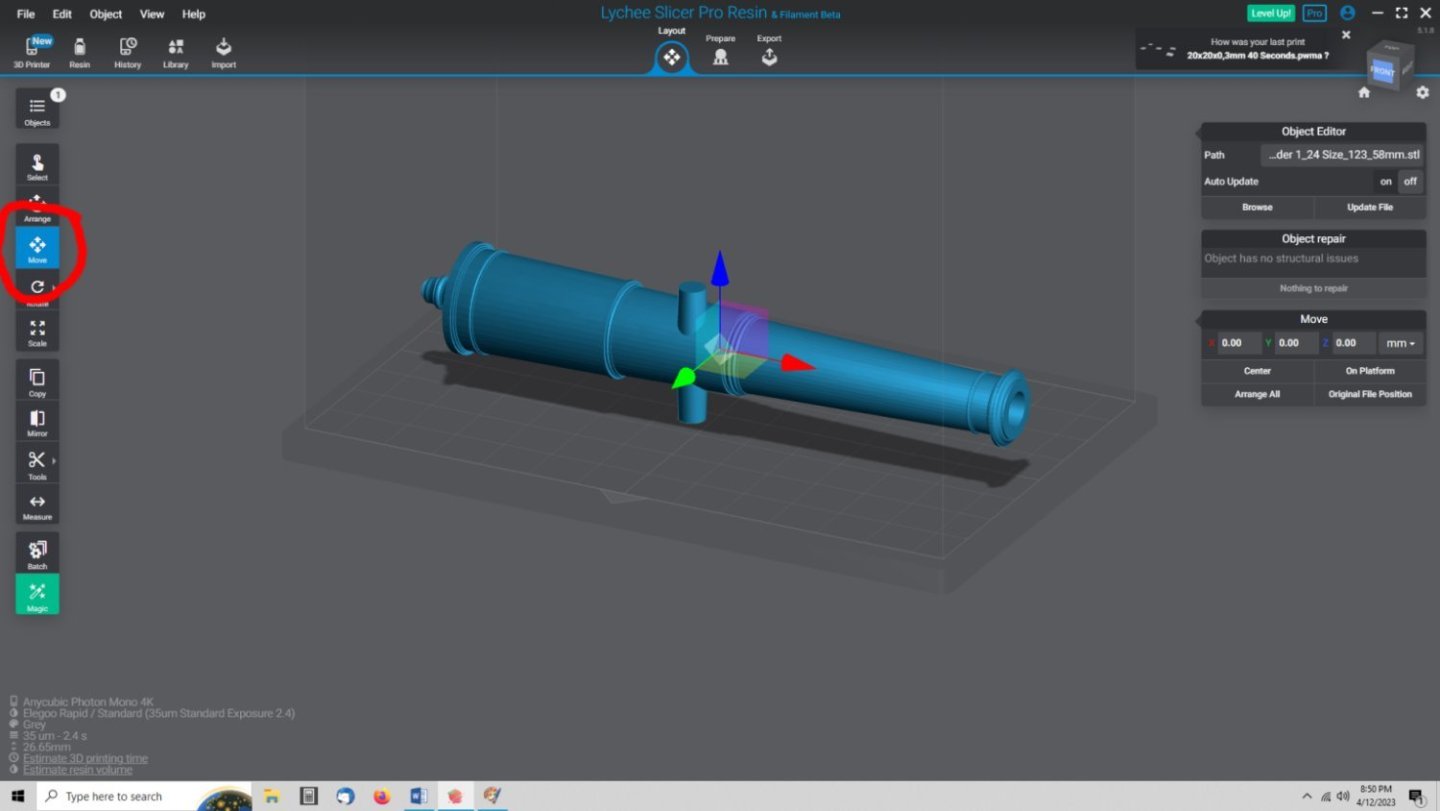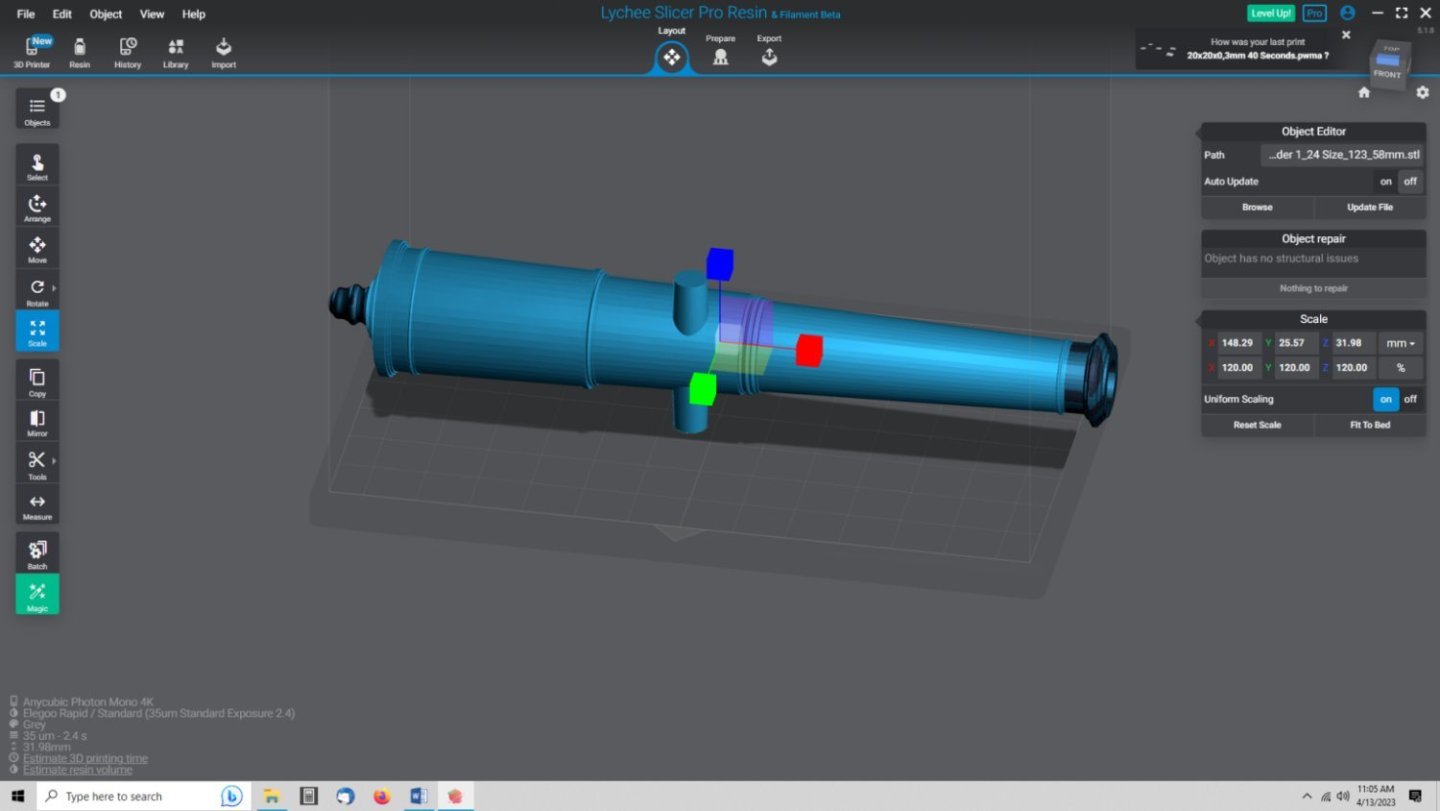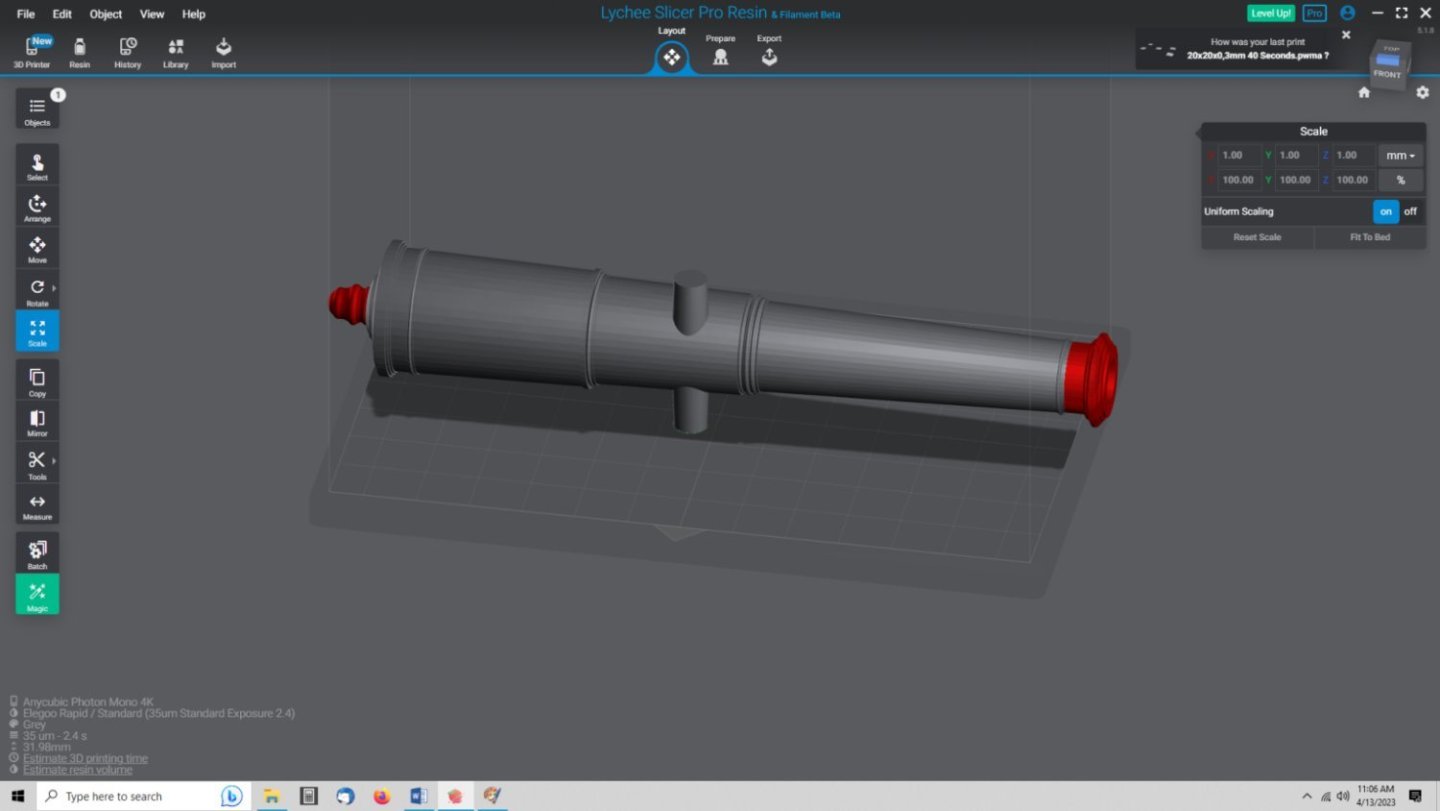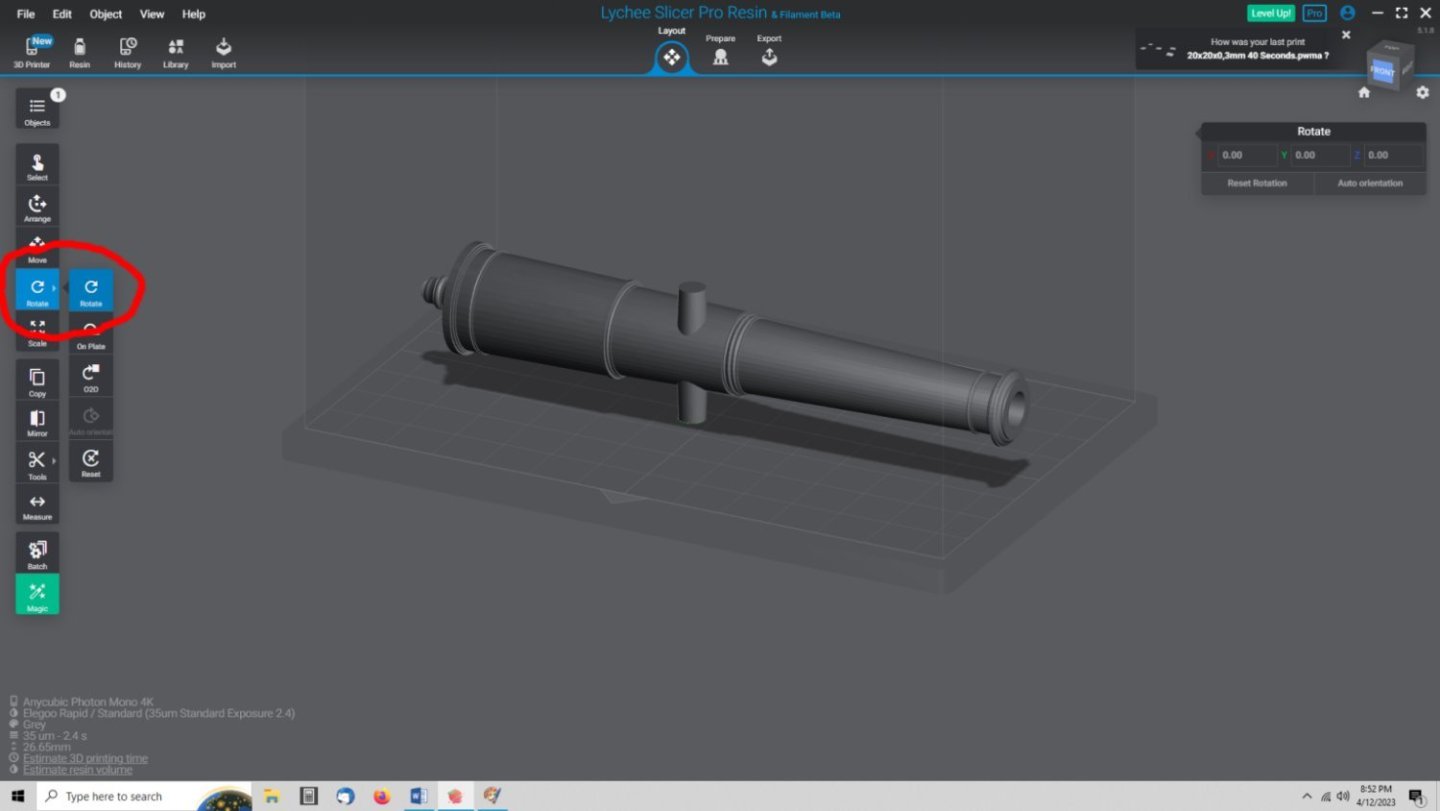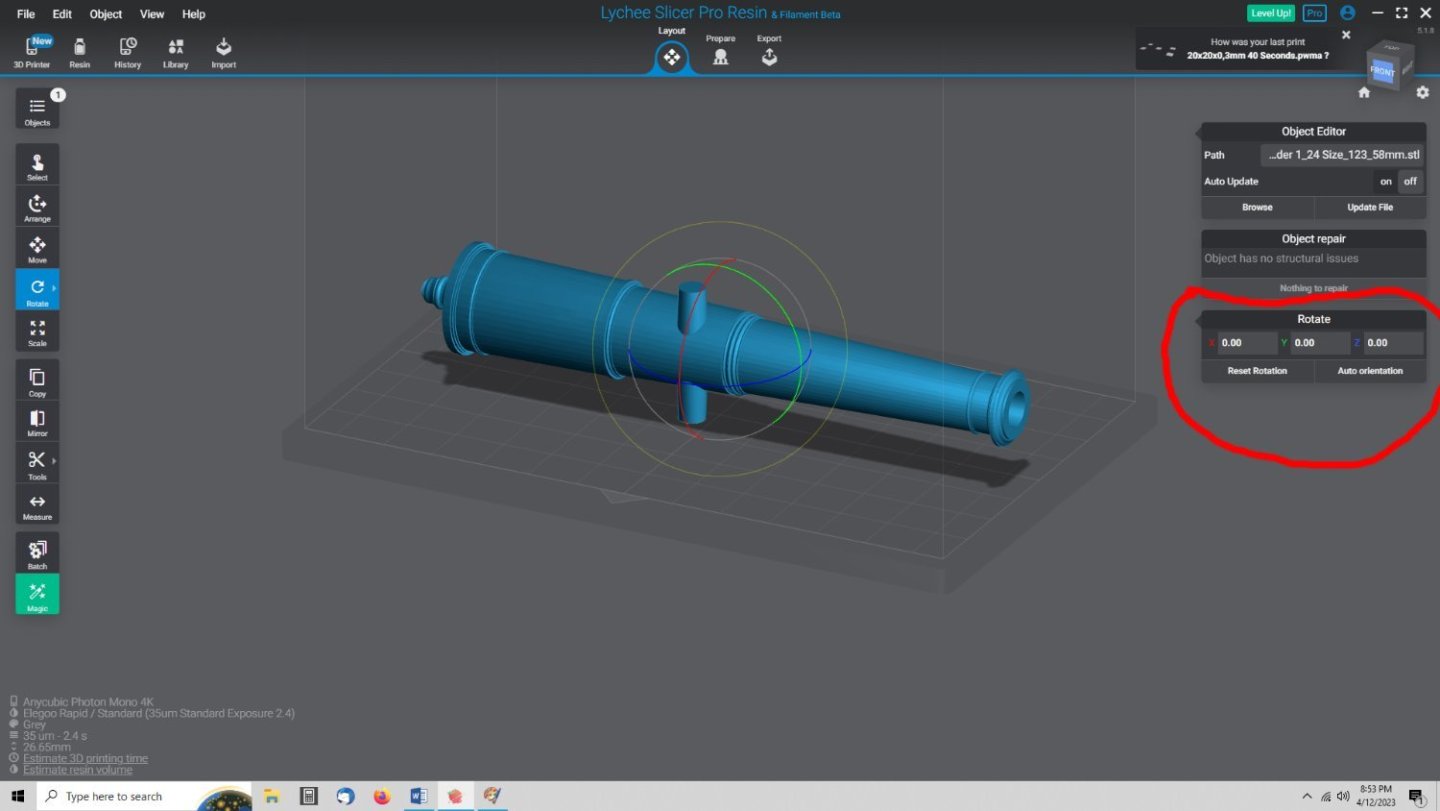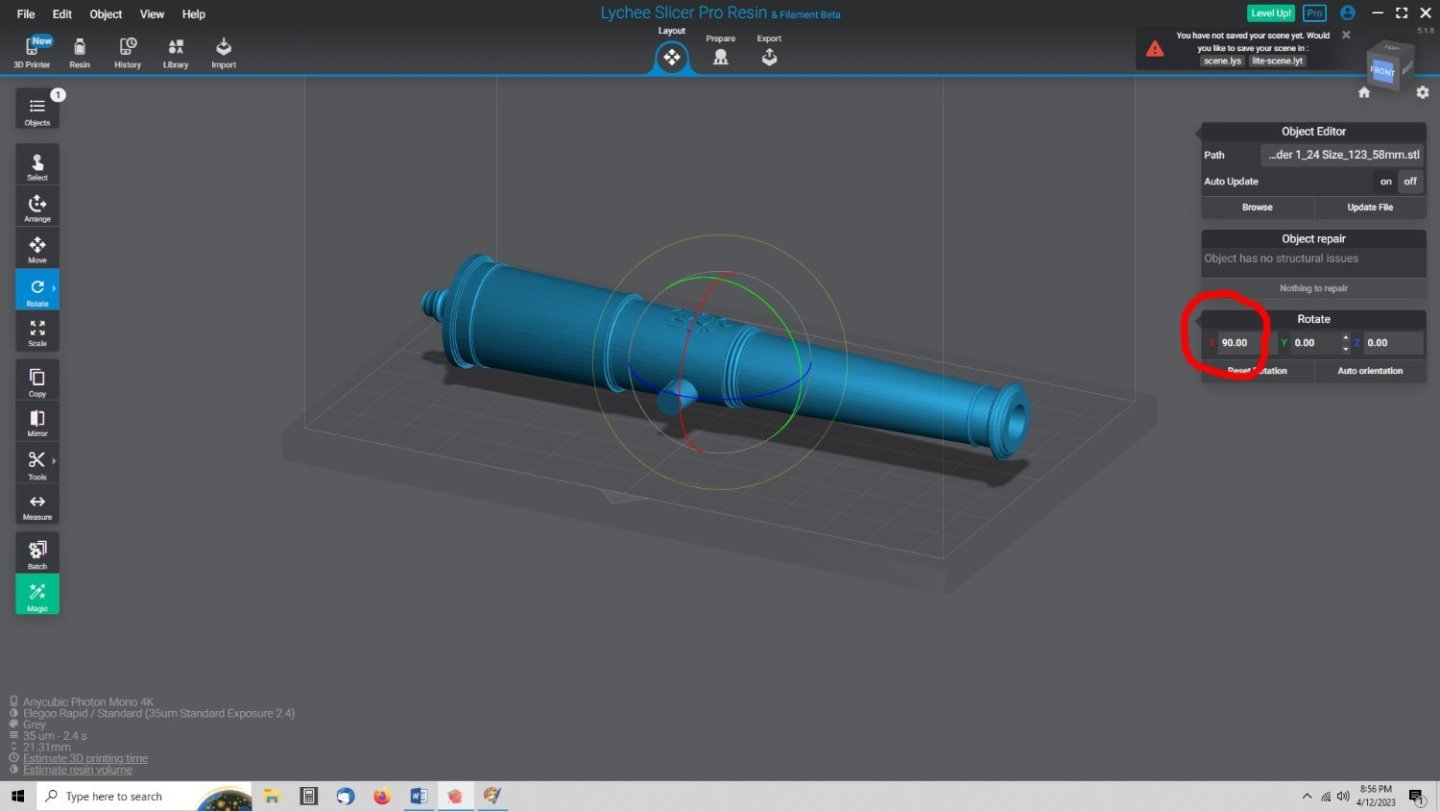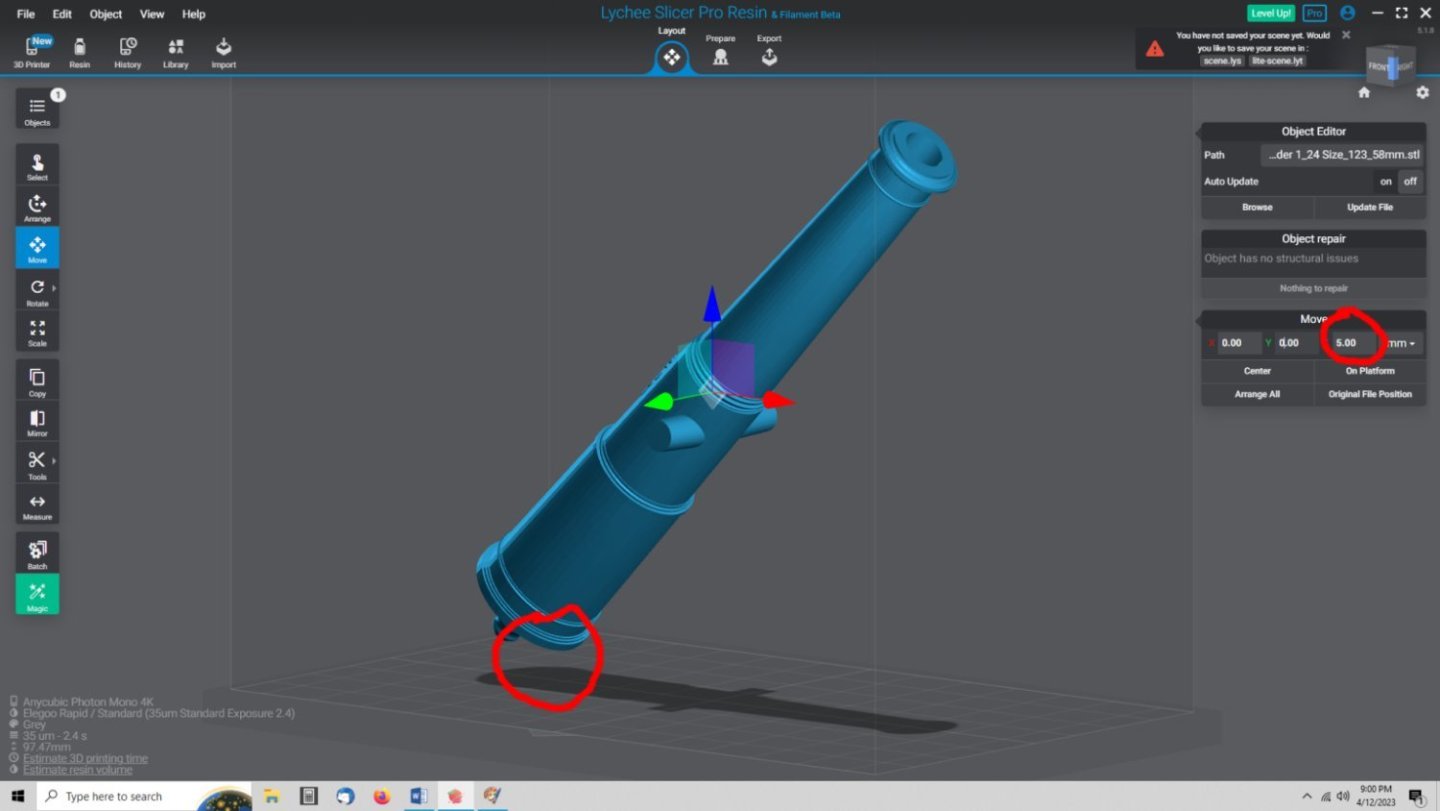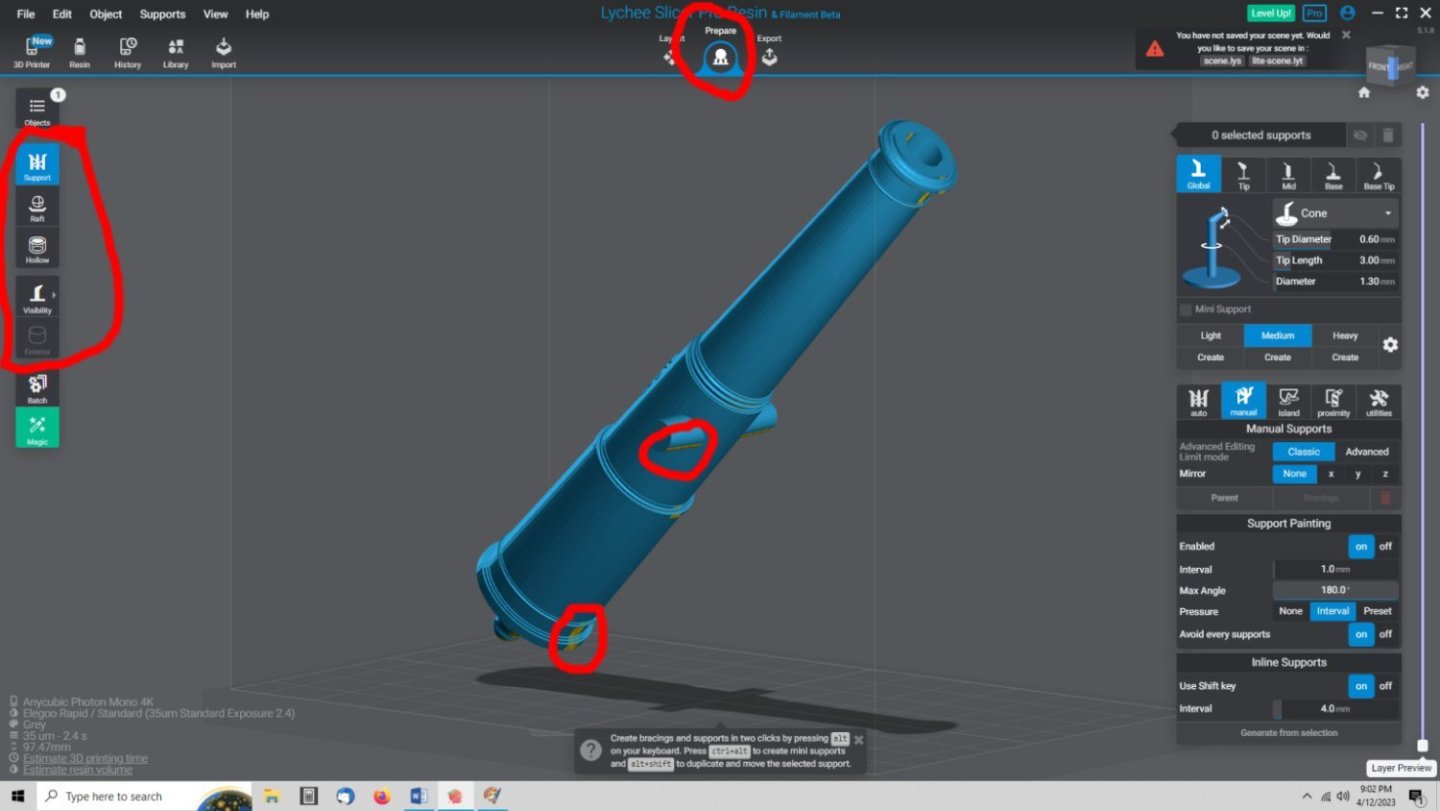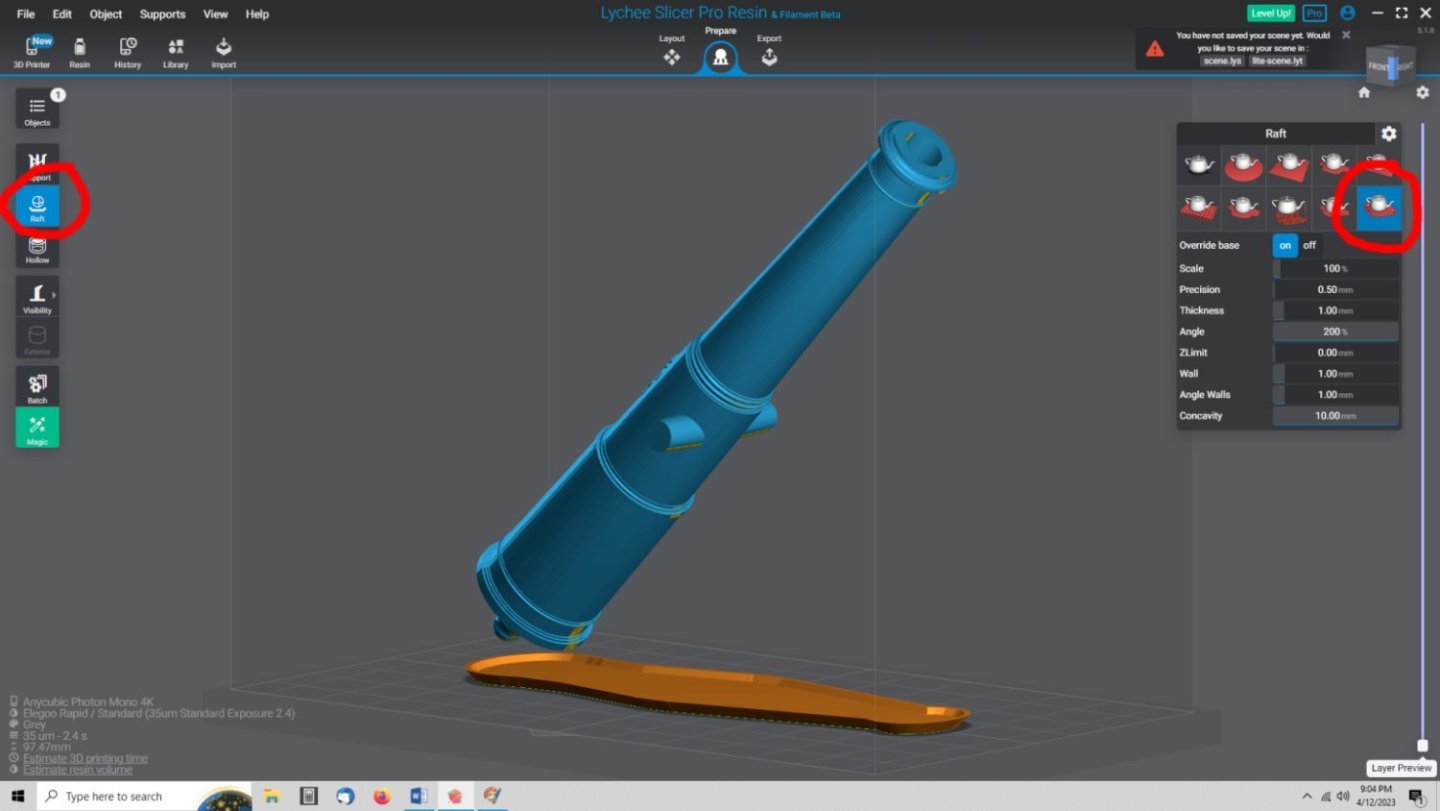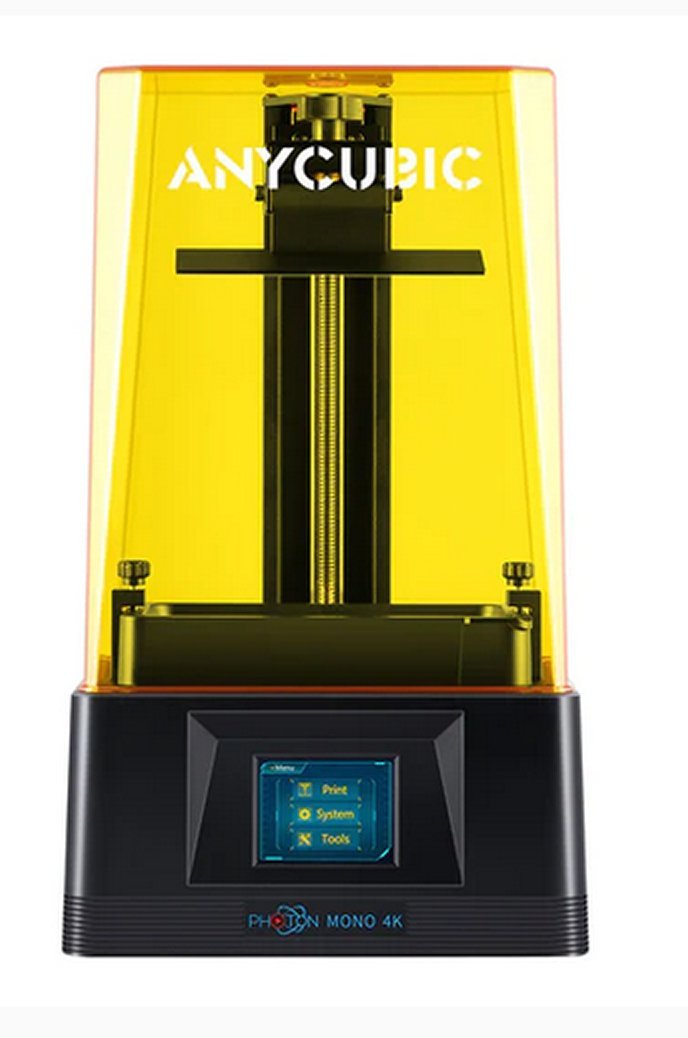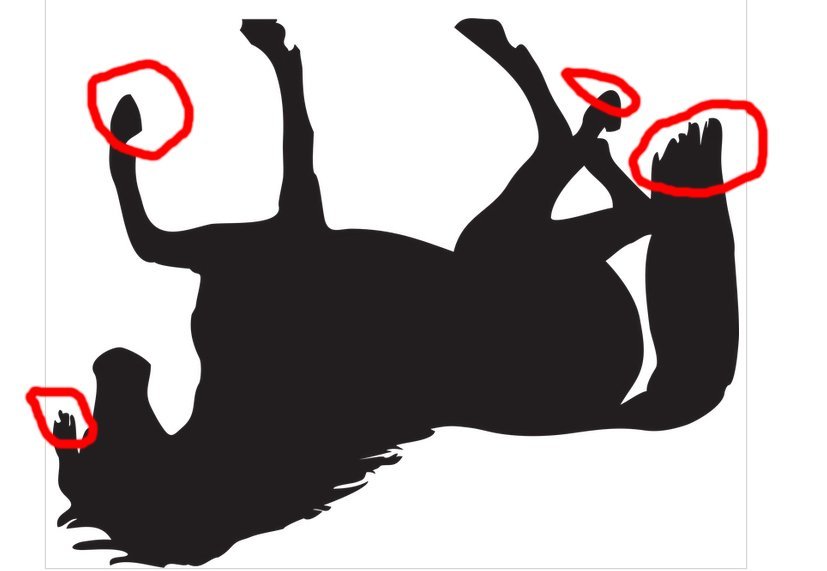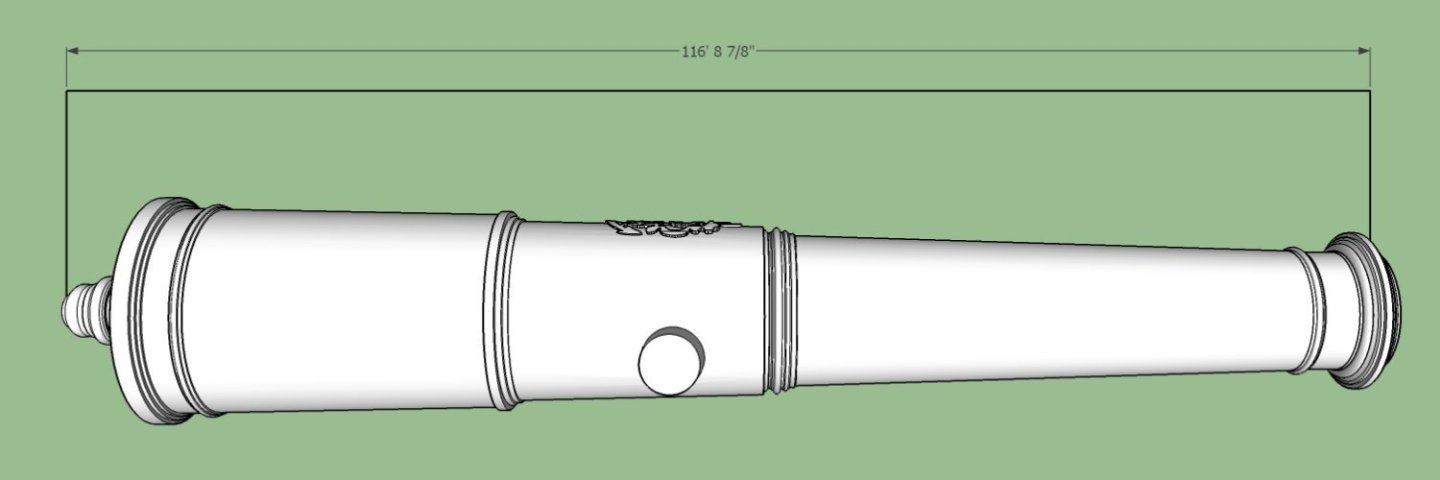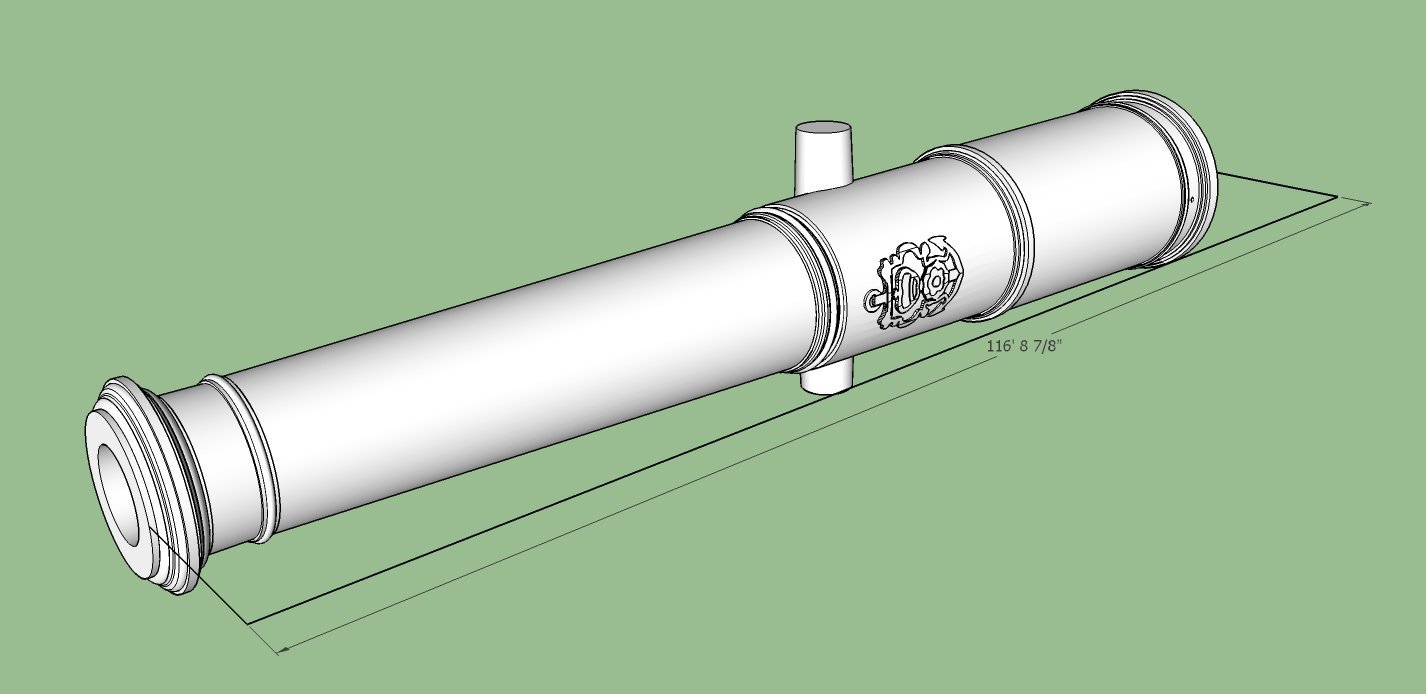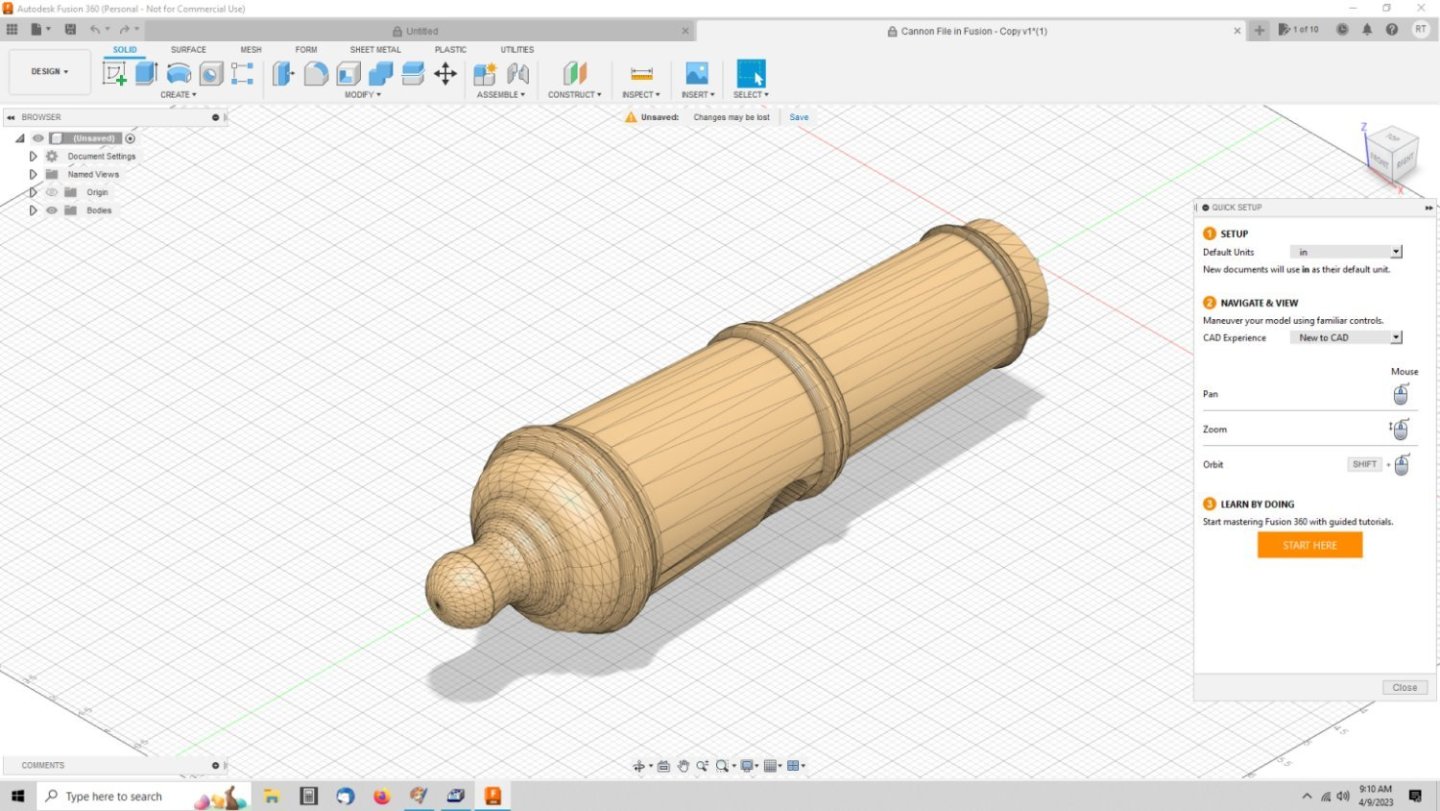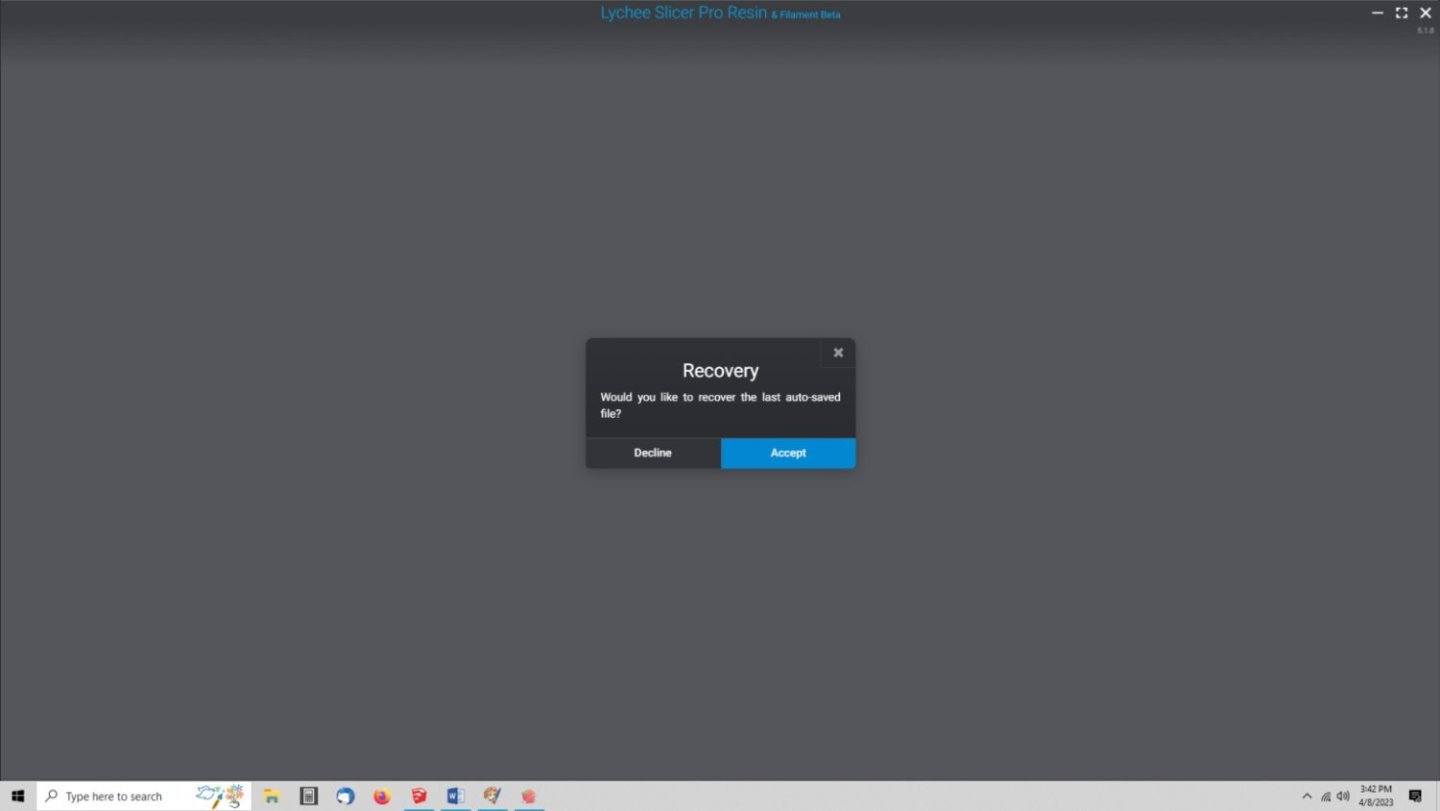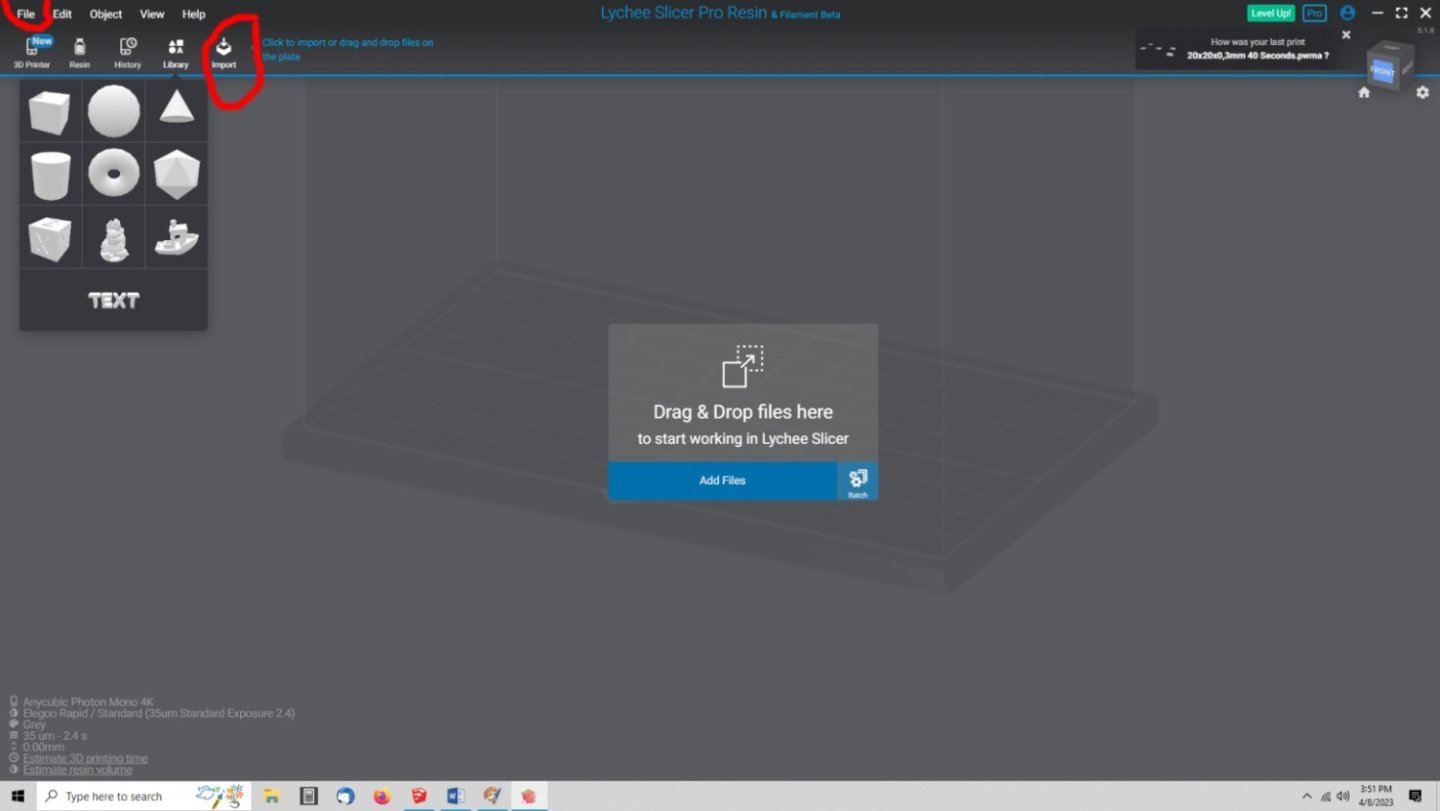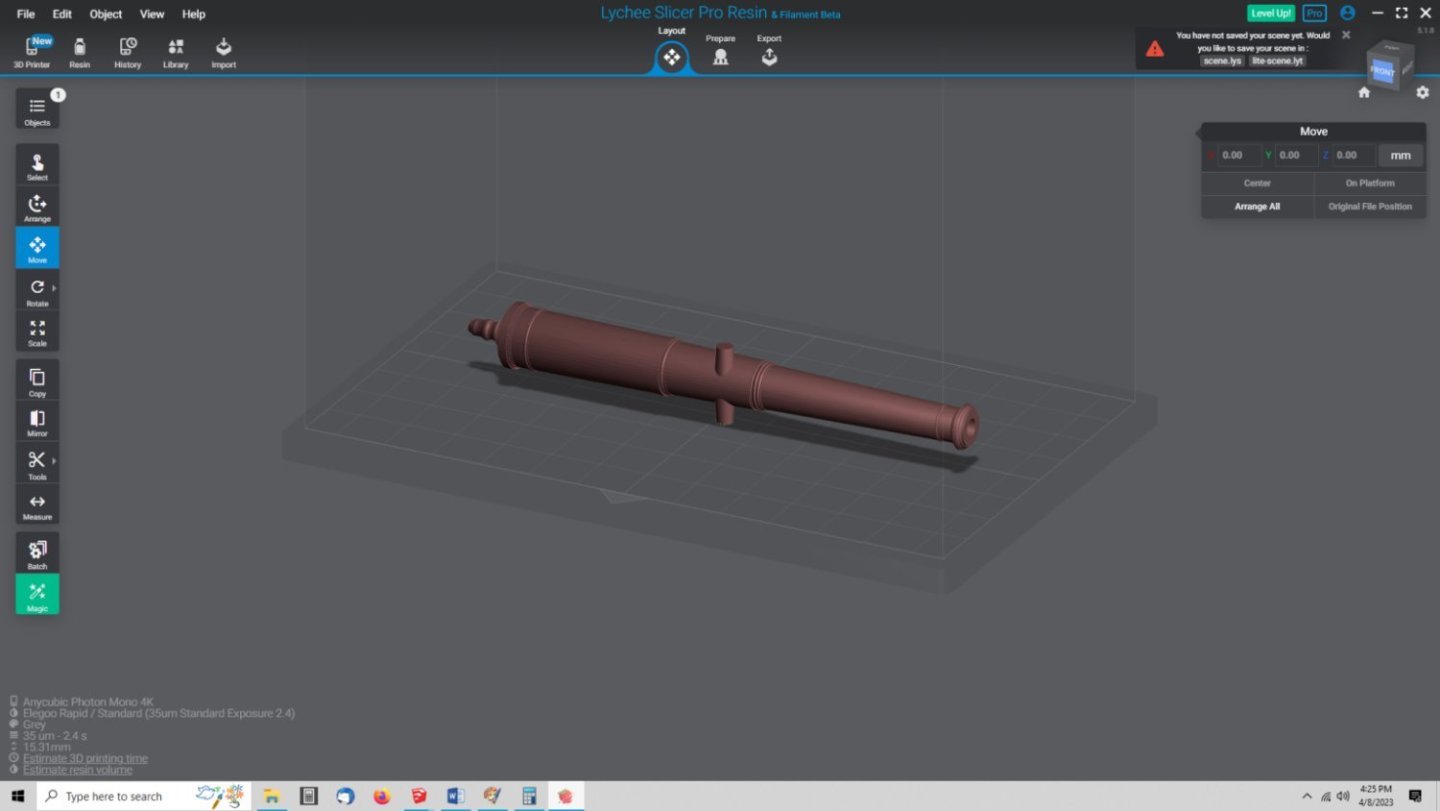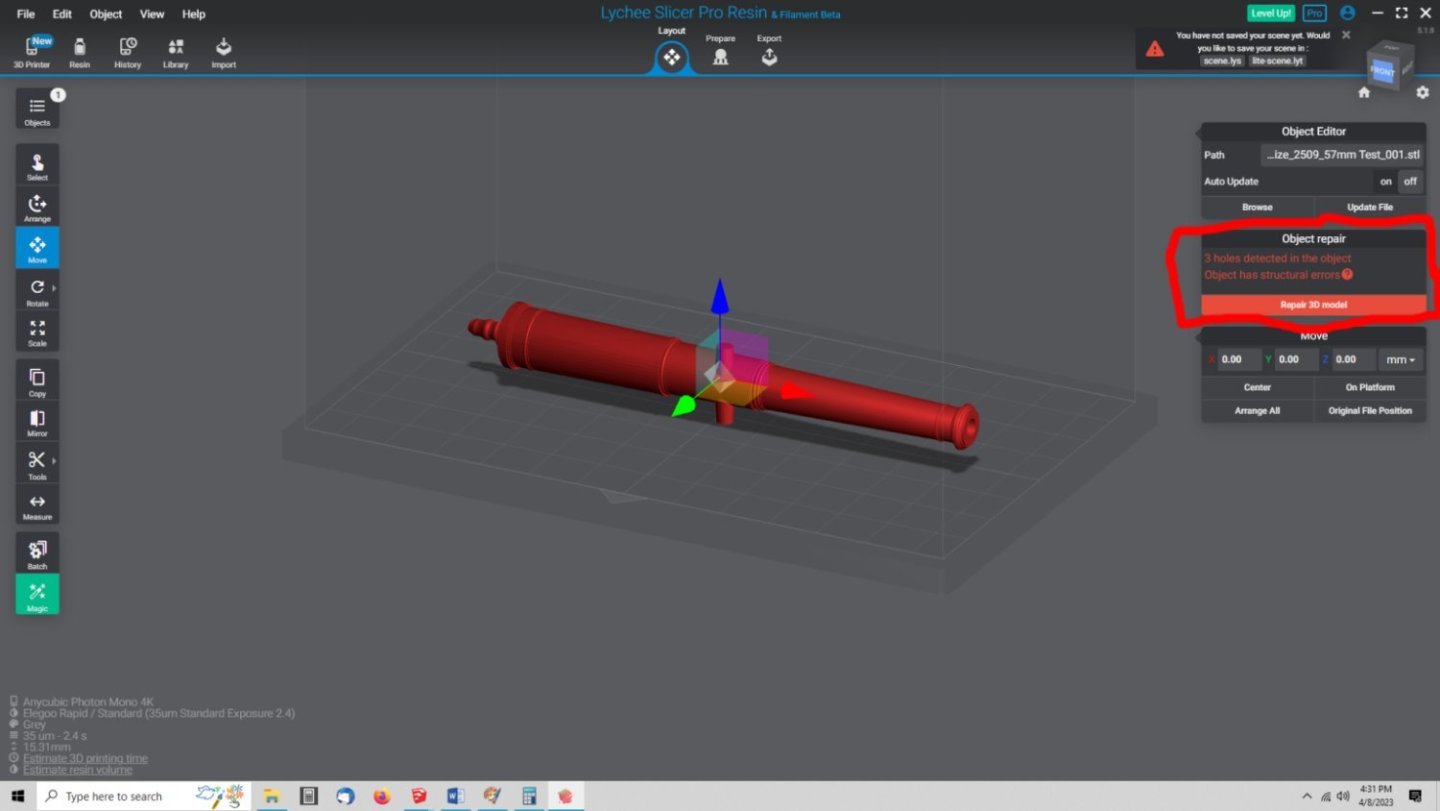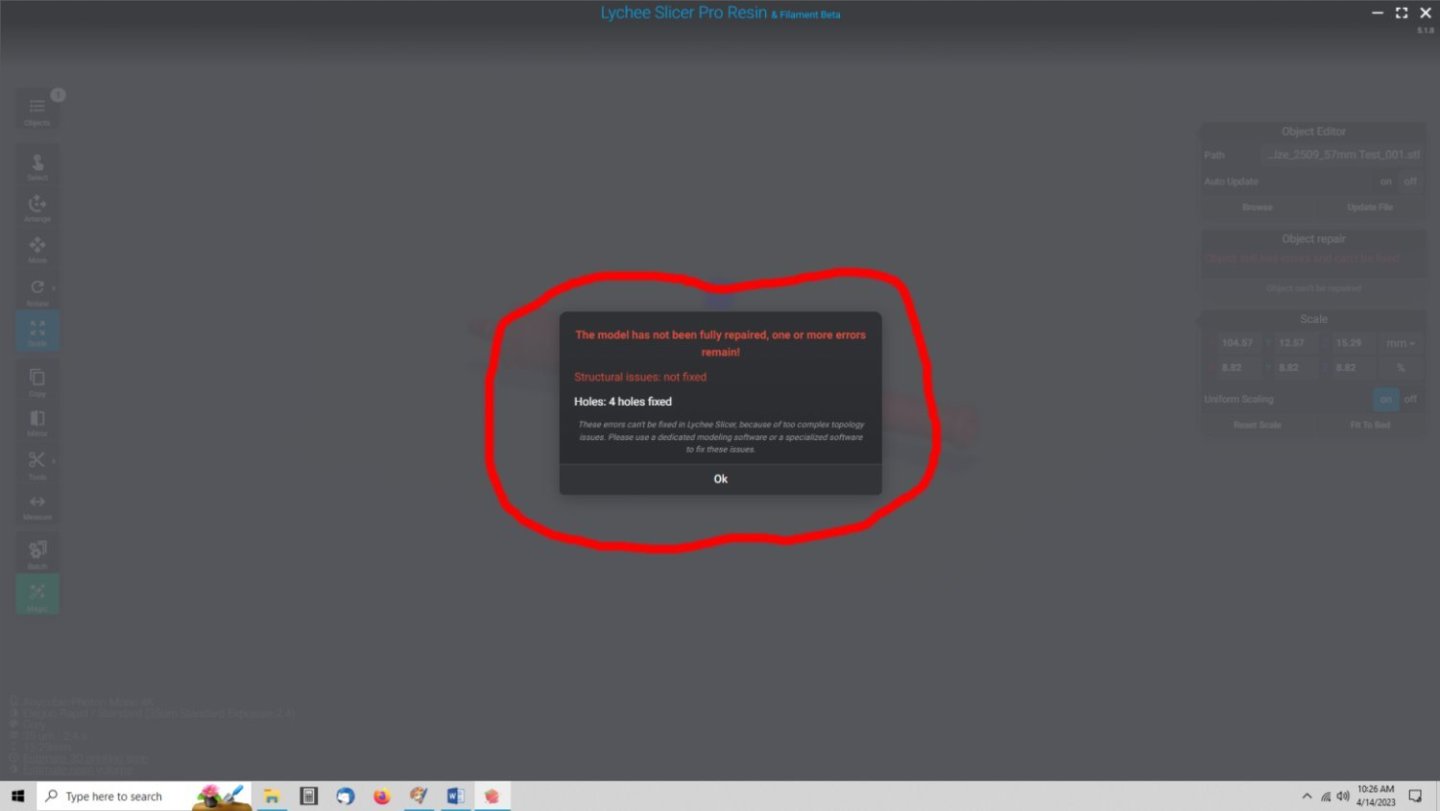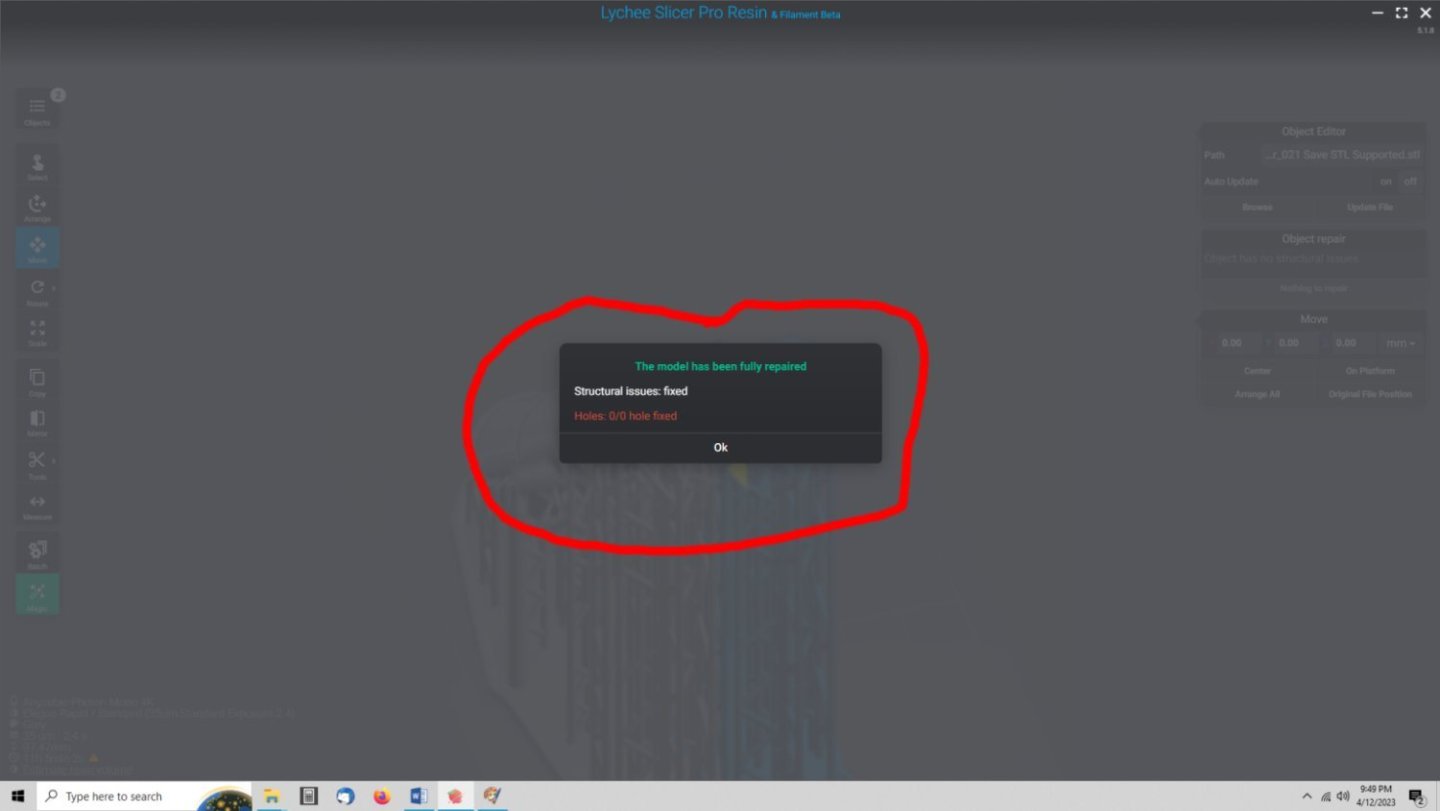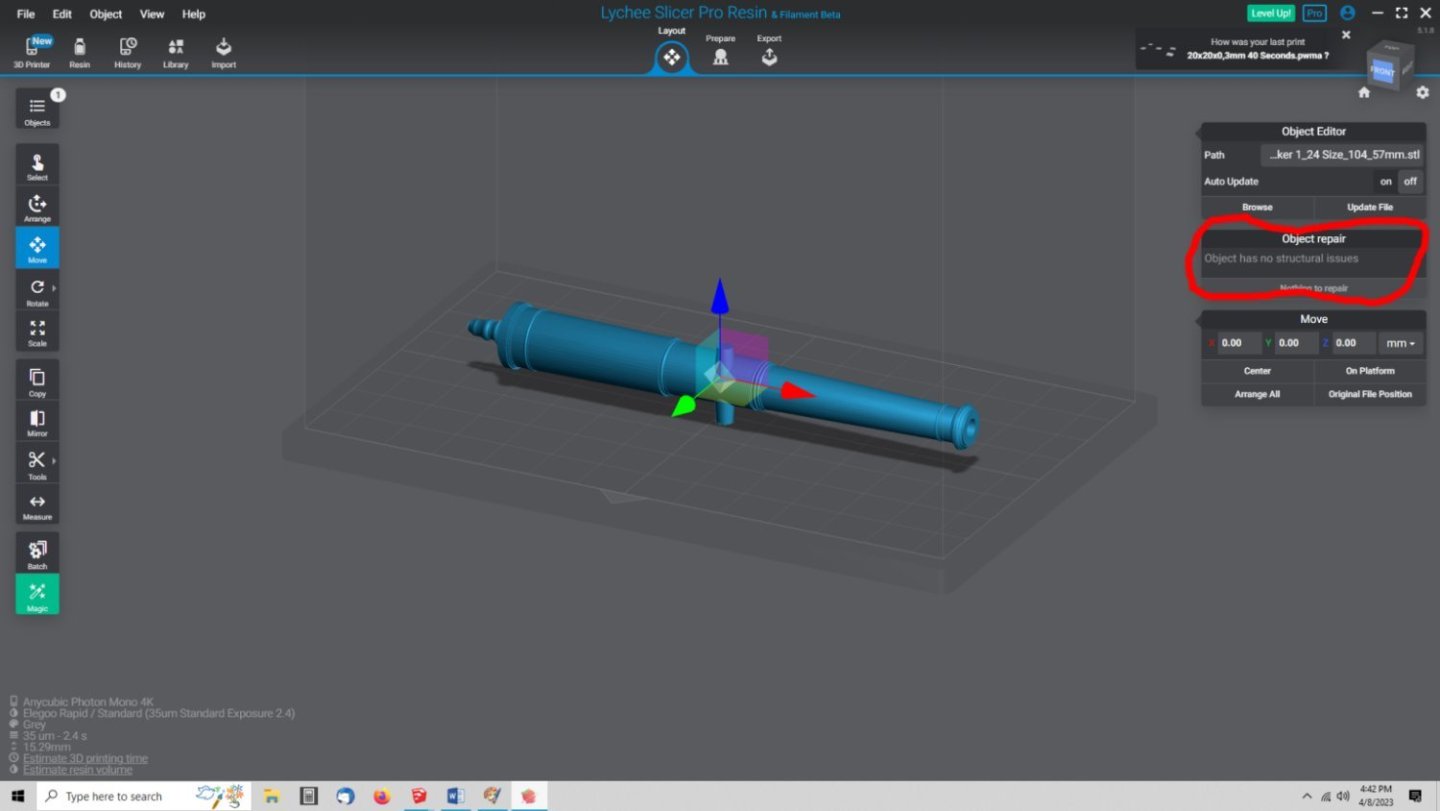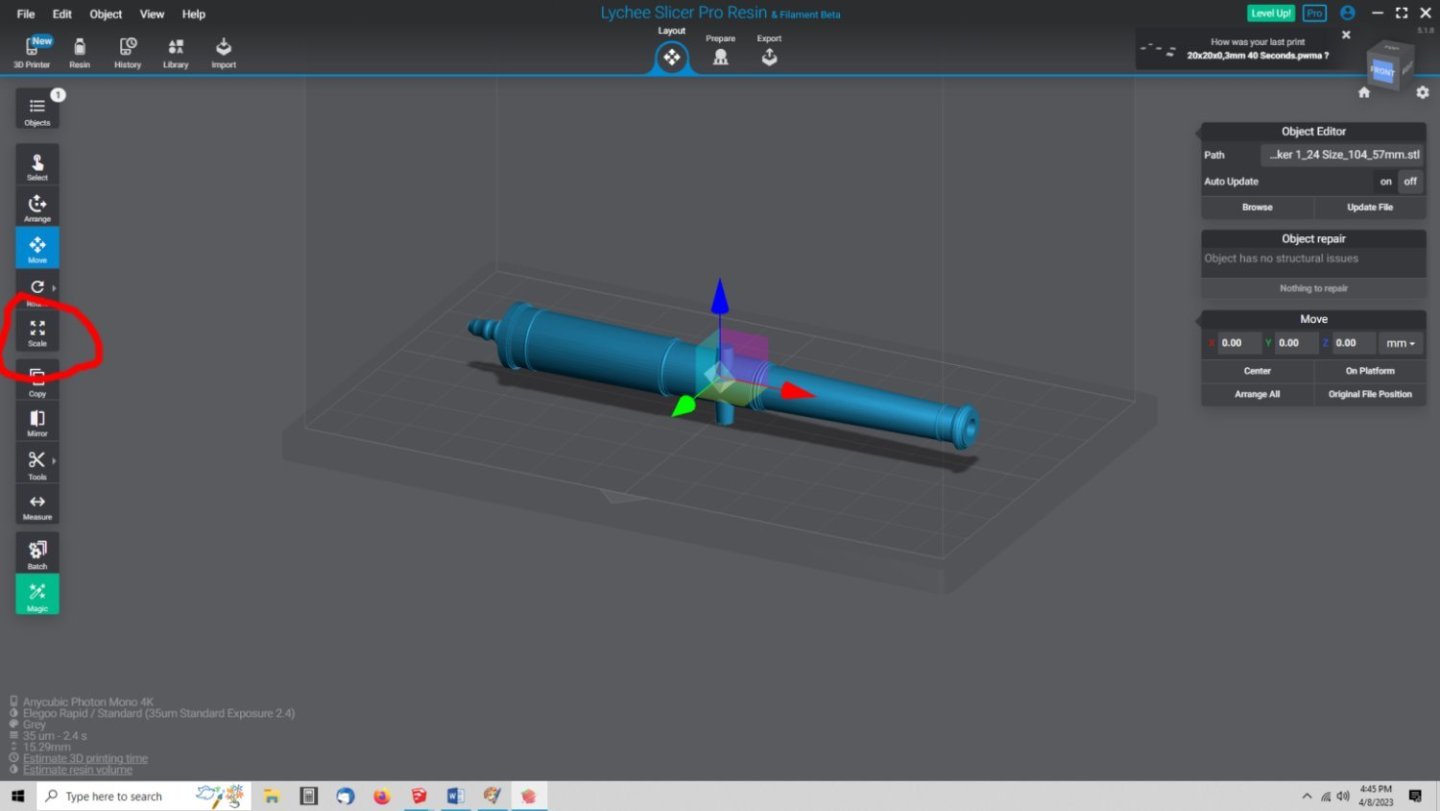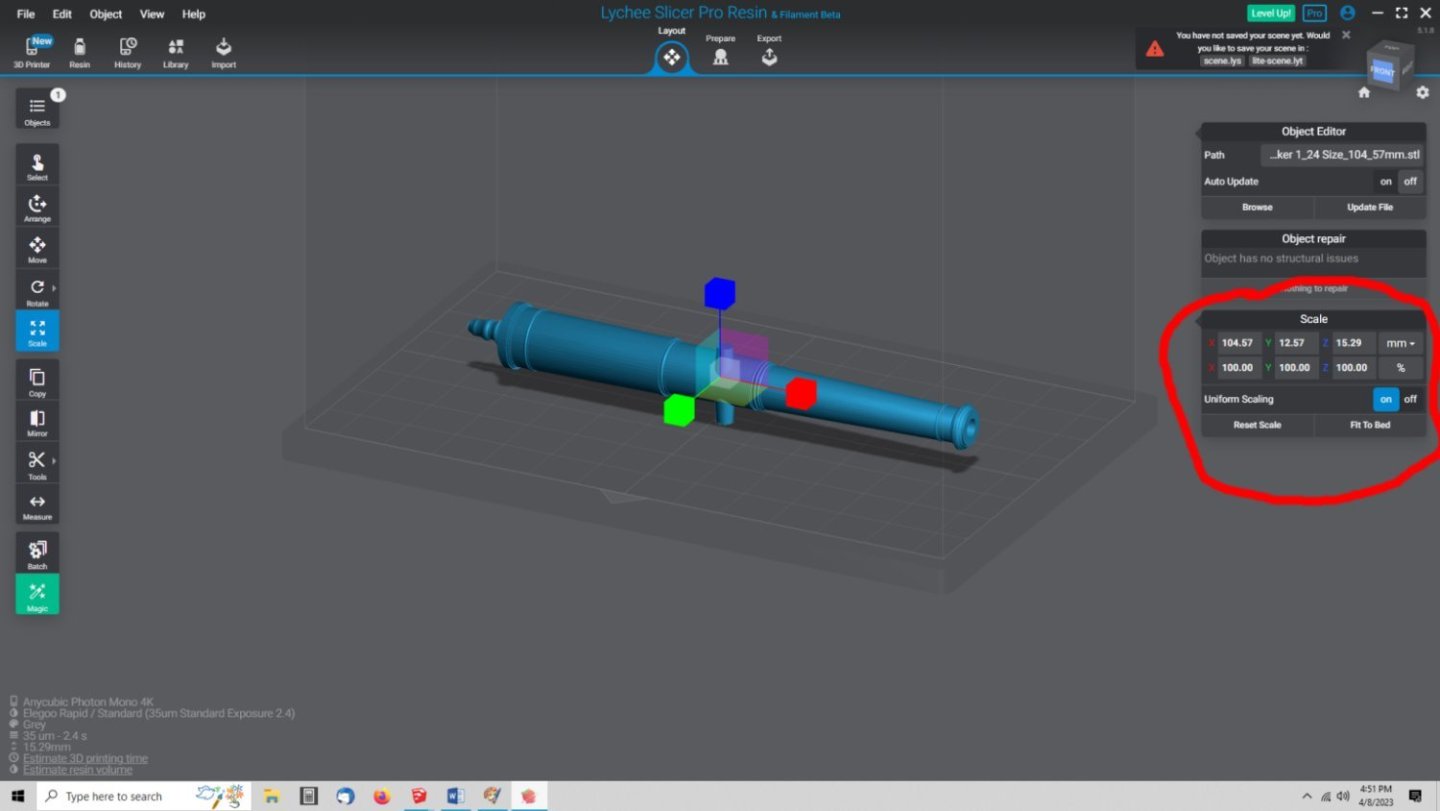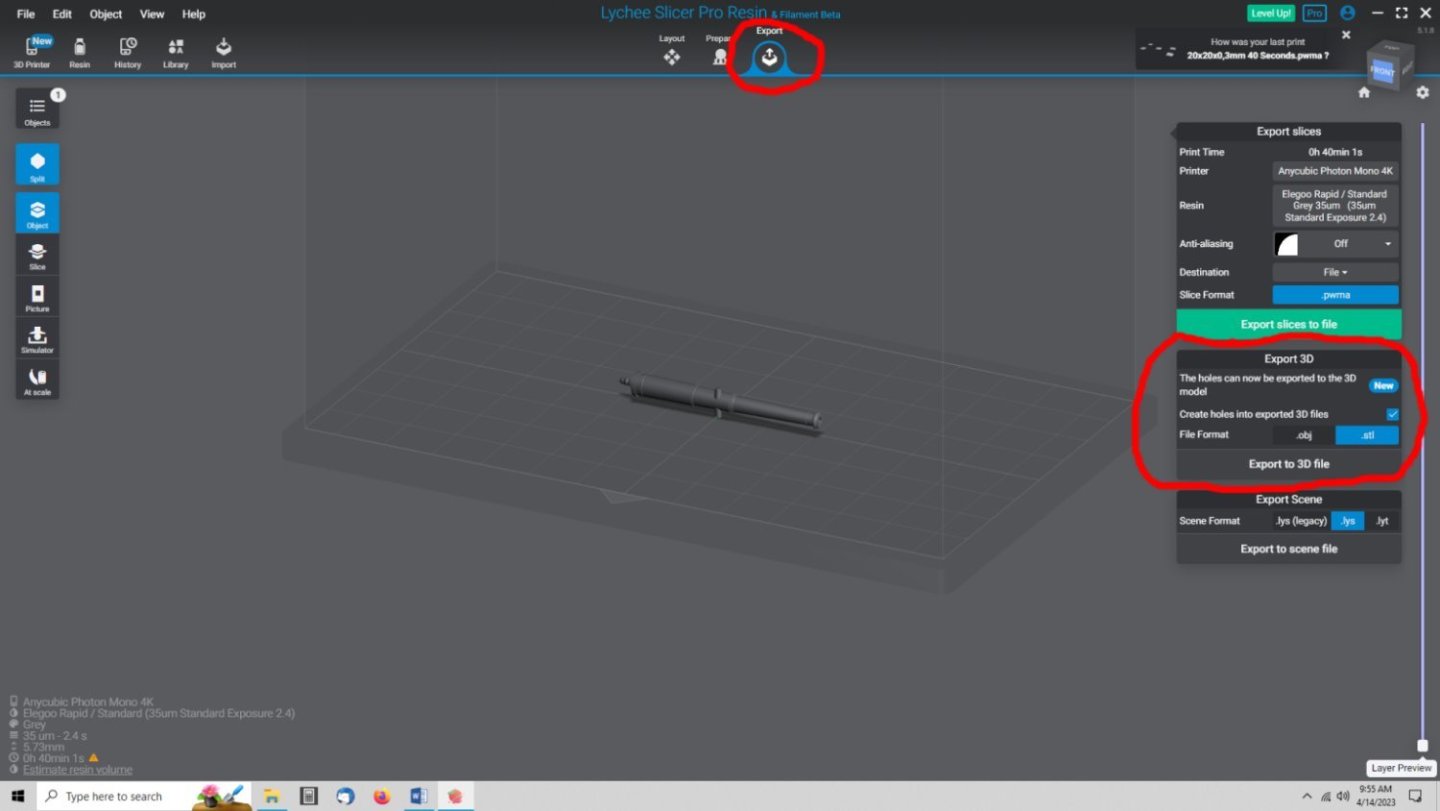-
Posts
2,941 -
Joined
-
Last visited
Content Type
Profiles
Forums
Gallery
Events
Everything posted by thibaultron
-

3D Printing Cannons in Resin
thibaultron replied to thibaultron's topic in 3D-Printing and Laser-Cutting.
Nice metalworking program you have there! Glad you like the thread! -

3D Printing Cannons in Resin
thibaultron replied to thibaultron's topic in 3D-Printing and Laser-Cutting.
Part 17 This section will cover what happens if Netfabb finds major errors with your STL file. If you have gotten a STL or OBJ file from a third party, these types of problems should not be a problem for you. If, like me, you are working on a file you created, the problems below, can occur. These are problems like holes or extra things, that make no sense in a real object. For this section I created a file that had two major problems. The first problem is that I deleted a small surface, so that the model had a hole in the outer skin. The second problem is a zero thickness tab hanging off the model. The tab is simply a sheet with no thickness. This can happen when you are editing a 3D object, and miss a small area that should have been deleted. In this example, it is easily spotted for correction, but sometimes they are so small, the you might miss them without a highly magnified surface scan of the original model file. After you open the STL and select the Red Cross symbol, your model will be displayed in blue with yellow error markings. You can zoom in to look at these areas using the mouse wheel, and rotate around the model by holding down the right mouse button. I ran the repair script, and after I replaced the old part, there was still a problem! Netfabb did not remove the tab! It seems the program sees this as a valid object. You will have to go back and delete it from the original drawing. This should only be a problem if you are creating your own models. If Netfabb has found problems like this with one of my drawings, I rerun the repair script again to make sure that there are no artifacts like this tab left, after the first attempt. Naturally, it still shows this obvious fault, but if this had been a small one, I might not have noticed the problem, without the second check. We will continue as if the tab is alright, for now. After the first repair run this screen was displayed. We will now save the file, and see if the second check will fix this. It says it fixed something. I opened this STL file in Lychee. No, the tab is still there! I would have to go back and fix this in the original drawing. I reran the original bad file to show you what the tab looks like after running a second Repair Script, and the program displayed the problem differently. Instead off highlighting it in yellow, it displayed it as red and green, with question marks in the script screen. Here are a couple of graphics of different ways this error was displayed when I was doing this write up. I hope this thread has helped you on your way to 3D printing! -

3D Printing Cannons in Resin
thibaultron replied to thibaultron's topic in 3D-Printing and Laser-Cutting.
Part 15 Now we will perform the Error Correction Routine. Select the “Red Cross” button. I do this with every new model, even if no warnings are displayed. The error screen will be displayed at the lower left. There are a few symbols that might be shown. A green checkmark means that particular parameter is good. A warning symbol means errors. There may also be a blue question mark, meaning it is not sure. The model will also be displayed in blue. If there are yellow markings displayed on the model, there are gross errors. I’ll cover them in Part 17 of the postings. Even if it shows all check marks, I run the repair script anyway, just to be sure. Select the “Run Repair Script” button. A new pop up will be displayed. I leave it on the “Default Repair” setting. Select the “Execute” button. If you look at the very bottom right of the window, you will see a little white rectangular box. This is the progress bar, and a green line will fill it from left to right as the repair script runs. When the bar fills the space, the script is finished, and the bar will disappear again. So watch it, to make sure the script ran. For this simple model, the script finished too quickly for me to get a screen shot of the bar. When it is finished, we now have to replace the old model with the repaired one. Select the “Apply Repair” button. This pop up will be shown. Select the “Remove old Part” button. The part correction will be applied, and the model will once again be displayed in orange. Now we need to save the corrected model. Right click on the blue bar under the “Parts” window. The name in it will change for each model you work on. Select “Export Part”, then “as STL” Now before you select the “Save” button!!! Look at the default name the program has selected for the file! Most of the time, it will duplicate the original file name twice, in the new file name! For example, "Cannon 25 – Cannon 25(repaired).stl", rather than "Cannon 25(repaired).stl". I have found Windows 10 unwilling to let you correct this file name if Netfabb saves it this way. I think it is because of the “-“ symbol, which is normally not one Windows likes in a file name. Go into the file name and delete the second extra text. If this will be a unique file, no rescaling, not going to be sent to someone, etc., I generally leave the “(repaired)" text in the file name, just because it differentiates it from my original STL file. I like to keep previous versions of my files as a design progresses. If I am going to be rescaling, it or otherwise renaming it, I delete the “(repaired)”. Select “Save” after you have made any changes to the default name. Before it saves the file, the program runs a final error check on it. This second check looks at different parameters than the first one, and may find some problems, it wants to know if you would like corrected. You can choose to ignore them, and continue. I always choose to let the program go ahead and fix these, after all, we are running Netfabb to fix any errors it finds. If errors are found this window will pop-up. Select “Optimize” to let it try to fix these errors. Otherwise, select “Export” to ignore them. If Netfabb can correct these problems, you will get this pop up. The check mark signifies all the errors were fixed. Select “Export” to save the file. Netfabb will, most times, fix all these errors, but sometimes there are a few left. No matter how many times you try to optimize these last errors away, Netfabb just can’t correct them. I just go ahead and export the file, with the uncorrected errors, and have had no problems. These are minor problems compared to those found in the repair script. I don’t have a screen shot of this, as it happens infrequently, and there were no instances while I was writing this, to get a screen shot from. You will be brought back to the main screen, and can now exit the program. It will ask you one more question, before it quits. It asks you if you want to save this project. The is no real reason we need to, so I just select “No”. Part 16 To rescale the cannon, simply repeat the above, but entering the correct scale length for your models. I always go through the entire error checking process, every time I rescale a model. When you rescale something, some scaling errors can creep in do to software decimal place limits, so checking and correcting these is a good idea. You should be able to print an unrepaired file with no problems, if you started with a clean master, but this only takes a few minutes, so why not be safe. -

3D Printing Cannons in Resin
thibaultron replied to thibaultron's topic in 3D-Printing and Laser-Cutting.
Part 14 Netfabb is a program from AutoCAD that allows you to perform many operations on both STL and OBJ files. I will cover error checking, repair, and scaling. The scaling will cover both correcting you file to the correct dimensions, and rescaling an existing STL or OBJ to a different scale. This will take 3 posts, as there are a lot of graphics, as I go through using Netfabb step by step. In actual life it only takes 10 minutes or so from start to saving the new version of your STL, unless you have a majorly complex model. Netfabb is available as a download at: https://www.autodesk.com/products/netfabb/free-trial I’m using Netfabb 2018. For my version, after the trail period, they would ask you for a license number. If you just exit out of that window, they will ask you if you want to continue with the unlicensed version, select “Yes”, and you can continue to use it. Every now and then, that same window will pop up, and I repeat the procedure. As long as you are not using the program for commercial use, it is legal to use it. The first part of this section is importing your STL to check that it comes up the right length. In this case I am importing a STL for a full size 1:1 cannon I drew. Following that I will run through an error checking and correcting sequence. When Netfabb is opening you get this splash screen, at least in my version. The program then opens this window. This is the default size of the window, you can expand it to full screen size, like any Windows program. Select the file folder symbol under the “File” menu icon to open your STL or OBJ file. For files like this I like to include as much information in the file name as possible. This is so a few years down the line, I will remember what the h..l I was doing! In this case I put the full description of what cannon it is, the scale (Full Size = 1:1), and the total length to aid in rescaling in the future. In this case, the “for Article” is because I modified the file specifically for the examples in this write up. Wouldn’t want to get this modified file mixed up with the original. The program opens and displays the file. The program found possible errors in the file, as denoted by the warning symbol, in the lower right hand side. We will check these further down. Right now, I first check that the model is the correct length, not a given with the SketchUp version I use. Select the “Modify” button. Select the “Scale” button. The “Scale Parts” window will open, displaying the dimensions of the model. In this case we can see that it is incorrect. The length should be 3118.27mm for 1:1 scale, not 1473.18mm. I selected the “X” box, deleted the existing number (this is required, or the program will mess up), entered the new value 3118.27, and clicked on another box. The dimensions corrected on all the axis. Then I selected “Scale”. The changes are made and the now larger cannon model is displayed. I then repeated the scaling process, to insure that the dimension numbers were correct. Netfabb sometimes slightly changes the entered values, so I always recheck that the scaling came out correctly. If the numbers are different I correct the “X” axis number and resave. Generally it comes out correct the second time. Sometimes no matter how much you try to correct the value, it still comes out with a slightly different value in the second decimal place. I just except it and continue. If you wish, you can change the window to display the whole model once again. Select the “View” menu button, then “Zoom to”, and then “All Parts”. The model will now once again be fully displayed in the window. -

Failed print but also not fine enough detail
thibaultron replied to Srenner's topic in 3D-Printing and Laser-Cutting.
I use Netfabb to check my STL files. It works with OBJ files also. -

Failed print but also not fine enough detail
thibaultron replied to Srenner's topic in 3D-Printing and Laser-Cutting.
For a 40um layer 90% exposure. As far as alias questions, I don't know. My machine will not do that, so I've never investigated it. -

Failed print but also not fine enough detail
thibaultron replied to Srenner's topic in 3D-Printing and Laser-Cutting.
Looked on their web site, and it says the XY resolution is 40um, which would be pixel size. -

Failed print but also not fine enough detail
thibaultron replied to Srenner's topic in 3D-Printing and Laser-Cutting.
You can set the layer height at 23um, you don't need to do it in 5 or 10um steps. -

Failed print but also not fine enough detail
thibaultron replied to Srenner's topic in 3D-Printing and Laser-Cutting.
What size pixels does your printer have? The value should be on the manf. web site? Angle the print back so that the transom is at 45 degrees, and the supports are contacting the back/inside of the model. Print the model at a layer height equal to the pixel size. For example, my Anycubic Mono 4K has a pixel size of 35um, so I would use a layer height of 35um, when I set a model at 45 degrees. Add a thin sheet to the 3D behind the window openings that cover the whole area and overlap the edges. This will support the thin frames during printing. Make sure the supports do not land near the frames, but do land in the sheet area. Carefully remove the supports before curing. Damage to the thin sheet area is OK, as long as the mullions remain intact. After you cure the print, carefully sand the thin sheet away, leaving the mullions. When you change the layer height you have to change the exposure time, as explained in the 3D Printing thread, about 1/4 of the way down, in one of my posts. Did you test your printer to get the proper exposure for your resin? Earlier in that thread we discussed how to do that. I use Lychee Slicer, it is better than Chicupbox(sp). I started a thread on 3D Printing Cannons. I go step by step through using Lychee, with info on setting up a model to be printed. What resin are you using? -
According the Wikipedia she carried Upper deck: 26 × 18-pounder guns Quarter Deck: 12 × 32-pounder carronades Forecastle: 2 × 9-pounder guns + 2 × 32-pounder carronades So you need a mix of cannons There is an Anatomy Of the Ship book on her. If you want to go for a scratch build, you might want to get it. https://www.amazon.com/32-Gun-Frigate-Essex-Anatomy-Ship/dp/0961502169
-

3D Printing Cannons in Resin
thibaultron replied to thibaultron's topic in 3D-Printing and Laser-Cutting.
Part 9 Now, the messy part, Cleaning!!!!!! I cannot give an exhaustive write-up on all the materials, methods, and safety concerns having to do with handling, cleaning, and curing, resin parts. Go Web surfing, there is a lot of information out there, to help you. I spent hours watching videos, and reading Web pages, before I even purchased my equipment. A few notes on some important points when cleaning up your machine: Get yourself a decent quality metal scraper/putty knife, with a tapered edge for removing the model from the build plate! The plastic one many companies supply with the machines, is too brittle for the job! Place a metal or silicone tray under the machines and work area, to catch any spilled or dripped uncured resin. I bought an Oil Drip Tray from the auto parts store, Cut it shorter, and bent the back up to protect the wall. I talked about it in the 3D Printing thread, I mentioned earlier. Buy a package of micro-fiber cloths. I get a bag of them from the auto parts section. I cut each cloth into 4 pieces. When you are cleaning out the vat, only clean the clear film with these clothes, never use paper towels! The paper towels will scratch the film, and lead to early failure of the non-stick surface! You can use paper towels, carefully, on the vat frame. Never use a scraper or sharp object on the film. They can easily make holes in it! Even a hole too small to see, can leak resin onto your printer, ruin the screen, or even get into the housing, and damage the electronics! If your printer did not come with screen protectors, install one! If you have a failed print, with some cured resin left stuck to the film, sit back, and think before trying to get the spots off. You have a few options. 1. Carefully and gently press on the film from the bottom with your finger (not the nail!), and try to pop one corner off the film. If it does pop loose work your way along the length of the blob, until it is free. 2. If the blob is still too soft and just flexes with the pressure, return the vat to the printer, and run the screen check test for a couple minutes, to further harden the blob, and try again. 3. If both the above fail, return the vat to the printer, and pour a thin layer of resin over the bob. Then run the screen test for three or four minutes. This will bond the blob to a larger area. If you have an old raft with supports laying around set the raft down in the resin, in one corner, before running the screen test. This gives you a handle to pull on the larger sheet. Drain the vat, and either pull on the raft/handle. Or try popping one corner from underneath the film. You can generally pull off the whole thing, embedded blob and all in one piece Some more tips: Do not save the dirty micro-fiber cloths, just throw them away with the rest of the cleaning mess. Put a cheap white plastic trash bag in a trash can, or plastic bucket, and throw each towel or other cleaning debris into it. The can holds the bag open, which is easier than trying to stuff messy things in just the floppy bag alone. Why a cheap white plastic bag? After you are finished, tie the bag closed and let it sit out in the sun for a few days. The UV from the sun will cure any un-cured resin, in the waste, making it safe to dispose of. If you used a black or opaque white bag, the UV will not reach the inside. I use an old plastic ground coffee container to wash the build plate, scrapper, vat, and any other item I used during cleaning, that I plan to keep. This contains the mess. When I’m done cleaning, I dump the left over IPA in it, onto the used paper towels in the trashcan, before I close it up. This IPA is generally much dirtier than the IPA in the wash tub, so I don’t want to add it to that. Do not leave the IPA in the washer tub! The stirring paddle in the bottom has an internal bearing, that might get IPA in it over time. Get one or two large clear sealable containers, and pour the IPA from the tub into one. Let it sit out in the sun for a week or two, after the cleaning session. The suspended resin will harden and sink to the bottom. You can then filter this through a cloth to recover the cleaned IPA. Use a large mouthed container for straining this. The resin will quickly clog a small opening. I use a cloth stretched over a bucket. If you have cats and use Tidy Cats Litter, and it comes in the plastic 35 pound container, cut a large hole in the lid, and close the cloth under the lid. Pour the clean IPA into a sealable container, for your next cleaning session. I tried using plastic milk jugs for the storage of the IPA during the sunning, and storage phases, but they have proven to susceptible to puncturing. Part 10 One thing you need is some way to clean and cure the prints! You can DIY all sorts of things to do this, but you will likely end up spending as much as just buying a Wash and Cure machine from one of the manufactures. Save yourself the hassle of building your own. For my Mono 4K I use Anycubic’s Wash & Cure 2.0. it is not expensive, and is sized right for my printer. There are other manufactures out there, so look around. Remember, you need to wash the print and also do a final cure. The print is only semi-cured, and can be easily scratched or damaged until the final cure. The print is also still slightly toxic, until fully cured. When picking a wash and cure machine, balance the machine size to your printer. A machine that is too small may not hold a model that your printer can make. IPA is expensive, and to a degree reusable, but a large wash machine will take a lot of the IPA, which you have to buy, handle, and store after you are done. Once the IPA no longer is doing a good job, even after you have been recycling it, disposing of the IPA has to be considered also. Some type of closable container that will still allow the IPA to evaporate, while keeping it sealed from kids, animals, and ignition sources will be needed. A jar or latchable tub with holes in the lid, or screening, placed away from kids and animals, as well as placed in an open area, to prevent fume build up should be used. Part 11 When your print is finished, you have two choices. One, remove the supports before cleaning. Two, clean the parts while they are still on the rafts and supports. You can use a lower level of IPA in the cleaning tub, if you remove the parts first, but if there are small or delicate parts, they can get broken, in the turbulence of the washing, and/or fall through the mesh of the basket, and get battered by, or jam the stirring blades. In some wash and cure machines, you can even leave all the parts on the build plate, and wash them that way. It uses more IPA, but really protects small and delicate parts. These last two methods also have the advantage of washing the resin off the supports and raft, making them safer to handle. I printed a 1/24th scale model of the large cannon, I used in this write up. I removed it with the supports and raft still attached, and washed it that way. For the group of cannons I showed in the photograph, I washed them while still attached to the build plate. After you wash the parts, remove them from the supports before you cure them! The supports will break off with less damage. You can submerge the parts in warm water before removing the supports, to further reduce damage. If you cure the parts before removing the supports, they will likely make larger divots in the model, or break small parts. Send the raft(s) and supports pieces through a cure cycle after you have finished with the model. This makes them safer for disposal. Also keep a few of the rafts, that still have supports on them, to use as handles for removing the cured sheet of resin during the blob removal I talked about above. Once you have removed the parts from the washer, allow them to completely dry!! If there is any IPA still on the parts, it will leave chalky area on the cured pieces. Also make sure all the uncured resin is washed off. Uncured resin will spread and leave a shiny puddle type blemish on the, generally, matt finish of the model. Part 12 Special considerations when cleaning the cannon, or any part with deep or small holes. Here are a couple of screen shots of the cross section of the 32 Pounder model. The first is an overall view. Yes I cheated, and left the bottom of the bore flat rather than hemispherical, sue me! Here is a close-up of the breach end. Notice the small hole for the touch hole. Yes, I drew that in too! Both the deep bore and the small touch hole will be hard to clean, even with a dedicated wash machine. The bore was not too much of a problem on this large 6 inch model, but still worth a little extra effort. Before I washed the model, I ran a dowel down the bore to break away the internal supports and push any resin at least onto the wall, and not just leave a blob inside the bore. On smaller cannon I would do this a couple times, maybe with a few drops of IPA to help clean out the resin. On a large model like the 32 Pounder, some resin left way inside the bore, will not seep out far enough to mar the external surfaces. With small cannon, it may. Here is a picture of cannons that I purposely did not clean the barrels of. You can see the cured resin almost fills the bore, in these smaller sizes. The touchhole is a special problem, as will be any small deep holes. The resin will fill these and stay in there by capillary action, even during washing. Before cleaning I ran a fine drill through the hole a couple times, cleaning off the bit in between, to force the resin out. Even for small shallow holes, I generally used a Q-tip (Not a Sponsor) with some IPA on it to clean them out before washing. On a general note about cotton swabs, buy ones with a wooden stick, they hold up better when being used around liquid cleaners. Cleaning deep holes or surfaces that are otherwise difficult to reach, I use gun cleaning swabs. These have long sticks with cotton bulbs on each end, One end is the classic rounded tip, the other is a pointed tip. You can get them on Amazon. Here is a link to them, as well as one for a box 0f 2000. I also put a link to the disposable gloves I use. https://www.amazon.com/Tapered-Regular-Type-III-Cleaning-American/dp/B008CPU4JW/ref=sr_1_8?crid=2LNVKNYBP1LZJ&keywords=gun%2Bcleaning%2Bswabs&qid=1681661926&sprefix=gun%2Bcleaning%2Bswabs%2Caps%2C95&sr=8-8&th=1 https://www.amazon.com/Applicator-Accessory-Cleaning-Electronics-Decoration/dp/B083125LX4 https://www.amazon.com/dp/B09HMHJBF5?psc=1&ref=ppx_yo2ov_dt_b_product_details Part 13 Now onto curing your model. You do not need to “Nuke” the parts, generally two or three minutes will do for small parts. As in many cooking instructions, turn them over ½ way through. An uncured resin can be easily dented/marked with a finger nail. On a fully cured part, the finger nail may scratch it, but slightly. If you have long flat parts, like in the graphic below, cure each side for a short period, turn it over, rinse and repeat, until it is cured. This will help to avoid warping. The minimum cure time is important in this case. Over long curing of parts like this will cause warpage, every time. There is another consideration with the cannons and hollow models, in general. The UV light has to get inside the model to cure those surfaces, also! With those deep bores, anything over about 1/72nd scale will need to be cured on the inside too. Hollow parts are also created when you print lager items, like say a sphere, or the latest reptile like Japanese monster, for example. If you just print them as is, it will not only take a lot of expensive resin, but the resin inside will never be fully cured! When 3D resin printers first came out, this was not widely known. Many a thick solid model cracked and started leaking uncured resin after a year or so! If you are printing with one of the clear resins, this is not as much of a problem. Remember the hole(s) in the model should allow the whole interior to drain, and clean the out the inside well. I personally have not done one of these models, so cannot give any more advice on the subject, sorry. That Japanese reptile does sound interesting, though! Now how do you illuminate the inside of your model? You make yourself a UV “Flash Light”. Below are links to a set of 12 volt UV LEDs and a set of connectors. I used these, along with a 12V wall adapter I had laying around to build a simple one. It is just the adaptor, the connector, and one of the LEDs. You can skip the connectors, and just hard wire the LED to the adaptor cord, but this is handy, and I had some left from another project. It also allows me to use more LEDs if the interior space is large. For the small cannons, I stuck the LED into as much of the muzzle as I could, and let it shine for about three minutes. If the LED fit all the way inside, I pushed it all the way in about 1/4" inch, did the exposure, then slid it further along and did it a second time. For the 1/24th scale 32 Pounder, I did it three times, rather than two. Do not look into the light! UV is not good for your eyes! Either cover the LED and parts with something opaque, or set the colored printer or washer machine cover over it. Those covers protect you from the UV produced by both machines, when they are operating. Links to LEDs and connectors: https://www.amazon.com/gp/product/B07C61434H/ref=ppx_yo_dt_b_asin_title_o04_s00?ie=UTF8&psc=1 https://www.amazon.com/gp/product/B07TGSRXZ5/ref=ppx_yo_dt_b_asin_title_o09_s00?ie=UTF8&psc=1 Something I forgot to mention earlier. When you drain the vat back into the resin jar, you need to filter it to catch any loose material that may have been created during the print, especially if it is a failed print. Below is a link to the type you need. https://www.amazon.com/gp/product/B000PA09V0/ref=ppx_yo_dt_b_asin_title_o07_s00?ie=UTF8&psc=1 My son 3D filament printed me a nice funnel for this job. It fits over the outside of the resin bottle mouth, with a spout that goes inside the bottle. You can find files for these on the Web. Just don’t do what I did the first time, and swing around and knock everything over! What a mess, and I lost about 2/3s of my only bottle of resin! Here are pictures of the funnel. First the funnel and bottle. Two views of the funnel. A picture of the funnel with the filter in place. These next two pictures show how well a 3D resin printer can reproduce details. These cannons are prints of the 6 Pounder cannon in 1/32nd, 1/48th, 1/60th, and 1/64th! Even on the smallest one the cypher emblem and fluting are visible! I also printed the 1/72nd, 1/96th, and 1/100th scale versions. Unfortunately, my camera will not take pictures of these smaller cannons in any sort of detail. In the two smaller scales the cypher is faint, but still visible, and the fluting is still well defined. I am designing and printing a HO scale passenger car, and the scale 1 inch hemispherical rivets are clearly defined. On the model they are just a hair over 0.011 inch in diameter. The graphic of the long flat model used as an example above is one side of that car. -

3D Printing Cannons in Resin
thibaultron replied to thibaultron's topic in 3D-Printing and Laser-Cutting.
Part 8 Here is another shot of the printed cannons I showed at the start of this thread. The cannons are spread evenly over the surface of the build plate. In this case, though, it would have been better to rotate one of the rows, so that the smaller cannon were at opposite corners, to even out the pull forces.. I mentioned earlier that for the set of cannons shown above, that I printed them basically opposite of what I showed for the larger cannon, we just finished talking about. In the next set of graphics I’m going to show you how and why I did that. These next two graphics show the general layout of a cannon and supports. The next graphic shows the area of the thin screw handles that I wanted to protect. If I had turned the cannon to face away from the build plate, these would have been hard to access, before I removed the other supports. This would likely have led to them being pulled on or twisted, while I was getting to them. As even with carefully removing the supports for the handles first, some of them broke. The handles are really small as these are printed in 1/64th scale! The handles on the prototype were only 1 ½ inches in diameter, so these printed ones are only 0.023 inches in diameter. They are quite fragile. This is a graphic from the underside of the print. It shows where I attached the supports to the handles. Also circled are the supports for the trunnion and trunnion cap. This was a major problem as the tabs on the caps were either missing or distorted, on the first few prints. I ended up having to use four supports, as shown, to get them to print correctly. I hope this has helped you. I will be adding more to the thread, with write ups on cleaning and curing your resin prints, as well as a write up on using Netfabb to fix and rescale STLs and OBJs. -

3D Printing Cannons in Resin
thibaultron replied to thibaultron's topic in 3D-Printing and Laser-Cutting.
Part 7 Having finished correcting the supports, I moved onto saving the work. Select the “Export” button at the top of the screen. New windows will pop-up on the right. The first thing to do is save the supported model! This allows you to make new print files without having to start from scratch, as well as place multiple models on the build plate, for printing multiple cannons at the same time. A 3D resin printer takes X amount of time to print a model Ymm high, it does not take any more time to print several models placed on the build plate, than it takes to print one of whichever the tallest one is. So restarting Lychee and placing several of the supported STLs on the plate, will give you many models in the same time. I’ll show this later. For a big model like this it might be better to print just one to start, to verify that the supports are correct. Then print multiple ones, after it checks out, just to save on resin. If you have several different size or type cannons to test, print a group of one of each, to save time. Select the “Export to 3D File button, and save the file as you normally would. If you have the free version, the program will display a short advertisement then illuminate a button to continue. I have the paid version, and I forget just what the button says. Now we need to discuss Layer Height. By default most 3D resin printer set the layer height to 50um, to decrease printing time. We want the best detail though. As I wrote earlier we set the angle to 45 degrees. For my printer, the layer height should be set to 35um. When you first setup your printer, it will ask you to also setup the resin type files. I will not go into that here, as you should already have done this to test your printer, and dial in the correct exposure settings for that resin at the default 50um. All this is explained in the 3D printing thread I mention earlier. As you decrease layer height, you also need to decrease the UV light exposure time, as the thinner layer hardens quicker than thicker ones. Look through that thread. Use the spreadsheet, in that thread to find the correct exposure time for your new layer height, and save it under a new name like the one shown in the “Export Slices” window above and below, that I made for the 35um layer height. The blue ".pwma button may have a different label, as the print file type may be different for your printer. Select the “Export the slices to file” button, enter the file name, and select the “Save” button. Lychee will create a slice for each layer section of the model (in this case one for every 35um layer), then create a print file containing all the slices that will work for your printer. The program will display each slice as it works its way through the model. You can watch this and see if everything looks OK. This takes several minutes so sit back and relax! This model will take 2785 slices as shown at the top of the window. The present slice being shown is also displayed. This graphic shows one of the slices for this model. I tried to take several screen shots from this first run of the process, but Lychee and a scheduled virus scan were using 100% of my CPU, so I was unable to go back and forth between Lychee and my photo program, to save multiple ones. The picture shows a level a little above the top floor of the raft. The outline is that layer of the angled raft wall, and a cross section of the supports. The next few graphics are from the second and third Lychee runs that I used to replace some of the messed up screen shots from the first version. Luckily the run did not take as much CPU percentage as the first, and I was able to get a few screen shots from it. Note the lack of the Heavy supports shown in these pictures. These were actually from my third attempt at getting screen shots. This slice is from the breach end of the cannon. This one is just above the breach. This picture is a layer at the level of the trunnions. This picture is a layer of the barrel near the muzzle. This one shows a layer through the fancy fluting at the muzzle. Note the dot inside the bore. This is a section of one of the internal supports. When the slicing is finished, this window will be displayed. Take the estimated time to print, with a grain of salt. I’ll explain below. I just exit out of this window, opening the file folder, is something I do through Windows Explorer before I exit Lychee, just to make sure everything is where I expect it to be. Lychee will now display the following window showing data about the print at the bottom left of the window. The text is shown blown up below. The important things to see here are to check that: 1. The correct printer is shown, this is doubly important if you have more than one printer! 2. The correct resin and layer height were used. 3. The time estimate is probably wrong, I’ll talk more about this later. Generally, at present, my printer takes about twice as long as the number shown. 4. If you select the “Estimate resin volume”, the program will calculate this for you. I don’t know why this is a separate calculation, rather than just doing it automatically, but it does take a little bit of time, and the program was originally written for commercial users. Maybe they don’t want to take the extra time in the commercial world to wait for this when a large complex model is being run. If you do select the volume calculation, you will get a break down of total volume of resin needed, as well as a breakdown of the model and support volumes. It also gives you a cost based on the price of resin you entered while doing the resin type setup. Here is a picture showing a close up of the internal supports. If you are going to be printing more than one model in a single print it is best to arrange them so that the pulling forces are balanced as the build plate retracts. This helps to insure a good print. As an example here is a good layout for printing two of these cannons in one setting. This setup is one of the things I was talking about when I said to save the STL (or OBJ) of the supported model. I imported the second model from a previous session. As a note: Even though I imported the second model from a saved Lychee session, it was flagged as having problems. I simply ran the Lychee correction script, and it fixed the model. This has been a frequent problem I have encountered with Lychee, but there was only one time it was unable to fix the imported supported file. Later in this thread, I will be discussing AutoCAD’s Netfabb program, in regards to both fixing STL and OBJ problems and for scaling either. Now, about the incorrect printing time. Lychee is supposed to take your printer data from a database they have, which includes print speeds. For my printer, which was just released when I setup Lychee, they got it wrong! Additionally they have a “History” database in the program itself. However, after you create a print file, the next time you open Lychee, they will ask you about the print that you made from that previous file, including the actual print time. If you didn’t record that time, or have not yet run the file, it retains the calculated time in that database, as valid. I have constantly forgotten the record the time, in my hurry to clean, cure, and gaze lovingly, if it worked, at my creation. I often also create several print files, between print sessions, so that history database has a mishmash of corrected and calculate times in it. Hence the print time problem. If that database was correct, Lychee would be able to give a better estimate. Knowing I have to double the time, is good enough for me. 3D printing takes time, and I am doing hobby stuff, not paid commissions. This printer allows me to make models I would have a lot of trouble doing myself, especially if large quantities are needed! -

3D Printing Cannons in Resin
thibaultron replied to thibaultron's topic in 3D-Printing and Laser-Cutting.
Part 6 Now we need to go back to the Supports function, so I selected the “Prepare” button. New windows are displayed on the right hand side of the display. Make sure that the “Auto” button is selected. I go with the default support types, at the top of the upper window. As you can see, there are three options for support size: “Light”, Medium”, and “Heavy”. The larger the support size, the larger the surface area of the interface between the support tip and the model, thus, the larger the potential mark/divot removing the support can make. So you have to go for the smallest support to model size possible. Below are three pictures of the supported model, using each of the three support sizes. All three options generated about the same number of supports, about 100 to 105. Light supports. Medium supports. Heavy Supports. For smaller cannon, I would go with Light supports for the auto generated ones, but for this large model, I would pick the Medium supports. The Heavy supports are overkill and may make for really visible defects that need to be fixed. In addition, if you look closely at the heavy support graphic, you can see that there are visible internal supports in the bore of the cannon. While not visible in the other two graphics, they too have these internal supports. The internal heavy supports may be difficult to break out, while the light and medium supports can be removed by running a dowel or other small object down the bore. With a model this large, I would not trust the light supports to function well. Now we have to look to see if additional supports are needed. In short, yes. I have found that the trunnions need more support than the Auto Generate function provides. Looking at the model, you can see large island areas at the bottom of the trunnions, with no or just a single support for these areas. In my experience, the trunnions are either missing this island area, leaving a flat spot, and many times also distorted. I remove any present supports in these areas, and add my own just past the barrel-trunnion junction and on at the outside end of the trunnion. For these added supports, I go with the next larger size, so, since I chose the medium supports, I would add heavy supports in these spots. The bottom of the trunnion will be hidden between the carriage and the cannon, so any divots will be almost invisible and easy to fix, If these were exposed surfaces, I might opt to stay with the medium supports. Later I will show you how I handled the thin screw handles on the other type of cannons I mentioned in the first section. The next graphic shows the other side of the supported model. In this picture, you can see one of the internal supports inside the bore. Ignore the one white colored support, my mouse pointer just happened to be on it, when I took the screen shot. We need to fix the trunnion supports now. First we need to remove any existing supports in the area, as they might interfere with placing the new ones. Select the “Manual” button, this allows you to place and remove supports by hand. Next place the mouse pointer on the support to be removed. It will highlight in white. Then right click and the “Tags” window will pop-up. Select the “Remove Selected Support(s)” button, or hit the Delete Key, and the support will be removed. This graphic shows the trunnion with all supports removed. Left click the mouse off of the model, to close the “Tags” window. Now we have to add in the new supports. Re-select the model. As you move the pointer around the model you will see a phantom support following the pointer. You will also see a white horizontal line following it. This line shows you what level the tip of the support is at. You can use this line to find the exact bottom of the island, or a similar area on the level. The graphic shows the tip of the phantom support right at the bottom of the trunnion. Left click, and the support will be placed. Note that in the previous graphic, I had forgotten to select the heavy support option, so I had to delete that support, select the “Heavy” button, and redo it. The graphic below shows the placed support. I added another support just outboard of the trunnion barrel junction. I then repeated the operations on the other trunnion. I did not remove the medium supports on this side, as I’m using this model simply to generate the screen shots. If I was doing this on an actual model I would have, as well as adding the support near the barrel-trunnion junction. I also added some medium supports at a couple of spots on the bottom of the barrel, where islands were still shown in yellow. See the circled area below. Unfortunately, those screen shots got messed up, and when I redid the model to try to get the pictures, Lychee had placed supports there this time. This also shows that if you don’t like the first set of supports delete them and try again. If you have not gotten too far you can “Crtl Z” back to the pre-support model. Continued in Part 7. -

3D Printing Cannons in Resin
thibaultron replied to thibaultron's topic in 3D-Printing and Laser-Cutting.
Part 4 For the rest of this thread, I will assume you are planning to print your model yourself, or need to generate a print file to give to someone else to print. If you are just starting out 3D Resin printing, there is a lot for you to learn, and I can not cover it all here. This will be a quick review of the setup of the supports for a cannon, and creating the printer file. I suggest asking questions on this forum, and a deep dive into YouTube videos on the subject of your 3D printer. Let’s discuss 3D resin printing a little more before we continue with the next steps in getting your file ready for printing. Earlier I discussed why the resin printer is better for small models and fine detail than the filament type printer. Now let’s talk about the differences in how they print a little more. A filament printer prints by adding melted plastic in layers to build the model up from the base plate to the top of the model.. Assuming no supports are needed, this means that only the actual parts of the model need to be worried about. Empty spaces are just that empty. A 3D resin printer is quite different. It has a build plate that lowers into a vat of resin. A, generally, UV screen below the vat, projects light in the shape of that layer of the model, through a clear sheet that is the bottom of the vat, and the resin the UV light hits hardens. The build plate then raises up to pull that layer free of the bottom of the vat. The clear sheet has a non-stick surface. The build plate then goes back down, slightly less, as it already has a layer on it. The next layer hardens, and the process continues until the print has completed. Here is a picture from the manufactures site of the printer I use, an Anycubic Mono 4K printer. The vat is the black tank at the bottom of the yellow plastic encased area. The build plate is attached on the vertical arm near the top. The UV light source (a LCD type screen) is just below the vat. Here is a picture of a finished print I did. The build plate is upside down on the bench, and the print is attached to what is normally the bottom working surface. The cannons are shiny because they are still coated with wet resin. After cleaning and curing, they will typically have a matt finish. As the build plate goes up and down, the last layer hardened generally stays in the pool of resin. When the print is done the print and build plate are fully retracted, and excess resin is allowed to drip off the parts. You will notice that for the print above, the muzzle openings face toward the build plate. I did this because the breach end of the cannon includes the elevating mechanism, which has four thin rods that make up the handles that turn the screw that elevates the gun. These are very thin in the model, and I wanted them free and clear to carefully break away the thin supports I used for them. If the cannon had been turned with the muzzles pointing away from the build plate, I was afraid that in removing the other supports, I would break the thin handles. This worked fine, but presents a problem. Remember the print would be on the underside of the build plate, when printing. This means that as the barrels print the resin can drip out of them, until the bottom of the bore is reached! This will trap some of the resin in the barrel, while the back end of the gun is printing, and stays there while the resin is dripping off at the end of the print. The resin is quite thick, somewhere between maple syrup and heavy cream. So once the plate is turned over, like in the photo above, some of the resin will still stubbornly cling to the inside of the barrel for quite a while. I ended up running the end of a small dowel inside the barrel to help clean out most of the remaining resin. The better way to print a cannon like this is with the muzzle pointing away from the build plate, toward the vat. This allows much better drainage while the cannon is printing. Once again there were compelling reasons that I printed these cannons wrong-way-around. Next you have to consider the general orientation of the model. While it may seem intuitive that you should print any model flat to the build plate, especially something with a flat bottom, this is not the case. This would conceivably reduce the number of needed supports, and save resin. But this is not the case. The first few layers have to be slightly over exposed to firmly attach them to the build plate, so the model stays there during the rest of the print. This causes these first layers to be a little wider than the desired outlines, as some light leaks into the edges with the longer exposure. The base of the model thus elephant foots, as the terminology goes. So a cube, let’s say, would have a slightly larger rim on the bottom. Next, remember that the model has to pull off the non-stick sheet, after each layer is exposed. This is not a zero force procedure! The larger the exposed area of resin in a layer, the more force is required! If a large enough force is needed, it may pull the whole thing off the build plate instead, ruining the whole print, or it may just pull the model away from that new layer, causing faults in the final print. Sometimes following layers may attach to this layer and pull it free, but the model will have a discontinuity in that area. To get the best detail with the fewest layer lines, generally tilting the model at 45 degrees, and printing at a layer height setting equal to the size of the pixels on the UV screen, is best. For my printer, the pixel size is 35um (.035mm, or 0.00138 inches), so the layer height for these prints was set to the same 35um. Generally, you can find the pixel size in the printer details on the manufacturer's web site, or in the printer manual. Why do we need supports? First if your model prints at an angle, if you just have a single support at the base, the bending stress as the model moves along and you are printing areas future away will put a bending stress on the support, and either cause it to fail, or distort the model (i.e. The barrel would come out bent). Next we will visit the idea of “Islands”. Islands are parts of your print that have no attachment to the model or build plate when they are first printed. As they have no attachment to either, they simply stay attached to the film when the rest of the model pulls away, and just keep get wider and wider, as the print progresses, until some part of the main body of the model contacts them. This leads to a failure of the model, as it has features missing. Let’s take the example of the horse shown below as a simple example. It is shown upside down as it would be as it is printing, with the upper areas printing first. The circled areas are some of the spots that would be islands if no supports were used. These areas have no attachment to anything other than the vat film when the layer that they start on is exposed. You also need to support thin areas where the force of pulling the layer off the film might cause it to bend into a curve. Rather than staying straight. This is especially true if it is the first few layers of a large thin or flat section. Even the cannon we are trying to print can cause this bending problem if the barrel is parallel to the sheet. The first few layers of the barrel will be long and thin, if parallel to the screen. So, long story short, it is best to angle almost all your prints. Another consideration is the orientation of the model. You always want to position the side or edge that will be the least viewed toward the build plate. This is the area most of the supports will contact the model, so any divots that come from removing the supports will be on the least visible areas. For a cannon this would place the bottom of the barrel closest to the plate, for a figurine that is angled, position it so the back of the figurine has the supports, or whatever side will not be seen as well for your diorama. The divots can be filled, but still the less the filled areas that show the better. If you model is too long to fit in your printer at 45 degrees, you will need to angle it so it does. This means for the best print, you may have to change the layer height, so as to reduce the effects of the appearance of the layer edges. I gave an explanation of this in the “3D Printing Process” thread. Page 10 about ¼ of the way down, along with a spreadsheet to help you figure the correct layer height for whatever angle you need to place your model at. The whole thread is good reading if you are just starting out. https://modelshipworld.com/topic/29447-3d-printing-process/page/10/ https://www.youtube.com/watch?v=Qs2Rb0ExnIM&t=3s Sorry, the above is not so “Quick” a write up as I was thinking of. Part 5 Now we will look at a basic run through of importing, positioning, supporting, and exporting to a print file. I showed how to import the model in the previous posting, so I will start with positioning the model before we start adding supports. This time I will use a bigger cannon model to make it easier to see. This model will be a 1/24th scale 32 pounder version of the same “Pattern”/model 6 Pounder cannon, I used last time. Here I’ve just imported the cannon STL. Notice that the model has the trunnions vertical rather than horizontal, as in the drawing. This is not a fault with Lychee, It has to do with a various view options in the CAD program that I prefer to use while developing 3D drawings. The bottom surface represents the build pate surface of the printer. In Lychee you select your printer manufacture and type during setup. The build plate and shadowed enclosing box on the screen, represents the actual Printable Volume dimensions for your printer. If your model is too large, the areas of the model that poke outside the printable volume will be shown as darker areas or red areas, depending on what operation you are doing, or if the model is selected or not. The first steps I want to do in preparing this model are to rotate it so the bottom of the cannon faces the work surface in the program. When you first import the file, Lychee defaults to “Move” being the selected operation. We need to get the cannon oriented correctly first, I selected the “Rotate” function. Then I selected the model and these windows opened in the right hand of the screen. We need to do two operations, rotate the model 90 degrees on the X axis so that the bottom of the cannon faces the build plate, and -45 degrees in the Y axis, so the muzzle faces “Down” while printing, as discussed earlier. The program displays three differently colored circles during the rotation process, these show you which way that the model will rotate for each axis. Red for X, Green for Y, and Blue for Z. After entering a value, it will not be applied, until you click outside of the data entry box. Next we have to elevate the model above the build plate surface to allow for the supports, and to clear the Raft we will be adding later (explained below). I selected the “Move” button to start this operation, and raised the model 5mm on the Z axis. I find that 5mm works well for most prints. Less and you run into problems with the short initial supports, and longer just adds print time, and wasted resin. Now that the model is where we want it, we can move onto creating the supports. Select the “Prepare” button at the top of the window The left hand menu will change and a new set of windows will be displayed at the right. The program defaults to the “Support” option, but we need to add a raft first. Rafts are bases to the print that the bottoms of the supports attach to, to hold them onto the build plate. If you do not select a raft the program defaults to the circular ones shown in the right hand upper window. While these work, they have a problem. Remember the whole print will be stuck to the build plate, hopefully rather well, when the print is finished, and you will have to pry the print off of the plate to remove it! It is hard to get under these circles, which there will be a lot of, with the scraper. There is a superior raft that is available for your prints, and it is one of the options on both the free and paid versions. It looks like a shallow tray with splayed edges that are easy to get the edge of the scraper under, and generally allow you to remove the print as a single part. This prevents damage to the model from supports randomly breaking away from the model and perhaps breaking smaller sections off, before you could otherwise carefully remove the supports from these areas yourself. In the picture above I’ve circled some Yellow areas on the model. These are island areas the program has detected. These areas will help you see if any additional areas need to have supports added, after we allow to program to auto-generate a set. Here is an example of the supports with the default circle rafts. First I will add the better raft as described above. I selected the “Raft” button and this screen is displayed. I then selected the raft circled on the right. I have never used any of the other styles, and don’t know what special cases they are good for, sorry. The raft is now shown under the cannon, In some cases, if your model is large, some of the raft area will be outside the print volume, this is OK, these areas will simply not print, but will not cause an error on your printer when you go to print. All the supports need to be within the print volume though. Continued in Part 6. -
Part 1 So, you want to 3D print some cannons, you have the files, but don’t know where to start. I hope this will help you get started. You found a drawing of the cannons you need for your ship or diorama. Unfortunately, you do not know how to make these into a 3D drawing. However, you have found someone who has already done this, and you are able to get copies of the STL or OBJ files (files that are formatted for 3D display or printing) from them). Where do you go next?. Below is an example of this cannon’s 3D drawing using the SketchUp program. Note that in the drawing above the dimension shown is from the end of the muzzle to the breach (bottom of the bore), while the dimension shown below is the overall length of the cannon. Here is a picture of the STL file for this cannon. This is a screen shot of a different cannon, after a OBJ file has been generated from the original drawing in Fusion 360. Both OBJ and STL files have a similar format. You can see that the cannons have been changed to a series of triangular surfaces. All the information on the size, orientation, location, etc., is what the STL/OBJ file contains. Programs can then convert this information into printer files. Part 2 Let’s start with the simplest method. You have either a STL or OBJ file in the correct scale, and are sending it out to a commercial printer. It is best, but not required, if you know the correct length for the prototype cannon(s), so you can double check the final scaled dimensions. 3D printers almost always use the metric system, so you need to change that length to millimeters, if it is in feet/inches. You and the printer can double check that you are getting the proper size cannons. The printer generally has a process for downloading the files to them. Follow those instructions, and let them do the rest. If your file is not in the correct scale, they generally allow you to change the dimensions before you hit the buy button. This is where knowing the correct length comes in really handy. Just putting in a ratio from one scale to the next, is not as accurate as entering a fixed length, due to the fact that they generally limit you to two decimal places in either case. For instance the file is full size, and you want them printed in 1/64th scale. For this example, your cannon is 100” long. So convert it to mm = 2540mm. If you divide by 64, you get 39.6875mm. Rounded to two decimal places, this is 39.69mm. Using the ratio method 1/64 = 0.015625, or a ratio of 0.02 when rounded to 2 decimal places. So 2540 X .0.02 = 50.8mm, not even close. Even if they allow three decimal places of accuracy in a scale ratio, you end up with a model cannon 39.624mm long, close but it still might be noticeable if you are trying to replace some damaged or missing cannons you already have, from say, a kit. If you have someone who is willing to print them for you, and is willing to do all the setup, you just need to give them the file and the correct length, if you have it. Part 3 Now we will take the route of either you are just starting out with 3D printing at home, or you have a friend that will print them for you, but does not have the time to do all the processing for you. Note, that it may take two or three trials to get the supports right, so allow for this. For scale models with good detail, you need to use a resin 3D printer, the filament printers have much too course a “Line Size” for fine detail. The nozzle on a standard filament printer is 0.400mm, with a typical layer height of 0.200mm. A 3D resin printer, typically has a line width of 0.050 to 0.035mm, or less, with a layer height that can be set between 0.050mm and 0.010mm! So 10 times the resolution of a filament printer. The difference is like using thick cardboard layers and a wide felt tip pen, as opposed to layers of thin paper drawn with a sharp pencil. 3D resin printers need supports to print a model, as will be explained later, and these will leave tiny pock marks when removed, similar to injection molded parts, so you will have to paint the cannons, even if they are printed in black resin. You want to do this anyway, as UV light will degraded the resin, or any plastic for that matter, over time. Both types of 3D printers need processing of the files, before they can print it. Basically the model has to be cut into many slices, as both printers build the model one layer at a time. The filament type printers build up the model by putting down layers of melted plastic, one on top of the other, going upwards from the base of the printer. While thin, these layers are, relative to a small model, quite thick, with visible stair step surfaces. These are great for large models, and for small assembly type parts, such as a new motor mount for re-motoring a model railroad engine, toys, servo mounts, etc. The plastics are more durable to shock loads than resin, which can be brittle. Any 3D resin print will need supports, as will be explained later. Some 3D filament parts may also need supports, for complex shapes. For our cannons though, resin is the way to go, and I will only cover that method. First you need to determine if the file is already scaled properly, or do you have to rescale it, because it either represents a full size drawing (1:1), or is the wrong scale (ie. The file is 1/48th scale and you need 1/64th). You can rescale both STL and OBJ files in Lychee Slicer (one of the more popular (and free!) 3D printer slicers), but there are some checks I run in other programs that I will detail in later sections for these type files. Right now, we will just look at scaling in Lychee. STL and OBJ files are the standard printable files that are most commonly available. The STL type is the printable file associated with SketchUp. SketchUp’s native file (the file it uses for saving its standard drawings is SKP, like AutoCAD’s DWG, or MS Word’s DOC or DOCX files). When the SketchUp file is finished, you output it to an STL file for 3D printing. Fusion 360 is similar, but its 3D print file is the OBJ file type. Let’s assume that your file is in the incorrect scale, and you just want to rescale it. I will show you the simple way using Lychee Slicer. Lychee Slicer has a free version that can be down loaded from https://mango3d.io/downloads/ Open Lychee to import your file. 1. When you first start Lychee, you will get one of two screens. a. If you have no prior projects started, or it is the first time you have run Lychee, you will get this screen. Simply select the Add File button and select your file. b. If you had a prior project running when you exited Lychee, you will get this screen, and probably can skip the rest of this section because you are familiar with it. Select “Decline”, and open your file either from the "Add Files" button, the "File" menu, or the "Import" button. For this example I will be rescaling a 1/24th scale file to 1/64th scale. In the picture below, I’ve opened the file for a 6 Pounder British cannon from the early 1600s, that in full size is 98.8 inches or 2509.57 mm long, or 104.56mm long in 1/24th scale. Notice that the cannon is gray, if it comes in light or dark red, there is a problem with the file. Generally it means there is a hole somewhere in the object. This can generally be corrected in Lychee. If it is gray click on the cannon, and the “Object Repair” window should say everything is Ok, continue. If not see directly below. The window displayed if there are no errors with the model. The file below has a problem, that must be corrected before you can continue. In this case click on the object. You will see the Object Repair pop-up at the right. Select “Repair 3D model”, and let the program fix it. In this case the problem could not be fixed. Go to the Netfabb Section, to see how to repair the problem. Otherwise Lychee will fix the problem, and tell you it did. You can now go to the scaling function. This is the window that will be displayed, if the repair fails. This is the window displayed if the model could be fixed. Yes, if you look closely this is from a different model. I know someone out there will notice it. If there were no problems, the object will be blue. On the left, select the Scale button. The Scale Window will open. First, make sure that the “Uniform Scaling" button is selected to “ON”. With this on, any change you make to the dimension of one axis, with be automatically re-scaled for the other two. With the button “OFF” you would have to scale X, Y, and Z separately. So, the scaling window shows that the 1/24thth scale model is 104.57mm long. The full size length of the real cannon was 2509.57mm, which is a better number to scale from, if you have it. For example, 2509.57/24 = 104.5654, which rounds up to 104.57mm, but if you re-scale from 1/24th to 1/64th, you may be off by a little due to the rounding. Anyway, for this write up I will use the full length value for determining the correct length for 1/64th scale 2509.57/64 = 39.212mm, or 39.21mm after rounding. In the “Scaling Window” enter this value into the “X” box, and then select one of the other (Y or Z) boxes. Lychee will now re-scale the whole cannon to 1/64th scale. You will see that the model is now shown smaller on the screen. Select the “Export” button at the top of the screen. A set of windows will open in the right hand side of the window. Select the “Export to 3D File” button, and follow the prompts, to save the file. Saving the file is covered in more detail towards the end of Part 5.
-

Bend cast metal parts
thibaultron replied to bogeygolpher's topic in Metal Work, Soldering and Metal Fittings
Along this line, are the old Yellow Box Model Expo/Shipways parts cast in lead or something else. I have a couple of these kits, and would like to know. -
I've been CADing several early 17th century British cannons for a project, and I just finished printing out the first test set of the 6 and 9 pounders (long and short barrel) in 1/24th scale. It took almost 24 hours at 35um layer heights, but the files checked out! Presently the 18 and 24 pounders are printing. I will have to reprint the first set, as I did not have the supports all correctly set up, but the cannons printed OK, so the original STL files are good. I just need to add a few more supports for the final printed set. These prints are for my use, to go on display along with my 1/24th Model Expo Naval Cannon displays. The barrels and cypher emblem came out well, but the trunions are warped. I also have to figure a way to better clean the bore and touch hole out as some resin was still in them, and caused blemishes when I cured them. That is the great thing about resin printers, I can just make another set. The lighting is poor on the picture, as I had to go with ambient lighting. The flash washed out all the detailing, at such a close distance. The longest cannon is a little less than 5" long, in this scale.
About us
Modelshipworld - Advancing Ship Modeling through Research
SSL Secured
Your security is important for us so this Website is SSL-Secured
NRG Mailing Address
Nautical Research Guild
237 South Lincoln Street
Westmont IL, 60559-1917
Model Ship World ® and the MSW logo are Registered Trademarks, and belong to the Nautical Research Guild (United States Patent and Trademark Office: No. 6,929,264 & No. 6,929,274, registered Dec. 20, 2022)
Helpful Links
About the NRG
If you enjoy building ship models that are historically accurate as well as beautiful, then The Nautical Research Guild (NRG) is just right for you.
The Guild is a non-profit educational organization whose mission is to “Advance Ship Modeling Through Research”. We provide support to our members in their efforts to raise the quality of their model ships.
The Nautical Research Guild has published our world-renowned quarterly magazine, The Nautical Research Journal, since 1955. The pages of the Journal are full of articles by accomplished ship modelers who show you how they create those exquisite details on their models, and by maritime historians who show you the correct details to build. The Journal is available in both print and digital editions. Go to the NRG web site (www.thenrg.org) to download a complimentary digital copy of the Journal. The NRG also publishes plan sets, books and compilations of back issues of the Journal and the former Ships in Scale and Model Ship Builder magazines.



